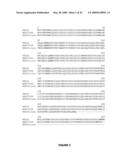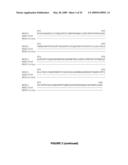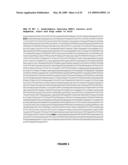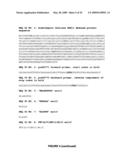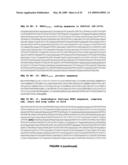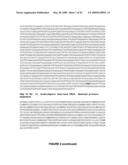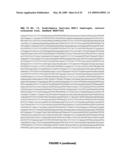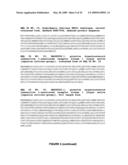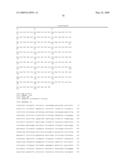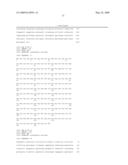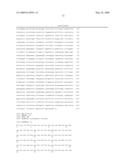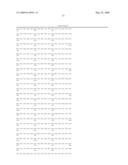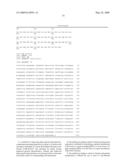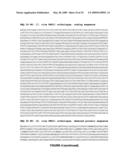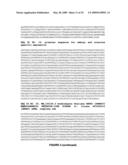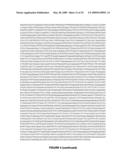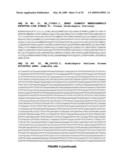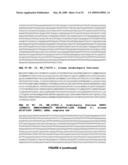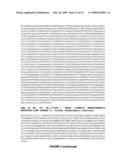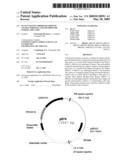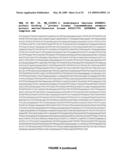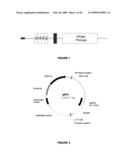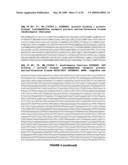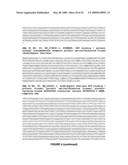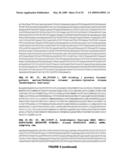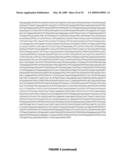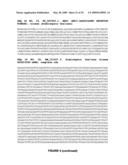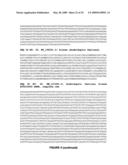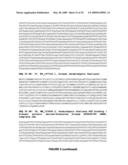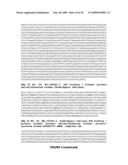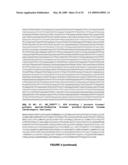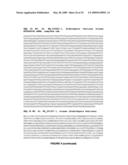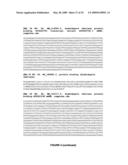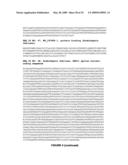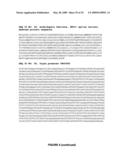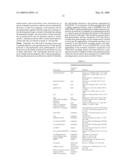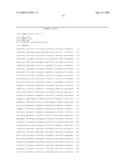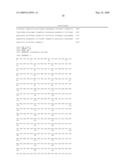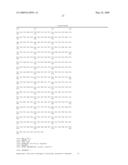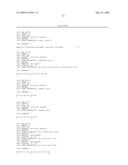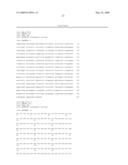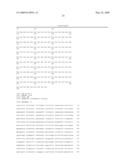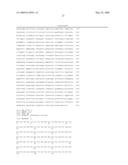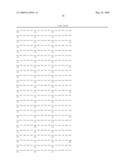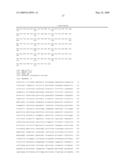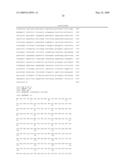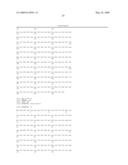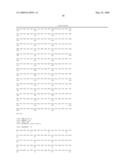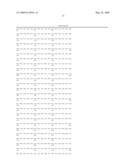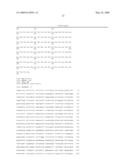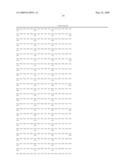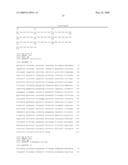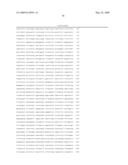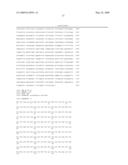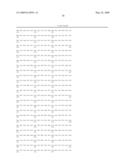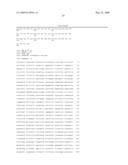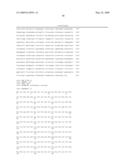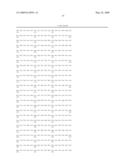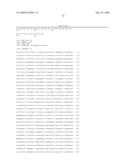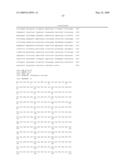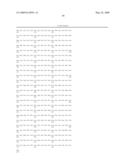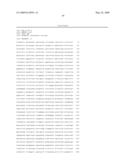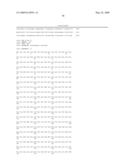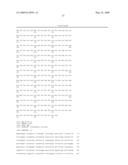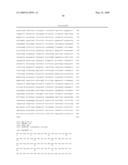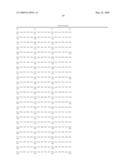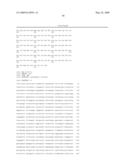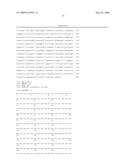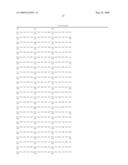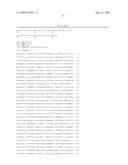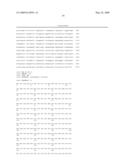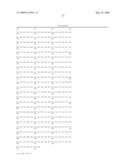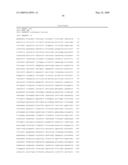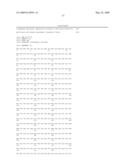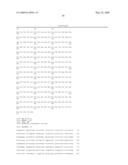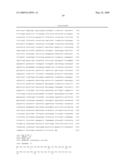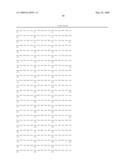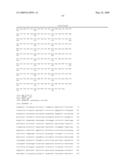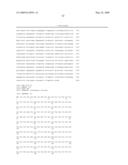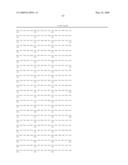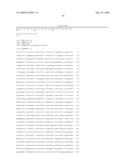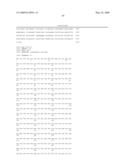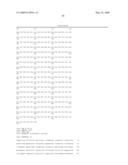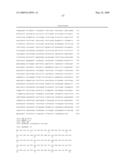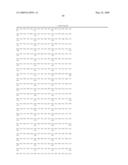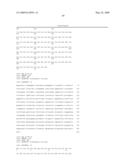Patent application title: Plants having improved growth characteristics and method for making the same
Inventors:
Christophe Reuzeau (La Chapelle Gonaguet, FR)
Christophe Reuzeau (La Chapelle Gonaguet, FR)
Assignees:
CropDesign N.V.
IPC8 Class: AC12N1511FI
USPC Class:
800287
Class name: Multicellular living organisms and unmodified parts thereof and related processes method of introducing a polynucleotide molecule into or rearrangement of genetic material within a plant or plant part the polynucleotide contains a tissue, organ, or cell specific promoter
Publication date: 2009-05-28
Patent application number: 20090138991
Claims:
1. A method for improving plant growth characteristics, comprising
increasing expression in a plant of a nucleic acid encoding a subfamily
II Leucine Rich Repeat Receptor-Like Protein (LRR-II-RLP) and selecting
for plants having improved growth characteristics, wherein said improved
plant growth characteristics are increased yield or increased seed yield,
relative to corresponding wild type plants.
2. The method according to claim 1, wherein said increased expression is effected by introducing a genetic modification in the locus of a gene encoding RKS11 or in the locus of a gene encoding RKS4 or in the locus of a gene encoding an LRR-II-RLP protein.
3. The method according to claim 2, wherein said genetic modification is effected by one or more of: site-directed mutagenesis, transposon mutagenesis, directed evolution, homologous recombination, TILLING and T-DNA activation.
4. A method for improving plant growth characteristics, comprising introducing and expressing in a plant of an isolated LRR-II-RLP encoding nucleic acid.
5. The method according to claim 4, wherein said improved plant growth characteristics are increased yield or increased seed yield, relative to corresponding wild type plants.
6. The method according to claim 4 wherein said LRR-II-RLP encoding nucleic acid or variant thereof is overexpressed in the plant.
7. The method according to claim 4, wherein said LRR-II-RLP encoding nucleic acid is of plant origin, from a dicotyledonous plant, from the family Brassicaceae, or from Arabidopsis thaliana.
8. The method according to claim 4, wherein said LRR-II-RLP encoding nucleic acid encodes a polypeptide as represented by SEQ ID NO: 10 or SEQ ID NO: 14.
9. The method according to claim 4, wherein said LRR-II-RLP encoding nucleic acid is operably linked to a seed-specific promoter.
10. The method according to claim 9, wherein said seed-specific promoter is as presented by SEQ ID NO: 19.
11. The method according to claim 1, wherein said increased seed yield is selected from any one or more of (i) increased seed weight, (ii) increased number of (filled) seeds, (iii) increased harvest index and (iv) improved metabolite composition.
12. Plants obtainable by the method according to claim 1.
13. A construct comprising:i. an LRR-II-RLP encoding nucleic acid;ii. one or more control sequence capable of driving expression of the nucleic acid sequence of (i); andiii. a transcription termination sequence.
14. The construct according to claim 13, wherein said promoter is a seed-specific promoter.
15. The construct according to claim 14, wherein said promoter is as represented by SEQ ID NO: 19.
16. A plant transformed with the construct according to claim 13.
17. A method for the production of a transgenic plant having modified growth characteristics, increased yield, or increased seed yield relative to corresponding wild type plants, wherein the method comprises:i. introducing and expressing in a plant cell an LRR-II-RLP encoding nucleic acid or variant thereof; andii. cultivating the plant cell under conditions promoting plant growth and development.
18. A transgenic plant having improved growth characteristics or increased yield, relative to corresponding wild type plants, resulting from an LRR-II-RLP encoding nucleic acid or variant thereof introduced into said plant.
19. The transgenic plant according to claim 12, wherein said plant is a crop plant a monocotyledonous plant, or a cereal.
20. Harvestable parts of the plant according to claim 12, and products directly derived thereof.
21. The harvestable parts according to claim 20, wherein said harvestable parts are seeds.
22. (canceled)
23. The transgenic plant according to claim 18, wherein said increased yield is increased seed yield selected from one or more of the following: increased number of (filled) seeds, increased seed weight, increased harvest index and improved metabolite composition.
24. A method of selecting plants having altered growth characteristics comprising using an LRR-II-RLP encoding nucleic acid or an LRR-II-RLP polypeptide as a molecular marker.
25. An isolated LRR-II-RLP protein selected from the group consisting of:a) a polypeptide without kinase activity comprising (i) a signal sequence, (ii) a Leucine zipper motif with 2 or 3 Leu residues separated from each other by 6 other amino acids, (iii) a motif with 2 conserved cysteine residues, (iv) 4 Leucine Rich Repeat units of each approximately 23 amino acid residues, (v) a domain enriched in serine and proline residues, (vi) a single transmembrane domain, and (vii) part or the whole of a RELH-domain;b) a subfamily II Leucine Rich Repeat Receptor-Like Kinase lacking substantially the whole kinase domain;c) the polypeptide as given in SEQ ID NO 10; andd) a polypeptide with an amino acid sequence which has at least 90% sequence identity to any one or more of the amino acid sequence as given in SEQ ID NO 10,provided that the LRR-II-RLP protein is not the protein as represented by SEQ ID NO: 14.
26. An isolated nucleic acid selected from the group consisting of:i. a nucleic acid sequence represented by SEQ ID NO: 9, or the complement strand thereof;ii. a nucleic acid sequence encoding the amino acid sequence represented by SEQ ID NO: 10;iii. a nucleic acid sequence capable of hybridising under stringent conditions with a nucleic acid sequence of (i) or (ii) above, which hybridising sequence encodes a LRR-II-RLP protein;iv. a nucleic acid encoding a protein as defined in claim 25; andv. a portion of a nucleic acid sequence according to any of (i) to (iii) above, which portion encodes a LRR-II-RLP protein,provided that the LRR-II-RLP encoding nucleic acid is not as represented by SEQ ID NO: 13 or does not encode the protein of SEQ ID NO: 14.
27. The transgenic plant according to claim 12, wherein said plant is soybean, sunflower, canola, alfalfa, rapeseed, cotton, sugar cane, rice, maize, wheat, barley, millet, rye oats or sorghum.
Description:
[0001]The present invention relates generally to the field of molecular
biology and concerns a method for modifying plant growth characteristics.
More specifically, the present invention concerns a method for improving
plant growth characteristics, in particular yield, by increasing
expression in a plant of at least part of a Leucine Rich Repeat
Receptor-Like Kinase (RKS11 or RKS4 or an orthologue thereof). The
present invention also concerns plants having increased expression of at
least part of a Leucine Rich Repeat Receptor-Like Kinase (RKS11 or RKS4
or an orthologue thereof), which plants have improved growth
characteristics relative to corresponding wild type plants. The invention
also provides constructs useful in the methods of the invention.
[0002]The ever-increasing world population and the dwindling supply of arable land available for agriculture fuel research towards improving the efficiency of agriculture. Conventional means for crop and horticultural improvements utilise selective breeding techniques to identify plants having desirable characteristics. However, such selective breeding techniques have several drawbacks, namely that these techniques are typically labour intensive and result in plants that often contain heterogeneous genetic components (including undesirable traits) that may not always result in the desirable trait being passed on from parent plants. Advances in molecular biology have allowed mankind to modify the germplasm of animals and plants. Genetic engineering of plants entails the isolation and manipulation of genetic material (typically in the form of DNA or RNA) and the subsequent introduction of that genetic material into a plant. Such technology has the capacity to deliver crops or plants having various improved economic, agronomic or horticultural traits.
[0003]A trait of particular economic interest is yield, and in the case of many plants seed yield. Yield is normally defined as the measurable produce of economic value from a crop. This may be defined in terms of quantity and/or quality. Yield is directly dependent on several factors, for example, the number and size of the organs, plant architecture (for example, the number of branches), seed production and more. Root development, nutrient uptake and stress tolerance may also be important factors in determining yield. Optimizing one of the above-mentioned factors may therefore contribute to increasing crop yield. Plant seeds are an important source of human and animal nutrition. Crops such as, corn, rice, wheat, canola and soy bean account for over half of the total human caloric intake, whether through direct consumption of the seeds themselves or through consumption of meat products raised on processed seeds. They are also a source of sugars, oils and many kinds of metabolites used in industrial processes. Seeds contain an embryo, the source of new shoots and roots after germination, and an endosperm, the source of nutrients for embryo growth, during germination and early growth of seedlings. The development of a seed involves many genes, and requires the transfer of metabolites from roots, leaves and stems into the growing seed. The endosperm, in particular, assimilates the metabolic precursors of carbohydrates, oils and proteins and synthesizes them into storage macromolecules to fill out the grain. The ability to increase plant seed yield, whether through seed number, seed biomass, seed development, seed filling, or any other seed-related trait would have many applications in agriculture, and even many non-agricultural uses such as in the biotechnological production of substances such as pharmaceuticals, antibodies or vaccines.
[0004]Receptor like kinases (RLKs) are involved in transmission of extracellular signals into the cell. The RLK proteins have a modular structure, starting from the N-terminus with a secretion signal that gets processed, an extracellular domain, a single transmembrane domain and a cytoplasmic kinase domain. Receptor like kinases are postulated to form homodimers or heterodimers of two related kinases, similar as for animal receptor kinases (Torii, Curr. Opin. Plant Biol. 3, 361-367, 2000). Animal receptor-like kinases mostly have tyrosine kinase activity, whereas plant RLKs all have Ser/Thr kinase specificity, or may sometimes have a dual specificity. In animals, most of the RLKs act as growth factor receptors, whereas plant receptor like kinases may function in various processes, including development, hormone perception or pathogen responses. An overview of developmental functions of plant receptor like kinases such as meristem development, pollen-pistil interactions, hormone signalling, gametophyte development, cell morphogenesis and differentiation, organ shape, organ abscission and somatic embryogenesis is given by Becraft (Annu. Rev. Cell Dev. Biol., 18, 163-192, 2002).
[0005]Alternatively, receptor-like kinases may be grouped according to the structure of their extracellular domain (Shiu and Bleecker, Proc. Natl. Acad. Sci. USA 98, 10763-10768, 2001). The largest group was that of the Leucine Rich Repeat (LRR) containing RLKs; which may be split up in 13 subgroups (LRR I to LRR XIII) based on the organisation of the LRR domains in the extracellular part of the RLK. The LRR units may be present in varying numbers and may be arranged in continuous or interrupted repeats.
[0006]RKS (Receptor Kinase SERK-like) proteins have a modular structure that corresponds to the LRR II subfamily of the LRR-RLK. The domain organisation is, from N-terminus to C-terminus: a signal sequence, a number of leucine zipper motifs, a conserved pair of cysteines, 4 or 5 LRR domains followed by another conserved pair of cysteines, a transmembrane domain and the intracellular kinase domain. The Arabidopsis RKS genes form a gene family of 14 members, and are related to SERK (Somatic Embryogenesis Receptor Kinase). SERK was first characterised in carrot (Schmidt et al., Development 124, 2049-2069, 1997) and is specifically expressed in embryogenic cells. SERK homologues were also found in other plant species (Arabidopsis (Hecht et al., Plant Physiol. 127, 803-816, 2001) or Helianthus, and in monocotyledonous plants such as maize or Dactylis glomerata (Somleva et al., Plant Cell Rep. 19, 718-726, 2000)). Overexpression of SERK in Arabidopsis increased the embryogenic potential of Arabidopsis cultures, confirming the postulated function of increasing embryogenic competence. In Arabidopsis, AtSERK1 is only expressed in developing ovules (in particular in the embryo sac), and after fertilization in the endosperm and embryo, up to the heart stage. Transgenic plants with constitutive expression of AtSERK1 were reported to have no altered plant phenotype (Hecht et al., 2001). The characterisation of Medicago truncatula MtSERK1 suggests that, at least in legumes, SERK may play a broader role in development than embryogenesis alone (Nolan et al. Plant Physiol. 133, 218-230, 2003).
[0007]WO 2004/007712 describes and characterises a number of Arabidopsis RKS genes. It was postulated that modification of expression of the RKS genes would cause a modification of the brassinosteroid-signalling pathway. The data show that, depending on the specific RKS gene and the kind of expression (up- or downregulation of expression compared to wild type), results in various phenotypes. For example, RKS4 and RKS 10 are reported to stimulate cell division. Overexpression of the RKS4 gene resulted in increased cell division and an altered plant phenotype, whereas modulation of RKS10 did change the cell number, but not plant or organ size. Overexpression of RKS10 also caused the formation of many generative meristems that did not end up in normally developed flowers. Both overexpression and downregulated expression of RKS10 had a strong negative effect on pollen formation. Root length was negatively affected by overexpressing RKS10, while initiation and outgrowth of lateral roots was promoted. The same effects on root growth may be obtained by suppressing RKS1 expression. Also overexpression of the RKS3, RKS4 or RKS6 genes had positive effects on root length. Increased apical shoot meristem formation and outgrowth was obtained by overexpressing RKS0 but also by downregulating expression of RKS3, RKS4, RKS8 or RKS10. RKS4 overexpression was reported to result in larger seed size, but did not result in higher seed yield; no functional analysis was made of the RKS11 gene. In this disclosure however, only full length RKS proteins were studied.
[0008]It is known in the art that expression of truncated receptor like kinases typically result in loss-of-function phenotypes. For example, Shpak et al. (Plant Cell 15, 1095-1110, 2003) describe a truncated ERECTA protein (a LRR-RLK of the LRR XIII subfamily) that lacks the cytoplasmic kinase domain. ERECTA regulates organ shape and inflorescence architecture. Transgenic plants expressing the truncated ERECTA protein had compact inflorescences and short blunt siliques; this phenotype is characteristic for loss-of-function erecta mutant plants. CLAVATA, another LRR-RLK but classified in subfamily XI, controls shoot and floral meristems in plants. Two mutants of clavata1, clv1-6 and clv1-7, lack the entire kinase domain, yet the mutant phenotype is rather mild compared to other mutations within the kinase domain (Clark et al. Cell 89, 575-585, 1997; Torii, 2000).
[0009]It has now surprisingly been found that increasing expression of at least part of a Leucine Rich Repeat Receptor-Like Kinase (LRR-RLK) of subfamily II (preferably RKS11 or RKS4 or an orthologue of these) gives plants having improved growth characteristics relative to control plants.
[0010]Therefore, the invention provides a method for improving the growth characteristics of a plant, comprising increasing expression of a subfamily II LRR-RLK (preferably RKS11 or RKS4 or an orthologue thereof), or of a part thereof (which parts are hereafter named LRR-II-RLP, for subfamily II Leucine Rich Repeat Receptor-Like Proteins); provided that the improved growth characteristics do not encompass increased seed size upon increased expression of RKS4 (SEQ ID NO: 12).
[0011]The choice of suitable control plants is a routine part of an experimental set-up and may include corresponding wild type plants or corresponding plants without the gene of interest. The control plant is typically of the same plant species or even of the same variety as the plant to be compared. The control plant may also be a nullizygote of the plant to be compared. A "control plant" as used herein refers not only to whole plants, but also to plant parts, including seeds and seed parts.
[0012]A preferred method for increasing expression of a nucleic acid encoding a subfamily II LRR-RLK or an LRR-II-RLP is by introducing and expressing in a plant an isolated nucleic acid encoding a subfamily II LRR-RLK or an LRR-II-RLP.
[0013]The nucleic acid to be introduced into a plant (and therefore useful in performing the methods of the invention) is any nucleic acid encoding a subfamily II LRR-RLK, but preferably RKS11 or RKS4 or an orthologue of one of these, more preferably the nucleic acid encodes the type of LRR-II-RLP which is described below.
[0014]The term "RKS11" or "RKS11 polypeptide" as used herein refers to the polypeptide as represented by SEQ ID NO: 2. The term "RKS4" or "RKS4 polypeptide" as used herein refers to the polypeptide as represented by SEQ ID NO: 12. Both the RKS11 and RKS4 polypeptide comprise the following domains (from N-terminus to C-terminus): (i) a signal sequence, (ii) a Leucine zipper motif with 3 Leu residues separated from each other by 6 other amino acids, (iii) a motif with 2 conserved Cysteine residues, (iv) 4 Leucine Rich Repeat units of each approximately 23 amino acid residues, (v) a domain enriched in serine and proline residues, (vi) a single transmembrane domain, and (vii) a kinase domain, flanked at both sides by a domain of unknown function.
[0015]The term "domain" means a set of amino acids conserved at specific positions along an alignment of sequences (performed as described below) of evolutionarily related proteins. While amino acids at other positions can vary between homologues, amino acids that are highly conserved at specific positions indicate amino acids that are essential in the structure, the stability, or the activity of a protein. Because they are identified by their high degree of conservation in aligned sequences of a family of protein homologues, they can be used as identifiers to determine if a polypeptide with a newly determined sequence belongs to a previously identified polypeptide family.
[0016]The signal peptide of RKS11 is predicted to be 31 amino acids long. The motif with the conserved cysteine residues in RKS11 is described in Dievart & Clark (2003), the Cys residues are located at positions 66 and 73 in SEQ ID NO: 2. The LRR domains are tandemly placed, from amino acid 102 to 196. In addition, the RKS11 protein comprises a stretch of amino acids is found that consists for 34% of proline and serine between the fourth LRR domain and the TM region. The transmembrane (TM) region is predicted to span amino acids 240 to 262. The kinase domain corresponds to both the Pfam PF00069 and the Pfam PF07714 type of kinase domains, which may be an indication for dual specificity activity and comprises amino acids 303 to 572. The N-terminal extremity of the kinase catalytic domain comprises a glycine-rich stretch of residues in the vicinity of a lysine residue, which has been shown to be involved in ATP binding. The central part of the kinase catalytic domain has a conserved Aspartic acid residue, which is important for the kinase activity of the RKS11 protein. Between the transmembrane domain and the kinase domain, a domain with unknown function is found (RELH-domain), characterised by the presence of a "RELHXXTDG" motif (SEQ ID NO: 5). The X may represent any amino acid, preferably the first X is a hydrophobic non-polar amino acid, more preferably a Valine or Alanine. C-terminal of the kinase domain, another domain of unknown function is found (EGD-domain), starting with a "EGDGLA" motif (SEQ ID NO: 6) and ending with a "ELSGPR" motif (SEQ ID NO: 7)
[0017]RKS4 (SEQ ID NO: 12) is a paralogue of RKS11, and is highly homologous to RKS11. By aligning the sequences of the RKS11 and RKS4 proteins, the corresponding Leu zipper motif, the conserved cysteine residues, the LRR, transmembrane and kinase domains in RKS4 may easily be identified. RKS11 and RKS4 furthermore share a FNVAGNPLIC motif (SEQ ID NO: 8) and the last 20 amino acids of both proteins comprise 7 Asp or Glu residues. RKS4 and RKS11 differ from each other for example in the Leu zipper motif; the RKS11 protein comprises 3 Leu residues in the zipper motif, whereas RKS4 has 2 Leu residues. Furthermore, the motifs with the conserved cysteines differ in two residues between both proteins.
[0018]The term "LRR-II-RLP" as used herein encompasses truncated forms of Leucine-rich repeat receptor-like kinases (LRR-RLK) belonging to the subfamily II (as defined for Arabidopsis in Shiu and Bleeker, 2001, or listed in Dievart and Clark, Curr. Opin. Plant Biol. 6, 507-516, 2003), wherein the truncations are located in the kinase domain. The term "LRR-II-RLP" also encompasses subfamily II LRR-RLK kinases that are mutated in the kinase domain, which mutants have at least reduced kinase activity compared to the wild type protein, but preferably lack kinase activity. Since the extracellular domains of subfamily II LRR-RLKs are very similar in structure, any subfamily II LRR-RLK may be useful in the methods of the present invention; preferably, such LRR-RLK is RKS11 (At4g30520) or RKS4 (At2g23950) from Arabidopsis, or an orthologue of one of these; more preferably, the LRR-RLK is the Arabidopsis RKS11 as represented by SEQ ID NO: 2. The term LRR-II-RLP furthermore encompasses truncated forms of subfamily II LRR-RLK kinases that exist in nature, and in which no active kinase domain is present. Examples of such natural truncated receptor-like kinases are SEQ ID NO: 14 (GenBank accession BX827036, a truncated homologue of RKS11), or the rice sequence of SEQ ID NO: 15 (BAD68256), which is a truncated version of SEQ ID NO: 16 (BAD68255). Preferably, the LRR-II-RLP protein useful in the methods of the present invention is a truncated form of a subfamily II Leucine-rich repeat receptor-like kinases (LRR-RLK), with a deletion in the C-terminal half of the protein that at least reduces, preferably substantially inactivates the kinase activity of the receptor kinase, but more preferably with a deletion that consists of substantially the complete kinase domain. Furthermore preferably, the LRR-II-RLP protein is a truncated form of RKS11 or RKS4 or of an orthologue thereof; most preferably, the LRR-II-RLP is RKS11trunc as represented by SEQ ID NO: 10 or the sequence represented by SEQ ID NO: 14.
[0019]The subfamily II of LRR-RLK proteins not only encompasses the Arabidopsis proteins listed in Dievart and Clark (2003), but also homologues thereof, provided that these homologues fall within the subfamily II of LRR-RLK as defined by Shiu and Bleeker (2001). Preferred homologues are orthologues and paralogues of RKS11 (SEQ ID NO: 2) and RKS4 (SEQ ID NO: 12).
[0020]Paralogues are genes within the same species that have originated through duplication of an ancestral gene and orthologues are genes from different organisms that have originated through speciation. Orthologues and paralogues may easily be found by performing a so-called reciprocal blast search. This may be done by a first BLAST involving submitting a query sequence (for example, SEQ ID NO: 1 or SEQ ID NO: 2) for a BLAST search against any sequence database, such as the publicly available NCBI database. BLASTN or TBLASTX (using standard default values) may be used when starting from a nucleotide sequence and BLASTP or TBLASTN (using standard default values) may be used when starting from a protein sequence. The BLAST results may optionally be filtered. The full-length sequences of either the filtered results or non-filtered results are then submitted to a second BLAST search (BLAST back) against sequences from the organism from which the query sequence is derived (where the query sequence is SEQ ID NO: 1 or SEQ ID NO: 2 the second BLAST would therefore be against Arabidopsis sequences). The results of the first and second BLAST searches are then compared. A paralogue is identified if a high-ranking hit from the first blast is from the same species as from which the query sequence is derived, a BLAST back then ideally results in the query sequence as highest hit; an orthologue is identified if a high-ranking hit in the first BLAST is not from the same species as from which the query sequence is derived and preferably results upon BLAST back in the query sequence among the highest hits. Preferred orthologues are orthologues of RKS11 (SEQ ID NO: 2), RKS4 (SEQ ID NO: 12) or of the truncated form of RKS11 (SEQ ID NO: 10). High-ranking hits are those having a low E-value. The lower the E-value, the more significant the score (or in other words the lower the chance that the hit was found by chance). Computation of the E-value is well known in the art. In the case of large families, ClustalW may be used, followed by a neighbour joining tree, to help visualize clustering of related genes and to identify orthologues and paralogues. In addition to E-values, comparisons are also scored by percentage identity. Percentage identity refers to the number of identical nucleotides (or amino acids) between the two compared nucleic acid (or polypeptide) sequences over a particular length.
[0021]Orthologues of RKS11 or RKS4 receptor-like kinases preferably comprise a signal peptide, the Leu zipper motif and the motif with two conserved cysteine residues, the LRR domain consisting of four LRR repeats, a transmembrane domain and preferably also a kinase domain corresponding to the Pfam PF00069 and/or the Pfam PF07714 type of kinase domains as defined in the Pfam database. The prediction of signal peptide sequences and transmembrane domains is known in the art, and the LRR and kinase domains defined above are highly conserved. Also the conserved cysteine residues and the Leucine zipper motif may be readily identified by comparison with the SEQ ID NO: 2 or SEQ ID NO: 12, thereby allowing a person skilled in the art to readily identify orthologous sequences falling within the definition above. Preferably, the orthologues useful in the present invention have at least 59% sequence identity to SEQ ID NO: 2 when compared using the Needleman and Wunsch algorithm with a gap-opening penalty of 11 and a gap-extension penalty of 1. Furthermore, the orthologues useful in the present invention preferably comprise a domain enriched in Serine and/or Proline between the last LRR domain and the transmembrane domain (corresponding to amino acids 197 to 240 in SEQ ID NO: 2), which Ser/Pro enriched-domain comprises at least 23% Serine and/or Proline residues and comprises a FNV(A/V)GNP(UM)IC motif (SEQ ID NO: 8). Further preferably, the domain of unknown function located N-terminal of the kinase domain comprises the RELHXXTDG motif as defined above. Furthermore preferably, the orthologues useful in the present invention comprise an EGD domain that is at least 60 amino acids long.
[0022]An example of a plant-derived polypeptide falling under the definition of an "RKS11 or an orthologue thereof" is represented by SEQ ID NO: 18 (Oryza sativa, GenBank accession BAD10034).
[0023]The Table below shows the percentage sequence identity and similarity of polypeptide sequences homologous to RKS11 compared to the amino acid sequence represented by SEQ ID NO: 2, based on overall global sequence alignment. The percentage identity and similarity was calculated using the Needleman and Wunsch algorithm with a gap-opening penalty of 11 and a gap-extension penalty of 1.
TABLE-US-00001 TABLE 1 Homology of RKS4 and RKS11 protein sequences with SEQ ID NO: 2 based on overall global sequence alignment RKS homologue SEQ ID NO: % identity/% similarity Arabidopsis RKS4 SEQ ID NO: 12 82.4/89.7 Oryza sativa RKS11 SEQ ID NO: 18 59.9/71.7
[0024]According to a preferred feature of the invention, the orthologue has at least 59% sequence identity to the amino acid sequence represented by SEQ ID NO: 2. Whether a polypeptide has at least 59% identity to the amino acid represented by SEQ ID NO: 2 may readily be established by sequence alignment. Methods for the alignment of sequences for comparison are well known in the art, such methods include GAP, BESTFIT, BLAST, FASTA and TFASTA. GAP uses the algorithm of Needleman and Wunsch (J. Mol. Biol. 48: 443-453, 1970) to find the alignment of two complete sequences that maximises the number of matches and minimises the number of gaps. The BLAST algorithm calculates percent sequence identity and performs a statistical analysis of the similarity between the two sequences. The software for performing BLAST analysis is publicly available through the National Centre for Biotechnology Information. An RKS11 polypeptide or an orthologue thereof having at least 59% identity to the amino acid represented by SEQ ID NO: 2 may readily be identified by aligning a query sequence (preferably a protein sequence (full length or the mature form without secretion signal sequence)) with known RKS11 orthologous protein sequences. Also for an RKS4 polypeptide, the sequence identity may be established by aligning a query sequence with known RKS4 orthologous protein sequences. Such homologues may readily be identified using, for example, the ClustalW multiple sequence alignment algorithm (version 1.83) available at http://dustalw.genome.jp/sit-bin/nph-ClustalW, with the default pairwise alignment parameters, and a scoring method in percentage. Minor manual editing may be performed to optimise alignment between conserved motifs, as would be apparent to a person skilled in the art. However, when searching for suitable LRR-II-RLP proteins or for identifying suitable subfamily II LRR-RLKs for generating such LRR-II-RLPs, it is preferred that only the extracellular domain of the protein (i.e. N-terminal of the transmembrane domain) be used for determining the sequence homology. Preferred homologues are those with the highest sequence identity to SEQ ID NO: 10.
[0025]Suitable mutants that fall in the scope of LRR-II-RLPs encompass those mutants in which the kinase activity is reduced (compared to the wild type protein) or completely inactivated. It is well known in the art how to introduce mutations such that the transphosphorylation or autophosphorylation is inhibited. Lack of transphosphorylation or autophosphorylation results in unstable protein complexes such that ligands cannot bind and no signalling is possible. For example, mutations may be introduced in or around the active site of the kinase domain for reducing or inhibiting kinase activity, other mutations may also be of use, for example in the ATP binding site whereby ATP binding is prevented, or in case of autophosphorylation, by altering the amino acids that normally get phosphorylated.
[0026]To determine the kinase activity of receptor like kinases, several assays are available and known in the art (for example Current Protocols in Molecular Biology, Volumes 1 and 2, Ausubel et al. (1994), Current Protocols). In brief, a kinase assay generally involves (1) bringing the kinase protein into contact with a substrate polypeptide containing the target site to be phosphorylated; (2) allowing phosphorylation of the target site in an appropriate kinase buffer under appropriate conditions; (3) separating phosphorylated products from non-phosphorylated substrate after a suitable reaction period. The presence or absence of kinase activity is determined by the presence or absence of a phosphorylated target. In addition, quantitative measurements can be performed. Purified receptor like kinase, or cell extracts containing or enriched in the receptor like kinase could be used as source for the kinase protein. Alternatively, the approach of Zhao et al. (Plant Mol. Biol. 26, 791-803, 1994) could be used, where the cytoplasmic domain of a rice receptor like kinase was expressed in Escherichia coli and assayed for kinase activity. As a substrate, small peptides are particularly well suited. The peptide must comprise one or more serine, threonine or tyrosine residues in a phosphorylation site motif. A compilation of phosphorylation sites can be found in Biochimica et Biophysica Acta 1314, 191-225, (1996). In addition, the peptide substrates may advantageously have a net positive charge to facilitate binding to phosphocellulose filters, (allowing to separate the phosphorylated from non-phosphorylated peptides and to detect the phosphorylated peptides). If a phosphorylation site motif is not known, a general tyrosine kinase substrate can be used. For example, "Src-related peptide" (RRLIEDAEYAARG) is a substrate for many receptor and non-receptor tyrosine kinases). To determine the kinetic parameters for phosphorylation of the synthetic peptide, a range of peptide concentrations is required. For initial reactions, a peptide concentration of 0.7-1.5 mM could be used. For each kinase enzyme, it is important to determine the optimal buffer, ionic strength, and pH for activity. A standard 5× Kinase Buffer generally contains 5 mg/ml BSA (Bovine Serum Albumin preventing kinase adsorption to the assay tube), 150 mM Tris-Cl (pH 7.5), 100 mM MgCl2. Divalent cations are required for most tyrosine kinases, although some tyrosine kinases (for example, insulin-, IGF-1-, and PDGF receptor kinases) require MnCl2 instead of MgCl2 (or in addition to MgCl2). The optimal concentrations of divalent cations must be determined empirically for each protein kinase. A commonly used donor for the phosphoryl group is radio-labelled [gamma-32P]ATP (normally at 0.2 mM final concentration). The amount of 32P incorporated in the peptides may be determined by measuring activity on the nitrocellulose dry pads in a scintillation counter.
[0027]Furthermore, the activity of an LRR-II-RLP polypeptide may be assayed by expressing the LRR-II-RLP polypeptide under control of a rice seed-specific promoter in rice plants, and in particular in the rice variety Nipponbare, which results in plants with increased yield compared to corresponding control plants. This increase in yield may for example be measured as one or more of an increase in number of filled seeds, in total weight of seeds, in harvest index and/or increased levels of amino acids in seeds.
[0028]Mutants (and also homologues) of a protein encompass peptides, oligopeptides, polypeptides, proteins and enzymes having amino acid substitutions, deletions and/or insertions relative to the unmodified protein in question and (in case of homologues, but also for certain mutants) having similar biological and functional activity as the unmodified protein from which they are derived. To produce such homologues, amino acids of the protein may be replaced by other amino acids having similar properties (such as similar hydrophobicity, hydrophilicity, antigenicity, propensity to form or break α-helical structures or β-sheet structures). Conservative substitution tables are well known in the art (see for example Creighton (1984) Proteins. W.H. Freeman and Company and Table 2).
TABLE-US-00002 TABLE 2 Examples of conserved amino acid substitutions Residue Conservative Substitutions Ala Ser Arg Lys Asn Gln; His Asp Glu Gln Asn Cys Ser Glu Asp Gly Pro His Asn; Gln Ile Leu, Val Leu Ile; Val Lys Arg; Gln Met Leu; Ile Phe Met; Leu; Tyr Ser Thr; Gly Thr Ser; Val Trp Tyr Tyr Trp; Phe Val Ile; Leu
[0029]A mutant may be in the form of a "substitutional variant" of a protein, i.e. where at least one residue in an amino acid sequence has been removed and a different residue inserted in its place. Amino acid substitutions are typically of single residues, but may be clustered depending upon functional constraints placed upon the polypeptide; insertions will usually be of the order of about 1 to 10 amino acid residues. Preferably, amino acid substitutions comprise conservative amino acid substitutions, unless an alteration of functional or structural properties of the protein is intended.
[0030]A mutant may also be in the form of an "insertional variant" of a protein, i.e. where one or more amino acid residues are introduced into a predetermined site in a protein. Insertions may comprise amino-terminal and/or carboxy-terminal fusions as well as intra-sequence insertions of single or multiple amino acids. Generally, insertions within the amino acid sequence will be smaller than amino- or carboxy-terminal fusions, of the order of about 1 to 10 residues. Examples of amino- or carboxy-terminal fusion proteins or peptides include the binding domain or activation domain of a transcriptional activator as used in the yeast two-hybrid system, phage coat proteins, (histidine)6-tag, glutathione S-transferase-tag, protein A, maltose-binding protein, dihydrofolate reductase, Tag-100 epitope, c-myc epitope, FLAG®-epitope, lacZ, CMP (calmodulin-binding peptide), HA epitope, protein C epitope and VSV epitope. In particular, useful LRR-II-RLP polypeptides may be created by inserting one or more Leucine Rich Repeat domain(s) in the extracellular domain, or by fusing a transmembrane domain at the C-terminus of naturally occurring proteins that resemble the extracellular domain of subfamily II LRR-RLKs, preferably of RKS11, RKS4 or orthologues thereof (such as the proteins encoded in At3g43740 (SEQ ID NO: 44) or At5g21090 (SEQ ID NO: 46)).
[0031]Mutants in the form of "deletion variants" of a protein are characterised by the removal of one or more amino acids from a protein. Preferred deletion mutants are those in which part of the kinase domain is deleted, such that the remaining part has at least reduced transphosphorylation or autophosphorylation activity, preferably complete loss of activity. More preferred mutants are those in which substantially all of the kinase domain is deleted. Furthermore preferred mutants are those which, upon alignment with SEQ ID NO: 10, lack substantially the same part of the kinase domain. Most preferably, the mutant is RKS11trunc as represented by SEQ ID NO: 10.
[0032]Amino acid variants of a protein may readily be made using peptide synthetic techniques well known in the art, such as solid phase peptide synthesis and the like, or by recombinant DNA manipulations. Methods for the manipulation of DNA sequences to produce substitution, insertion or deletion variants of a protein are well known in the art. For example, techniques for making substitution mutations at predetermined sites in DNA are well known to those skilled in the art and include M13 mutagenesis, T7-Gen in vitro mutagenesis (USB, Cleveland, Ohio), QuickChange Site Directed mutagenesis (Stratagene, San Diego, Calif.), PCR-mediated site-directed mutagenesis or other step-directed mutagenesis protocols. All these techniques may be used for generating a LRR-II-RLP suitable for the methods of the present invention.
[0033]The RKS11 or RKS4 polypeptide may be a derivative of SEQ ID NO: 2, respectively SEQ ID NO: 12. "Derivatives" include peptides, oligopeptides, polypeptides which may, compared to the amino acid sequence of the naturally-occurring form of the protein, such as the one presented in SEQ ID NO: 2 or SEQ ID NO: 12, comprise substitutions of amino acids with non-naturally occurring amino acid residues, or additions of non-naturally occurring amino acid residues. Derivatives of SEQ ID NO: 10, SEQ ID NO: 14 and SEQ ID NO: 18 are further examples which may be suitable for generating an LRR-II-RLP useful in the methods of the invention.
[0034]"Derivatives" of a protein also encompass peptides, oligopeptides, polypeptides which may comprise naturally occurring altered (glycosylated, acylated, ubiquinated, prenylated, phosphorylated, myristoylated, sulphated etc) or non-naturally altered amino acid residues compared to the amino acid sequence of a naturally-occurring form of the polypeptide. A derivative may also comprise one or more non-amino acid substituents or additions compared to the amino acid sequence from which it is derived, for example a reporter molecule or other ligand, covalently or noncovalently bound to the amino acid sequence, such as a reporter molecule which is bound to facilitate its detection, and non-naturally occurring amino acid residues relative to the amino acid sequence of a naturally-occurring protein.
[0035]It is to be understood that sequences falling under the definition of "RKS11 polypeptide or orthologue thereof" or "RKS4 polypeptide or orthologue thereof" are not to be limited to the sequences represented by SEQ ID NO: 2, SEQ ID NO: 12 and SEQ ID NO: 18, but that any polypeptide meeting the criteria of comprising (i) a signal sequence, (ii) a Leucine zipper motif with 2 or 3 Leu residues separated from each other by 6 other amino acids, (iii) a motif with 2 conserved cysteine residues, (iv) 4 Leucine Rich Repeat units of each approximately 23 amino acid residues, (v) a domain enriched in serine and proline residues, (vi) a single transmembrane domain, and (vii) a kinase domain, flanked at both sides by a domain of unknown function (RELH- and EGD-domains); and furthermore being orthologues of RKS11 as represented by SEQ ID NO: 2 may be suitable for generating a LRR-II-RLP protein useful in the methods of the invention.
[0036]The LRR-II-RLP protein of SEQ ID NO: 10 was previously unknown. The present invention therefore provides a novel isolated LRR-II-RLP protein selected from the group consisting of: [0037]a) a polypeptide without kinase activity comprising (i) a signal sequence, (ii) a Leucine zipper motif with 2 or 3 Leu residues separated from each other by 6 other amino acids, (iii) a motif with 2 conserved cysteine residues, (iv) 4 Leucine Rich Repeat units of each approximately 23 amino acid residues, (v) a domain enriched in serine and proline residues, (vi) a single transmembrane domain, and (vii) part or the whole of a RELH-domain; [0038]b) a subfamily II Leucine Rich Repeat Receptor Like Kinase lacking substantially the whole kinase domain; [0039]c) a polypeptide as given in SEQ ID NO: 10; [0040]d) a polypeptide with an amino acid sequence which has at least 90% sequence identity, preferably 95%, 96%, 97%, 98% or 99% sequence identity to any one or more of the amino acid sequence as given in SEQ ID NO 10,provided that the LRR-II-RLP protein is not the protein as represented by SEQ ID NO: 14.
[0041]The sequence represented by SEQ ID NO: 9 was hitherto unknown as a LRR-II-RLP encoding nucleic acid. There is therefore also provided an isolated nucleic acid selected from the group consisting: [0042]i) a nucleic acid sequence represented by SEQ ID NO: 9, or the complement strand thereof; [0043]ii) a nucleic acid sequence encoding an amino acid sequence represented by SEQ ID NO: 10; [0044]iii) a nucleic acid sequence capable of hybridising under stringent conditions with a nucleic acid sequence of (i) or (ii) above, which hybridising sequence encodes a LRR-II-RLP protein; [0045]iv) a nucleic acid encoding a protein as defined above in (a) to (d); [0046]v) a portion of a nucleic acid sequence according to any of (i) to (iii) above, which portion encodes a LRR-II-RLP protein,provided that the LRR-II-RLP encoding nucleic acid is not as represented by SEQ ID NO: 13 or does not encode the protein of SEQ ID NO: 14.
[0047]The nucleic acid encoding an RKS11 polypeptide, an RKS4 polypeptide or an orthologue thereof, and suitable for generating a LRR-II-RLP protein useful in the methods of the invention, may be any natural or synthetic nucleic acid. An RKS11 polypeptide or an orthologue thereof as defined hereinabove is one that is encoded by an RKS11 nucleic acid/gene. Therefore the term "RKS11 nucleic acid/gene" as defined herein is any nucleic acid/gene encoding RKS11 polypeptide or an orthologue thereof as defined hereinabove. Examples of RKS11 nucleic acids include those represented by SEQ ID NO: 1 and SEQ ID NO: 17. RKS11 nucleic acids/genes and variants thereof may be suitable for generating a nucleic acid encoding an LRR-II-RLP protein useful in practising the methods of the invention. Variant RKS11 nucleic acid/genes include portions of an RKS11 nucleic acid/gene and/or nucleic acids capable of hybridising with an RKS11 nucleic acid/gene, on the condition that these hybridising sequences encode all or part of RKS11 or of orthologues thereof.
[0048]An RKS4 polypeptide or an orthologue thereof as defined hereinabove is one that is encoded by an RKS4 nucleic acid/gene. Therefore the term "RKS4 nucleic acid/gene" as defined herein is any nucleic acid/gene encoding RKS4 polypeptide, such as SEQ ID NO: 11, or an orthologue thereof as defined hereinabove. RKS4 nucleic acids/genes and variants thereof may be suitable in practising the methods of the invention. Variant RKS4 nucleic acid/genes include portions of an RKS4 nucleic acid/gene and/or nucleic acids capable of hybridising with an RKS4 nucleic acid/gene, on the condition that these hybridising sequences encode all or part of RKS4 or orthologues thereof.
[0049]The term portion as defined herein refers to a piece of DNA comprising at least enough nucleotides to encode a protein comprising (i) a signal sequence, (ii) a Leucine zipper motif with 2 or 3 Leu residues separated from each other by 6 other amino acids, (iii) a motif with 2 conserved cysteine residues, (iv) 4 Leucine Rich Repeat units of each approximately 23 amino acid residues, (v) a domain enriched in serine and proline residues, (vi) a single transmembrane domain, and (vii) part or the whole of a RELH-domain, which portion is derived from RKS11, RKS4 or an orthologue thereof. A portion may be prepared, for example, by making one or more deletions to an RKS11 or RKS4 nucleic acid. The portions may be used in isolated form or they may be fused to other coding (or non coding) sequences in order to, for example, produce a protein that combines several activities. When fused to other coding sequences, the resulting polypeptide produced upon translation could be bigger than that predicted for the RKS11 or RKS4 fragment. Preferably, the functional portion is a portion of a nucleic acid as represented by any one of SEQ ID NO: 1, SEQ ID NO: 11 and SEQ ID NO: 17.
[0050]Another variant RKS11 or RKS4 nucleic acid/gene is a nucleic acid capable of hybridising under reduced stringency conditions, preferably under stringent conditions, with an RKS11 nucleic acid/gene or RKS4 nucleic acid/gene respectively as hereinbefore defined, which hybridising sequence encodes a polypeptide comprising: (i) a signal sequence, (ii) a Leucine zipper motif with 2 or 3 Leu residues separated from each other by 6 other amino acids, (iii) a motif with 2 conserved cysteine residues, (iv) 4 Leucine Rich Repeat units of each approximately 23 amino acid residues, (v) a domain enriched in serine and proline residues, (vi) a single transmembrane domain, and (vii) part or the whole of a RELH-domain, and which hybridising sequences encode all or part of RKS11 or RKS4, or of an orthologue thereof. Preferably, the hybridising sequence is one that is capable of hybridising to a nucleic acid as represented by any one of SEQ ID NO: 1, SEQ ID NO: 11 and SEQ ID NO: 17, or to a portion of any of the aforementioned sequences as defined hereinabove.
[0051]The term "hybridisation" as defined herein is a process wherein substantially homologous complementary nucleotide sequences anneal to each other. The hybridisation process can occur entirely in solution, i.e. both complementary nucleic acids are in solution. The hybridisation process can also occur with one of the complementary nucleic acids immobilised to a matrix such as magnetic beads, Sepharose beads or any other resin. The hybridisation process can furthermore occur with one of the complementary nucleic acids immobilised to a solid support such as a nitro-cellulose or nylon membrane or immobilised by e.g. photolithography to, for example, a siliceous glass support (the latter known as nucleic acid arrays or micro-arrays or as nucleic acid chips). In order to allow hybridisation to occur, the nucleic acid molecules are generally thermally or chemically denatured to melt a double strand into two single strands and/or to remove hairpins or other secondary structures from single stranded nucleic acids.
[0052]The term "stringency" refers to the conditions under which a hybridisation takes place. The stringency of hybridisation is influenced by conditions such as temperature, salt concentration, ionic strength and hybridisation buffer composition. Generally, low stringency conditions are selected to be about 30° C. lower than the thermal melting point (Tm) for the specific sequence at a defined ionic strength and pH. Medium stringency conditions are when the temperature is 20° C. below Tm, and high stringency conditions are when the temperature is 10° C. below Tm. High stringency hybridisation conditions are typically used for isolating hybridising sequences that have high sequence similarity to the target nucleic acid sequence. However, nucleic acids may deviate in sequence and still encode a substantially identical polypeptide, due to the degeneracy of the genetic code. Therefore medium stringency hybridisation conditions may sometimes be needed to identify such nucleic acid molecules.
[0053]The Tm is the temperature under defined ionic strength and pH, at which 50% of the target sequence hybridises to a perfectly matched probe. The Tm is dependent upon the solution conditions and the base composition and length of the probe. For example, longer sequences hybridise specifically at higher temperatures. The maximum rate of hybridisation is obtained from about 16° C. up to 32° C. below Tm. The presence of monovalent cations in the hybridisation solution reduce the electrostatic repulsion between the two nucleic acid strands thereby promoting hybrid formation; this effect is visible for sodium concentrations of up to 0.4M (for higher concentrations, this effect may be ignored). Formamide reduces the melting temperature of DNA-DNA and DNA-RNA duplexes with 0.6 to 0.7° C. for each percent formamide, and addition of 50% formamide allows hybridisation to be performed at 30 to 45° C., though the rate of hybridisation will be lowered. Base pair mismatches reduce the hybridisation rate and the thermal stability of the duplexes. On average and for large probes, the Tm decreases about 1° C. per % base mismatch. The Tm may be calculated using the following equations, depending on the types of hybrids: [0054]1)--DNA-DNA hybrids (Meinkoth and Wahl, Anal. Biochem., 138: 267-284, 1984):
[0054]Tm=81.5° C.+16.6×log10[Na+]a+0.41×%[G/Cb]-500×[L.- sup.c]-1-0.61×% formamide [0055]2)--DNA-RNA or RNA-RNA hybrids:
[0055]Tm=79.8+18.5(log10[Na+]a)+0.58(% G/Cb)+11.8(% G/Cb)2-820/LC [0056]3)--oligo-DNA or oligo-RNAd hybrids: [0057]For <20 nucleotides: Tm=2 (In) [0058]For 20-35 nucleotides: Tm=22+1.46 (In)
[0059]a or for other monovalent cation, but only accurate in the 0.01-0.4 M range.
[0060]b only accurate for % GC in the 30% to 75% range.
[0061]c L=length of duplex in base pairs.
[0062]d Oligo, oligonucleotide; In, effective length of primer=2×(no. of G/C)+(no. of A/T).
[0063]Non-specific binding may be controlled using any one of a number of known techniques such as, for example, blocking the membrane with protein containing solutions, additions of heterologous RNA, DNA, and SDS to the hybridisation buffer, and treatment with Rnase. For non-homologous probes, a series of hybridizations may be performed by varying one of (i) progressively lowering the annealing temperature (for example from 68° C. to 42° C.) or (ii) progressively lowering the formamide concentration (for example from 50% to 0%). The skilled artisan is aware of various parameters which may be altered during hybridisation and which will either maintain or change the stringency conditions.
[0064]Besides the hybridisation conditions, specificity of hybridisation typically also depends on the function of post-hybridisation washes. To remove background resulting from non-specific hybridisation, samples are washed with dilute salt solutions. Critical factors of such washes include the ionic strength and temperature of the final wash solution: the lower the salt concentration and the higher the wash temperature, the higher the stringency of the wash. Wash conditions are typically performed at or below hybridisation stringency. A positive hybridisation gives a signal that is at least twice of that of the background. Generally, suitable stringent conditions for nucleic acid hybridisation assays or gene amplification detection procedures are as set forth above. More or less stringent conditions may also be selected. The skilled artisan is aware of various parameters which may be altered during washing and which will either maintain or change the stringency conditions.
[0065]For example, typical high stringency hybridisation conditions for DNA hybrids longer than 50 nucleotides encompass hybridisation at 65° C. in 1×SSC or at 42° C. in 1×SSC and 50% formamide, followed by washing at 65° C. in 0.3×SSC. Examples of medium stringency hybridisation conditions for DNA hybrids longer than 50 nucleotides encompass hybridisation at 50° C. in 4×SSC or at 40° C. in 6×SSC and 50% formamide, followed by washing at 50° C. in 2×SSC. The length of the hybrid is the anticipated length for the hybridising nucleic acid. When nucleic acids of known sequence are hybridised, the hybrid length may be determined by aligning the sequences and identifying the conserved regions described herein. 1×SSC is 0.15M NaCl and 15 mM sodium citrate; the hybridisations and washes may additionally include 5×Denhardt's reagent, 0.5-1.0% SDS, 100 μg/ml denatured, fragmented salmon sperm DNA, 0.5% sodium pyrophosphate.
[0066]For the purposes of defining the level of stringency, reference can conveniently be made to Sambrook et al. (2001) Molecular Cloning: a laboratory manual, 3rd Edition Cold Spring Harbor Laboratory Press, CSH, New York, or to Current Protocols in Molecular Biology, John Wiley & Sons, N.Y. (1989 and yearly updates).
[0067]The RKS11 or RKS4 nucleic acid or variant thereof may be derived from any natural or artificial source. The nucleic acid/gene or variant thereof may be isolated from a microbial source, such as bacteria, yeast or fungi, or from a plant, algae or animal (including human) source. This nucleic acid may be modified from its native form in composition and/or genomic environment through deliberate human manipulation, in particular for generating a suitable LRR-II-RLP. The nucleic acid is preferably of plant origin, whether from the same plant species (for example to the one in which it is to be introduced) or whether from a different plant species. The nucleic acid may be isolated from a dicotyledonous species, preferably from the family Brassicaceae, further preferably from Arabidopsis thaliana. More preferably, the RKS11 nucleic acid isolated from Arabidopsis thaliana is represented by SEQ ID NO: 1 and the RKS11 amino acid sequence is as represented by SEQ ID NO: 2. Furthermore preferably, the RKS4 nucleic acid isolated from Arabidopsis thaliana is represented by SEQ ID NO: 11 and the RKS4 amino acid sequence is as represented by SEQ ID NO: 12.
[0068]The RKS11 or RKS4 polypeptide or homologue thereof may be encoded by an alternative splice variant of an RKS11 or RKS4 nucleic acid/gene. The term "alternative splice variant" as used herein encompasses variants of a nucleic acid sequence in which selected introns and/or exons have been excised, replaced or added. Such variants will be ones in which the biological activity of the protein is retained, which may be achieved by selectively retaining functional segments of the protein. Such splice variants may be found in nature or may be manmade. Methods for making such splice variants are known in the art. Preferred splice variants are splice variants of the RKS11 nucleic acid represented by SEQ ID NO: 1 and SEQ ID NO: 17; and preferred splice variants of RKS4 are splice variants of the sequence represented by SEQ ID NO: 11. An example of a splice variant of SEQ ID NO: 1 is the sequence represented by SEQ ID NO: 48. Further preferred are splice variants encoding a polypeptide comprising: (i) a signal sequence, (ii) a Leucine zipper motif with 2 or 3 Leu residues separated from each other by 6 other amino acids, (iii) a motif with 2 conserved cysteine residues, (iv) 4 Leucine Rich Repeat units of each approximately 23 amino acid residues, (v) a domain enriched in serine and proline residues, (vi) a single transmembrane domain, and (vii) a kinase domain, flanked at both sides by a domain of unknown function (RELH- and EGD-domains), which splice variants may be used for generating a suitable LRR-II-RLP protein.
[0069]The homologue may also be encoded by an allelic variant of a nucleic acid encoding RKS11, RKS4 or an orthologue thereof, preferably an allelic variant of the nucleic acid represented by SEQ ID NO: 1, SEQ ID NO: 11 and SEQ ID NO: 17. Further preferably, the polypeptide encoded by the allelic variant comprises: (i) a signal sequence, (ii) a Leucine zipper motif with 2 or 3 Leu residues separated from each other by 6 other amino acids, (iii) a motif with 2 conserved cysteine residues, (iv) 4 Leucine Rich Repeat units of each approximately 23 amino acid residues, (v) a domain enriched in serine and proline residues, (vi) a single transmembrane domain, and (vii) a kinase domain, flanked at both sides by a domain of unknown function (RELH- and EGD-domains). Allelic variants exist in nature and encompassed within the methods of the present invention is the use of these natural alleles for generating a suitable LRR-II-RLP protein. Allelic variants encompass Single Nucleotide Polymorphisms (SNPs), as well as Small Insertion/Deletion Polymorphisms (INDELs). The size of INDELs is usually less than 100 bp. SNPs and INDELs form the largest set of sequence variants in naturally occurring polymorphic strains of most organisms.
[0070]Advantageously, performance of the methods according to the present invention results in plants having a variety of improved growth characteristics, especially increased yield, particularly seed yield.
[0071]"Increased yield" as defined herein is taken to mean an increase in biomass (weight) of one or more parts of a plant, which may include aboveground (harvestable) parts and/or (harvestable) parts below ground.
[0072]In particular, such harvestable parts are seeds, and performance of the methods of the invention results in plants having increased seed yield relative to the seed yield of suitable control plants.
[0073]Increased seed yield may manifest itself as one or more of the following: a) an increase in seed biomass (total seed weight) which may be on an individual seed basis and/or per plant and/or per hectare or acre; b) increased number of flowers per plant; c) increased number of (filled) seeds; d) increased seed filling rate (which is expressed as the ratio between the number of filled seeds divided by the total number of seeds; e) increased harvest index, which is expressed as a ratio of the yield of harvestable parts, such as seeds, divided by the total biomass; and f) increased thousand kernel weight (TKW), which is extrapolated from the number of filled seeds counted and their total weight. An increased TKW may result from an increased seed size and/or seed weight, and may also result from an increase in embryo and/or endosperm size.
[0074]An increase in seed yield may also be manifested as an increase in seed size and/or seed volume. It should be noted however that the term "increased seed yield" does not encompass increased seed size when RKS4 (SEQ ID NO: 12) is overexpressed. Furthermore, an increase in seed yield may also manifest itself as an increase in seed area and/or seed length and/or seed width and/or seed perimeter. Increased seed yield also encompasses improved composition of amino acids and/or other metabolites in seeds, preferably increased levels of amino acids. Increased yield may also result in modified architecture, or may occur because of modified architecture.
[0075]Taking corn as an example, a yield increase may be manifested as one or more of the following: increase in the number of plants per hectare or acre, an increase in the number of ears per plant, an increase in the number of rows, number of kernels per row, kernel weight, thousand kernel weight, ear length/diameter, increase in the seed filling rate (which is the number of filled seeds divided by the total number of seeds and multiplied by 100), among others. Taking rice as an example, a yield increase may manifest itself as an increase in one or more of the following: number of plants per hectare or acre, number of panicles per plant, number of spikelets per panicle, number of flowers (florets) per panicle (which is expressed as a ratio of the number of filled seeds over the number of primary panicles), increase in the seed filling rate (which is the number of filled seeds divided by the total number of seeds and multiplied by 100), increase in thousand kernel weight, among others.
[0076]Since the transgenic plants according to the present invention have increased yield, it is likely that these plants exhibit an increased growth rate (during at least part of their life cycle), relative to the growth rate of corresponding wild type plants at a corresponding stage in their life cycle. The increased growth rate may be specific to one or more parts of a plant (including seeds), or may be throughout substantially the whole plant. A plant having an increased growth rate may even exhibit early flowering. The increase in growth rate may take place at one or more stages in the life cycle of a plant or during substantially the whole plant life cycle. Increased growth rate during the early stages in the life cycle of a plant may reflect enhanced vigour (increased seedling vigor at emergence). The increase in growth rate may alter the harvest cycle of a plant allowing plants to be sown later and/or harvested sooner than would otherwise be possible. If the growth rate is sufficiently increased, it may allow for the further sowing of seeds of the same plant species (for example sowing and harvesting of rice plants followed by sowing and harvesting of further rice plants all within one conventional growing period). Similarly, if the growth rate is sufficiently increased, it may allow for the further sowing of seeds of different plants species (for example the sowing and harvesting of rice plants followed by, for example, the sowing and optional harvesting of soy bean, potato or any other suitable plant). Harvesting additional times from the same rootstock in the case of some crop plants may also be possible. Altering the harvest cycle of a plant may lead to an increase in annual biomass production per acre (due to an increase in the number of times (say in a year) that any particular plant may be grown and harvested). An increase in growth rate may also allow for the cultivation of transgenic plants in a wider geographical area than their wild-type counterparts, since the territorial limitations for growing a crop are often determined by adverse environmental conditions either at the time of planting (early season) or at the time of harvesting (late season). Such adverse conditions may be avoided if the harvest cycle is shortened. The growth rate may be determined by deriving various parameters from growth curves, such parameters may be: T-Mid (the time taken for plants to reach 50% of their maximal size) and T-90 (time taken for plants to reach 90% of their maximal size), amongst others.
[0077]The term "metabolites" refers to intermediate substances, preferably such of low molecular weight, which occur during anabolism and catabolism in a plant or a plant cell, in other words, a substance produced or consumed during metabolism, such as amino acids. The term "improved composition" of metabolites refers to desired changes in concentration of these metabolites. Depending on the type of metabolite, the change may be an increase or decrease in concentration. Preferably, the change in metabolite concentration/level is measured relative to suitable control plants. Preferred metabolites in the present invention are amino acids, in particular one or more of tryptophane, phenylalanine, tyrosine, isoleucine, valine. Metabolite levels may be improved substantially throughout the whole plant or in certain plant parts, organs, tissues or cells. In a preferred embodiment, the metabolite levels are improved in seeds.
[0078]According to a preferred feature of the present invention, performance of the methods of the invention gives plants having an increased growth rate relative to control plants, particularly during the early stages of plant development (typically three weeks post germination) leading to early vigour. Therefore, according to the present invention, there is provided a method for increasing the growth rate of plants, which method comprises increasing expression in a plant of a nucleic acid encoding a LRR-II-RLP protein. The present invention therefore also provides a method for obtaining plants having early vigour relative to control plants, which method comprises modulating, preferably increasing, expression in a plant of a nucleic acid encoding a LRR-II-RLP protein.
[0079]The methods of the invention are advantageously applicable to any plant.
[0080]The term "plant" as used herein encompasses whole plants, ancestors and progeny of the plants and plant parts, including seeds, shoots, stems, leaves, roots (including tubers), flowers, and tissues and organs, wherein each of the aforementioned comprise the gene/nucleic acid of interest. The term "plant" also encompasses plant cells, suspension cultures, callus tissue, embryos, meristematic regions, gametophytes, sporophytes, pollen and microspores, again wherein each of the aforementioned comprises the gene/nucleic acid of interest.
[0081]Plants that are particularly useful in the methods of the invention include all plants which belong to the superfamily Viridiplantae, in particular monocotyledonous and dicotyledonous plants including fodder or forage legumes, ornamental plants, food crops, trees or shrubs selected from the list comprising Acer spp., Actinidia spp., Abelmoschus spp., Agropyron spp., Allium spp., Amaranthus spp., Ananas comosus, Annona spp., Apium graveolens, Arabidopsis thaliana, Arachis spp, Artocarpus spp., Asparagus officinalis, Avena sativa, Averrhoa carambola, Benincasa hispida, Bertholletia excelsea, Beta vulgaris, Brassica spp., Cadaba farinosa, Camellia sinensis, Canna indica, Capsicum spp., Carex elata, Carica papaya, Carissa macrocarpa, Carya spp., Carthamus tinctorius, Castanea spp., Cichorium endivia, Cinnamomum spp., Citrullus lanatus, Cftrus spp., Cocos spp., Coffea spp., Colocasia esculenta, Cola spp., Coriandrum sativum, Corylus spp., Crataegus spp., Crocus sativus, Cucurbita spp., Cucumis spp., Cynara spp., Daucus carota, Desmodium spp., Dimocarpus longan, Dioscorea spp., Diospyros spp., Echinochloa spp., Eleusine coracana, Eriobotrya japonica, Eugenia uniflora, Fagopyrum spp., Fagus spp., Ficus carica, Fortunella spp., Fragaria spp., Ginkgo biloba, Glycine spp., Gossypium hirsutum, Helianthus spp., Hemerocallis fulva, Hibiscus spp., Hordeum spp., Ipomoea batatas, Juglans spp., Lactuca sativa, Lathyrus spp., Lens culinaris, Linum usitatissimum, Litchi chinensis, Lotus spp., Luffa acutangula, Lupinus spp., Luzula sytvatica, Macrotyloma spp., Malus spp., Malpighia semarginata, Mammea americana, Mangifera indica, Manihot spp., Manilkara zapota, Medicago sativa, Melilotus spp., Mentha spp., Momordica spp., Morus nigra, Musa spp., Nicotiana spp., Olea spp., Opuntia spp., Omithopus spp., Oryza spp., Panicum sp., Passiflora edulis, Pastinaca sativa, Persea spp., Petroselinum ctispum, Phaseolus spp., Phoenix spp., Physalis spp., Pinus spp., Pistacia vera, Pisum spp., Poa spp., Populus spp., Prosopis spp., Prunus spp., Psidium spp., Punica granatum, Pyrus communis, Quercus spp., Raphanus sativus, Rheum rhabarbarum, Ribes spp., Rubus spp., Saccharum spp., Sambucus spp., Secale cereale, Sesamum spp., Sinapis sp., Solanum spp., Sorghum bicolor, Spinacia spp., Syzygium spp., Tamarindus indica, Theobmma cacao, Trifolium spp., Triticosecale rimpaui, Triticum spp., Tropaeolum minus, Tropaeolum majus, Vaccinium spp., Vicia spp., Vigna spp., Viola odorata, Vitis spp., Zea mays, Zizania palustris, Ziziphus spp., amongst others. According to a preferred embodiment of the present invention, the plant is a crop plant such as soybean, sunflower, canola, alfalfa, rapeseed, cotton, tomato, potato or tobacco. Further preferably, the plant is a monocotyledonous plant, such as sugar cane. More preferably the plant is a cereal, such as rice, maize, wheat, barley, millet, rye, sorghum or oats.
[0082]According to a preferred embodiment of the present invention, the plant is a crop plant. Examples of crop plants include soybean, sunflower, canola, alfalfa, rapeseed, cotton, tomato, potato and tobacco. Further preferably, the plant is a monocotyledonous plant. Examples of monocotyledonous plants include sugarcane. More preferably the plant is a cereal. Examples of cereals include rice, maize, wheat, barley, millet, rye, sorghum and oats.
[0083]The activity of an LRR-II-RLP protein may be increased by increasing levels of the polypeptide. Alternatively, activity may also be increased when there is no change in levels of the LRR-II-RLP polypeptide, or even when there is a reduction in levels of the LRR-II-RLP polypeptide. This may occur when the intrinsic properties of the polypeptide are altered, for example, by making mutant versions that are more active than the wild type polypeptide.
[0084]The activity of the LRR-II-RLP polypeptide useful in the methods of the present invention may be increased by introducing a genetic modification (preferably in the locus of an RKS11 gene, an RKS4 gene or in the locus of a gene encoding a natural truncated form of RKS11 or of RKS4). The locus of a gene as defined herein is taken to mean a genomic region, which includes the gene of interest and 10 kb up- or downstream of the coding region.
[0085]The genetic modification may be introduced, for example, by any one (or more) of the following methods: TDNA activation, TILLING, site-directed mutagenesis, transposon mutagenesis, directed evolution and homologous recombination or by introducing and expressing in a plant cell of a nucleic acid encoding an LRR-II-RLP polypeptide. Following introduction of the genetic modification, there follows a step of selecting for increased activity of the LRR-II-RLP polypeptide, which increase in activity gives plants having improved growth characteristics.
[0086]T-DNA activation tagging (Hayashi et al. Science (1992) 1350-1353) involves insertion of T-DNA usually containing a promoter (may also be a translation enhancer or an intron), in the genomic region of the gene of interest or 10 kb up- or down stream of the coding region of a gene in a configuration such that the promoter directs expression of the targeted gene. Typically, regulation of expression of the targeted gene by its natural promoter is disrupted and the gene falls under the control of the newly introduced promoter. The promoter is typically embedded in a T-DNA. This T-DNA is randomly inserted into the plant genome, for example, through Agrobacterium infection and leads to overexpression of genes near to the inserted T-DNA. The resulting transgenic plants show dominant phenotypes due to overexpression of genes close to the introduced promoter. The promoter to be introduced may be any promoter capable of directing expression of a gene in the desired organism, in this case a plant. For example, constitutive, tissue-preferred, cell type-preferred and inducible promoters are all suitable for use in T-DNA activation.
[0087]A genetic modification may also be introduced in the locus of an RKS11 or RKS4 gene or in the locus of a natural LRR-II-RLP, using the technique of TILLING (Targeted Induced Local Lesions IN Genomes). This is a mutagenesis technology useful to generate and/or identify, and to eventually isolate mutagenised variants of an RKS11 or RKS4 nucleic acid capable of exhibiting LRR-II-RLP activity respectively (i.e. the effect of increasing yield of the transgenic plant when compared to corresponding wild type plants, wherein increased yield comprises at least one of: total weight of seeds, number of filled seeds and harvest index). TILLING also allows selection of plants carrying such mutant variants. These mutant variants may even exhibit higher LRR-II-RLP activity than that exhibited by the gene in its natural form. TILLING combines high-density mutagenesis with high-throughput screening methods. The steps typically followed in TILLING are: (a) EMS mutagenesis (Redei and Koncz, 1992; Feldmann et al., 1994; Lightner and Caspar, 1998); (b) DNA preparation and pooling of individuals; (c) PCR amplification of a region of interest; (d) denaturation and annealing to allow formation of heteroduplexes; (e) DHPLC, where the presence of a heteroduplex in a pool is detected as an extra peak in the chromatogram; (f) identification of the mutant individual; and (g) sequencing of the mutant PCR product. Methods for TILLING are well known in the art (McCallum Nat Biotechnol. 2000 April; 18(4):455-7, reviewed by Stemple 2004 (TILLING-a high-throughput harvest for functional genomics. Nat Rev Genet. 2004 February; 5(2):145-50)).
[0088]Site directed mutagenesis may be used to generate variants of RKS11 or RKS4 nucleic acids or portions thereof (such as those encoding LRR-II-RLP proteins). Several methods are available to achieve site directed mutagenesis; the most common being PCR based methods (Current Protocols in Molecular Biology. Wiley Eds.).
[0089]Transposon mutagenesis is a mutagenesis technique based on the insertion of transposons in genes, which frequently results in truncation or in gene-knockout. The technique has been used for several plant species, including rice (Greco et al., Plant Physiol, 125, 1175-1177, 2001), corn (McCarty et al., Plant J. 44, 52-61, 2005) and Arabidopsis (Parinov and Sundaresan, Curr. Opin. Biotechnol. 11, 157-161, 2000).
[0090]Domain shuffling or directed evolution may be used to generate variants of RKS11 or RKS4 nucleic acids or portions thereof or of nucleic acids encoding LRR-II-RLP proteins having an increased LRR-II-RLP activity. Directed evolution consists of iterations of DNA shuffling followed by appropriate screening and/or selection (Castle et al., (2004) Science 304(5674): 1151-4; U.S. Pat. Nos. 5,811,238 and 6,395,547).
[0091]TDNA activation, TILLING, site-directed mutagenesis, transposon mutagenesis and directed evolution are examples of technologies that enable the generation of novel alleles and variants of RKS11, RKS4 or nucleic acids encoding LRR-II-RLP proteins.
[0092]Homologous recombination allows introduction in a genome of a selected nucleic acid at a defined selected position. Homologous recombination is a standard technology used routinely in biological sciences for lower organisms such as yeast or the moss Physcomitrella. Methods for performing homologous recombination in plants have been described not only for model plants (Offringa et al. Extrachromosomal homologous recombination and gene targeting in plant cells after Agrobacterium-mediated transformation. 1990 EMBO J. 1990 October; 9(10):3077-84) but also for crop plants, for example rice (Terada R, Urawa H, Inagaki Y, Tsugane K, Iida S. Efficient gene targeting by homologous recombination in rice. Nat Biotechnol. 2002. Iida and Terada: A tale of two integrations, transgene and T-DNA: gene targeting by homologous recombination in rice. Curr Opin Biotechnol. 2004 April; 15(2):1328). The nucleic acid to be targeted (which may be an RKS11 or RKS4 nucleic acid or a variant thereof as hereinbefore defined) need not be targeted to the locus of an RKS11 or RKS4 gene respectively, but may be introduced in, for example, regions of high expression. The nucleic acid to be targeted may be an improved allele used to replace the endogenous gene or may be introduced in addition to the endogenous gene.
[0093]According to a preferred embodiment of the invention, plant growth characteristics may be improved by introducing and expressing in a plant a nucleic acid encoding an LRR-II-RLP protein. Preferably, the LRR-II-RLP protein is derived from Arabidopsis RKS11 or RKS4 or from an orthologue thereof as described above, more preferably, the LRR-II-RLP protein is a truncation of Arabidopsis RKS11 or RKS4 or of an orthologue thereof as described above, most preferably, the LRR-II-RLP protein is as represented by SEQ ID NO: 10 or SEQ ID NO: 14.
[0094]According to a preferred aspect of the present invention, enhanced or increased expression of the LRR-II-RLP encoding nucleic acid is envisaged. Methods for obtaining enhanced or increased expression of genes or gene products are well documented in the art and include, for example, overexpression driven by appropriate promoters, the use of transcription enhancers or translation enhancers. Isolated nucleic acids which serve as promoter or enhancer elements may be introduced in an appropriate position (typically upstream) of a non-heterologous form of a polynucleotide so as to upregulate expression of an RKS11 or RKS4 nucleic acid or of a variant thereof. For example, endogenous promoters may be altered in vivo by mutation, deletion, and/or substitution (see, Kmiec, U.S. Pat. No. 5,565,350; Zarling et al., PCT/US93/03868), or isolated promoters may be introduced into a plant cell in the proper orientation and distance from a gene of the present invention so as to control the expression of the gene.
[0095]If polypeptide expression is desired, it is generally desirable to include a polyadenylation region at the 3'-end of a polynucleotide coding region. The polyadenylation region can be derived from the natural gene, from a variety of other plant genes, or from T-DNA. The 3' end sequence to be added may be derived from, for example, the nopaline synthase or octopine synthase genes, or alternatively from another plant gene, or less preferably from any other eukaryotic gene.
[0096]An intron sequence may also be added to the 5' untranslated region or the coding sequence of the partial coding sequence to increase the amount of the mature message that accumulates in the cytosol. Inclusion of a spliceable intron in the transcription unit in both plant and animal expression constructs has been shown to increase gene expression at both the mRNA and protein levels up to 1000-fold, Buchman and Berg, Mol. Cell biol. 8:4395-4405 (1988); Callis et al., Genes Dev. 1:1183-1200 (1987). Such intron enhancement of gene expression is typically greatest when placed near the 5' end of the transcription unit. Use of the maize introns Adh1-S intron 1, 2, and 6, the Bronze-1 intron are known in the art. See generally, The Maize Handbook, Chapter 116, Freeling and Walbot, Eds., Springer, N.Y. (1994).
[0097]Other control sequences (besides promoter, enhancer, silencer, intron sequences, 3' UTR and/or 5' UTR regions) may be protein and/or RNA stabilizing elements.
[0098]The invention also provides genetic constructs and vectors to facilitate introduction and/or expression of the nucleotide sequences useful in the methods according to the invention.
[0099]Therefore, there is provided a gene construct comprising: [0100](i) an LRR-II-RLP encoding nucleic acid; [0101](ii) one or more control sequences capable of driving expression of the nucleic acid sequence of (i); and optionally [0102](iii) a transcription termination sequence.
[0103]Constructs useful in the methods according to the present invention may be constructed using recombinant DNA technology well known to persons skilled in the art. The gene constructs may be inserted into vectors, which may be commercially available, suitable for transforming into plants and suitable for expression of the gene of interest in the transformed cells.
[0104]Plants are transformed with a vector comprising the sequence of interest (i.e., an LRR-II-RLP encoding nucleic acid). The sequence of interest is operably linked to one or more control sequences (at least to a promoter). The terms "regulatory element", "control sequence" and "promoter" are all used interchangeably herein and are to be taken in a broad context to refer to regulatory nucleic acid sequences capable of effecting expression of the sequences to which they are ligated. Encompassed by the aforementioned terms are transcriptional regulatory sequences derived from a classical eukaryotic genomic gene (including the TATA box which is required for accurate transcription initiation, with or without a CCAAT box sequence) and additional regulatory elements (i.e. upstream activating sequences, enhancers and silencers) which alter gene expression in response to developmental and/or external stimuli, or in a tissue-specific manner. Also included within the term is a transcriptional regulatory sequence of a classical prokaryotic gene, in which case it may include a -35 box sequence and/or -10 box transcriptional regulatory sequences. The term "regulatory element" also encompasses a synthetic fusion molecule or derivative which confers, activates or enhances expression of a nucleic acid molecule in a cell, tissue or organ. The term "operably linked" as used herein refers to a functional linkage between the promoter sequence and the gene of interest, such that the promoter sequence is able to initiate transcription of the gene of interest.
[0105]Advantageously, any type of promoter may be used to drive expression of the nucleic acid sequence. The term "promoter" refers to a nucleic acid control sequence located upstream from the transcriptional start of a gene and which is involved in recognising and binding of RNA polymerase and other proteins, thereby directing transcription of an operably linked nucleic acid. The promoter may be a constitutive promoter, which refers to a promoter that is transcriptionally active during most, but not necessarily all, phases of its growth and development and under most environmental conditions, in at least one cell, tissue or organ. Alternatively, the promoter may be an inducible promoter, i.e. having induced or increased transcription initiation in response to a chemical, environmental or physical stimulus. An example of an inducible promoter is a stress-inducible promoter, i.e. a promoter activated when a plant is exposed to various stress conditions, or a pathogen-induced promoter. Additionally or alternatively, the promoter may be a tissue-specific promoter, i.e. one that is capable of preferentially initiating transcription in certain tissues, such as the leaves, roots, seed tissue etc; or may be a ubiquitous promoter, which is active in substantially all tissues or cells of an organism, or the promoter may be developmentally regulated, thereby being active during certain developmental stages or in parts of the plant that undergo developmental changes. Promoters able to initiate transcription in certain tissues only are referred to herein as "tissue-specific", similarly, promoters able to initiate transcription in certain cells only are referred to herein as "cell-specific".
[0106]Preferably, the LRR-II-RLP encoding nucleic acid is operably linked to a seed-specific promoter. A seed-specific promoter is transcriptionally active predominantly in seed tissue, but not necessarily exclusively in seed tissue (in cases of leaky expression). The seed-specific promoter may be active during seed development and/or during germination. Seed-specific promoters are well known in the art. Preferably, the seed-specific promoter is the promoter represented by SEQ ID NO: 19 or a promoter of similar strength and/or with a similar expression pattern, such as PRO0058 from WO 2004/070039. Similar strength and/or similar expression pattern may be analysed, for example, by coupling the promoters to a reporter gene and checking the function of the reporter gene in tissues of the plant. One well-known reporter gene is beta-glucuronidase and the calorimetric GUS stain used to visualize beta-glucuronidase activity in plant tissue. It should be clear that the applicability of the present invention is not restricted to the LRR-II-RLP encoding nucleic acid represented by SEQ ID NO: 10, nor to SEQ ID NO: 14, nor is the applicability of the invention restricted to expression of an LRR-II-RLP encoding nucleic acid when driven by a seed-specific promoter. Examples of other seed-specific promoters which may also be used to drive expression of a LRR-II-RLP encoding nucleic acid are shown in Table 3 below.
TABLE-US-00003 TABLE 3 Examples of seed-specific promoters Expression Gene source pattern Reference seed-specific genes seed Simon et al., Plant Mol. Biol. 5: 191, 1985; Scofield et al., J. Biol. Chem. 262: 12202, 1987.; Baszczynski et al., Plant Mol. Biol. 14: 633, 1990. Brazil Nut albumin seed Pearson et al., Plant Mol. Biol. 18: 235- 245, 1992. legumin seed Ellis et al., Plant Mol. Biol. 10: 203-214, 1988. glutelin (rice) seed Takaiwa et al., Mol. Gen. Genet. 208: 15- 22, 1986; Takaiwa et al., FEBS Letts. 221: 43-47, 1987. zein seed Matzke et al Plant Mol Biol, 14(3): 323-32 1990 napA seed Stalberg et al, Planta 199: 515-519, 1996. wheat LMW and HMW endosperm Mol Gen Genet 216: 81-90, 1989; NAR glutenin-1 17: 461-2, 1989 wheat SPA seed Albani et al, Plant Cell, 9: 171-184, 1997 wheat a, b, g-gliadins endosperm EMBO J. 3: 1409-15, 1984 barley Itr1 promoter endosperm barley B1, C, D, hordein endosperm Theor Appl Gen 98: 1253-62, 1999; Plant J 4: 343-55, 1993; Mol Gen Genet 250: 750- 60, 1996 barley DOF endosperm Mena et al, The Plant Journal, 116(1): 53- 62, 1998 blz2 endosperm EP99106056.7 synthetic promoter endosperm Vicente-Carbajosa et al., Plant J. 13: 629- 640, 1998. rice prolamin NRP33 endosperm Wu et al, Plant Cell Physiology 39(8) 885- 889, 1998 rice a-globulin Glb-1 endosperm Wu et al, Plant Cell Physiology 39(8) 885- 889, 1998 rice OSH1 embryo Sato et al, Proc. Natl. Acad. Sci. USA, 93: 8117-8122, 1996 rice a-globulin REB/OHP-1 endosperm Nakase et al. Plant Mol. Biol. 33: 513-522, 1997 rice ADP-glucose PP endosperm Trans Res 6: 157-68, 1997 maize ESR gene family endosperm Plant J 12: 235-46, 1997 sorgum g-kafirin endosperm PMB 32: 1029-35, 1996 KNOX embryo Postma-Haarsma et al, Plant Mol. Biol. 39: 257-71, 1999 rice oleosin embryo and Wu et al, J. Biochem. 123: 386, 1998 aleurone sunflower oleosin seed (embryo Cummins et al., Plant Mol. Biol. 19: 873- and dry seed) 876, 1992 PRO0117, putative rice 40S weak in WO 2004/070039 ribosomal protein endosperm PRO0136, rice alanine weak in aminotransferase endosperm PRO0147, trypsin inhibitor weak in ITR1 (barley) endosperm PRO0151, rice WSI18 embryo + stress WO 2004/070039 PRO0175, rice RAB21 embryo + stress WO 2004/070039 PRO0058 seed WO 2004/070039
[0107]Optionally, one or more terminator sequences may also be used in the construct introduced into a plant. The term "terminator" encompasses a control sequence which is a DNA sequence at the end of a transcriptional unit which signals 3' processing and polyadenylation of a primary transcript and termination of transcription. Additional regulatory elements may include transcriptional as well as translational enhancers. Those skilled in the art will be aware of terminator and enhancer sequences which may be suitable for use in performing the invention. Such sequences would be known or may readily be obtained by a person skilled in the art.
[0108]The genetic constructs of the invention may further include an origin of replication sequence which is required for maintenance and/or replication in a specific cell type. One example is when a genetic construct is required to be maintained in a bacterial cell as an episomal genetic element (e.g. plasmid or cosmid molecule). Preferred origins of replication include, but are not limited to, the f1-ori and colE1.
[0109]The genetic construct may optionally comprise a selectable marker gene. As used herein, the term "selectable marker gene" includes any gene which confers a phenotype on a cell in which it is expressed to facilitate the identification and/or selection of cells which are transfected or transformed with a nucleic acid construct of the invention. Suitable markers may be selected from markers that confer antibiotic or herbicide resistance, that introduce a new metabolic trait or that allow visual selection. Examples of selectable marker genes include genes conferring resistance to antibiotics (such as nptII that phosphorylates neomycin and kanamycin, or hpt, phosphorylating hygromycin), to herbicides (for example bar which provides resistance to Basta; aroA or gox providing resistance against glyphosate), or genes that provide a metabolic trait (such as manA that allows plants to use mannose as sole carbon source). Visual marker genes result in the formation of colour (for example β-glucuronidase, GUS), luminescence (such as luciferase) or fluorescence (Green Fluorescent Protein, GFP, and derivatives thereof).
[0110]The present invention also encompasses plants obtainable by the methods according to the present invention. The present invention therefore provides plants obtainable by the method according to the present invention, which plants have introduced therein an LRR-II-RLP encoding nucleic acid.
[0111]The invention also provides a method for the production of transgenic plants having improved growth characteristics, comprising introduction and expression in a plant cell of an LRR-II-RLP encoding nucleic acid.
[0112]More specifically, the present invention provides a method for the production of transgenic plants having improved growth characteristics, which method comprises: [0113](i) introducing and expressing in a plant cell an LRR-II-RLP encoding nucleic acid; and [0114](ii) cultivating the plant cell under conditions promoting plant growth and development.
[0115]The nucleic acid may be introduced directly into a plant cell or into the plant itself (including introduction into a tissue, organ or any other part of a plant). According to a preferred feature of the present invention, the nucleic acid is preferably introduced into a plant by transformation.
[0116]The term "transformation" as referred to herein encompasses the transfer of an exogenous polynucleotide into a host cell, irrespective of the method used for transfer. Plant tissue capable of subsequent clonal propagation, whether by organogenesis or embryogenesis, may be transformed with a genetic construct of the present invention and a whole plant regenerated therefrom. The particular tissue chosen will vary depending on the clonal propagation systems available for, and best suited to, the particular species being transformed. Exemplary tissue targets include leaf disks, pollen, embryos, cotyledons, hypocotyls, megagametophytes, callus tissue, existing meristematic tissue (e.g., apical meristem, axillary buds, and root meristems), and induced meristem tissue (e.g., cotyledon meristem and hypocotyl meristem). The polynucleotide may be transiently or stably introduced into a host cell and may be maintained non-integrated, for example, as a plasmid. Alternatively, it may be integrated into the host genome. The resulting transformed plant cell may then be used to regenerate a transformed plant in a manner known to persons skilled in the art.
[0117]Transformation of plant species is now a fairly routine technique. Advantageously, any of several transformation methods may be used to introduce the gene of interest into a suitable ancestor cell. Transformation methods include the use of liposomes, electroporation, chemicals that increase free DNA uptake, injection of the DNA directly into the plant, particle gun bombardment, transformation using viruses or pollen and microprojection. Methods may be selected from the calcium/polyethylene glycol method for protoplasts (Krens, F. A. et al., 1882, Nature 296, 72-74; Negrutiu I. et al., June 1987, Plant Mol. Biol. 8, 363-373); electroporation of protoplasts (Shillito R. D. et al., 1985 Bio/Technol 3, 1099-1102); microinjection into plant material (Crossway A. et al., 1986, Mol. Gen Genet 202, 179-185); DNA or RNA-coated particle bombardment (Klein T. M. et al., 1987, Nature 327, 70) infection with (non-integrative) viruses and the like. Transgenic rice plants expressing an LRR-II-RLP encoding nucleic acid/gene are preferably produced via Agrobacterium-mediated transformation using any of the well known methods for rice transformation, such as described in any of the following: published European patent application EP 1198985 A1, Aldemita and Hodges (Planta, 199, 612-617, 1996); Chan et al. (Plant Mol. Biol. 22 (3) 491-506, 1993), Hiei et al. (Plant J. 6 (2) 271-282, 1994), which disclosures are incorporated by reference herein as if fully set forth. In the case of corn transformation, the preferred method is as described in either Ishida et al. (Nat. Biotechnol. 1996 June; 14(6): 745-50) or Frame et al. (Plant Physiol. 2002 May; 129(1): 13-22), which disclosures are incorporated by reference herein as if fully set forth.
[0118]Generally after transformation, plant cells or cell groupings are selected for the presence of one or more markers which are encoded by plant-expressible genes co-transferred with the gene of interest, following which the transformed material is regenerated into a whole plant.
[0119]Following DNA transfer and regeneration, putatively transformed plants may be evaluated, for instance using Southern analysis, for the presence of the gene of interest, copy number and/or genomic organisation. Alternatively or additionally, expression levels of the newly introduced DNA may be monitored using Northern and/or Western analysis, both techniques being well known to persons having ordinary skill in the art.
[0120]The generated transformed plants may be propagated by a variety of means, such as by clonal propagation or classical breeding techniques. For example, a first generation (or T1) transformed plant may be selfed to give homozygous second generation (or T2) transformants, and the T2 plants further propagated through classical breeding techniques.
[0121]The generated transformed organisms may take a variety of forms. For example, they may be chimeras of transformed cells and non-transformed cells; clonal transformants (e.g., all cells transformed to contain the expression cassette); grafts of transformed and untransformed tissues (e.g., in plants, a transformed rootstock grafted to an untransformed scion).
[0122]The present invention clearly extends to any plant cell or plant produced by any of the methods described herein, and to all plant parts and propagules thereof. The present invention extends further to encompass the progeny of a primary transformed or transfected cell, tissue, organ or whole plant that has been produced by any of the aforementioned methods, the only requirement being that progeny exhibit the same genotypic and/or phenotypic characteristic(s) as those produced in the parent by the methods according to the invention. The invention also includes host cells containing an isolated nucleic acid encoding an LRR-II-RLP protein. Preferred host cells according to the invention are plant cells.
[0123]The invention also extends to harvestable parts of a plant such as, but not limited to, seeds, leaves, fruits, flowers, stem cultures, rhizomes, tubers and bulbs. The invention further relates to products derived directly from a harvestable part of such a plant, such products including dry pellets or powders, oil, fat and fatty acids, starch or proteins.
[0124]The present invention also encompasses use of LRR-II-RLP encoding nucleic acids.
[0125]One such use relates to improving the growth characteristics of plants, in particular in improving yield, especially seed yield. The seed yield may include one or more of the following: increased number of filled seeds, increased seed weight (total weight of seeds), harvest index, improved metabolite composition, among others.
[0126]LRR-II-RLP encoding nucleic acids, or the LRR-II-RLP polypeptides may find use in breeding programmes in which a DNA marker is identified which may be genetically linked to an LRR-II-RLP encoding gene. The LRR-II-RLP encoding nucleic acids/genes, or the LRR-II-RLP polypeptide may be used to define a molecular marker. This DNA or protein marker may then be used in breeding programs to select plants having altered growth characteristics. The LRR-II-RLP encoding gene or variant thereof may, for example, be a nucleic acid as represented by SEQ ID NO: 9 and SEQ ID NO: 13.
[0127]Allelic variants of an LRR-II-RLP encoding nucleic acid/gene may also find use in marker-assisted breeding programmes. Such breeding programmes sometimes require introduction of allelic variation by mutagenic treatment of the plants, using for example EMS mutagenesis; alternatively, the programme may start with a collection of allelic variants of so called "natural" origin caused unintentionally. Identification of allelic variants then takes place by, for example, PCR. This is followed by a selection step for selection of superior allelic variants of the sequence in question and which give improved growth characteristics in a plant. Selection is typically carried out by monitoring growth performance of plants containing different allelic variants of the sequence in question, for example, different allelic variants of any one of SEQ ID NO: 9 and SEQ ID NO: 13. Growth performance may be monitored in a greenhouse or in the field. Further optional steps include crossing plants, in which the superior allelic variant was identified, with another plant. This could be used, for example, to make a combination of interesting phenotypic features.
[0128]An LRR-II-RLP encoding nucleic acid may also be used as probes for genetically and physically mapping the genes that they are a part of, and as markers for traits linked to those genes. Such information may be useful in plant breeding in order to develop lines with desired phenotypes. Such use of LRR-II-RLP encoding nucleic acids requires only a nucleic acid sequence of at least 15 nucleotides in length. The LRR-II-RLP encoding nucleic acids may be used as restriction fragment length polymorphism (RFLP) markers. Southern blots of restriction-digested plant genomic DNA may be probed with the LRR-II-RLP encoding nucleic acids. The resulting banding patterns may then be subjected to genetic analyses using computer programs such as MapMaker (Lander et al. (1987) Genomics 1:174-181) in order to construct a genetic map. In addition, the nucleic acids may be used to probe Southern blots containing restriction endonuclease-treated genomic DNAs of a set of individuals representing parent and progeny of a defined genetic cross. Segregation of the DNA polymorphisms is noted and used to calculate the position of the LRR-II-RLP encoding nucleic acid or of a variant thereof in the genetic map previously obtained using this population (Botstein et al. (1980) Am. J. Hum. Genet. 32:314-331).
[0129]The production and use of plant gene-derived probes for use in genetic mapping is described in Bernatzky and Tanksley (1986) Plant Mol. Biol. Reporter 4:37-41. Numerous publications describe genetic mapping of specific CDNA clones using the methodology outlined above or variations thereof. For example, F2 intercross populations, backcross populations, randomly mated populations, near isogenic lines, and other sets of individuals may be used for mapping. Such methodologies are well known to those skilled in the art.
[0130]The nucleic acid probes may also be used for physical mapping (i.e. placement of sequences on physical maps; see Hoheisel et al. In: Non-mammalian Genomic Analysis: A Practical Guide, Academic press 1996, pp. 319-346, and references cited therein).
[0131]In another embodiment, the nucleic acid probes may be used in direct fluorescence in situ hybridization (FISH) mapping (Trask (1991) Trends Genet. 7:149-154). Although current methods of FISH mapping favour use of large clones (several to several hundred kb; see Laan et al. (1995) Genome Res. 5:13-20), improvements in sensitivity may allow performance of FISH mapping using shorter probes.
[0132]A variety of nucleic acid amplification-based methods for genetic and physical mapping may be carried out using the nucleic acids. Examples include allele-specific amplification (Kazazian (1989) J. Lab. Clin. Med 11:95-96), polymorphism of PCR-amplified fragments (CAPS; Sheffield et al. (1993) Genomics 16:325-332), allele-specific ligation (Landegren et al. (1988) Science 241:1077-1080), nucleotide extension reactions (Sokolov (1990) Nucleic Acid Res. 18:3671), Radiation Hybrid Mapping (Walter et al. (1997) Nat. Genet. 7:22-28) and Happy Mapping (Dear and Cook (1989) Nucleic Acid Res. 17:6795-6807). For these methods, the sequence of a nucleic acid is used to design and produce primer pairs for use in the amplification reaction or in primer extension reactions. The design of such primers is well known to those skilled in the art. In methods employing PCR-based genetic mapping, it may be necessary to identify DNA sequence differences between the parents of the mapping cross in the region corresponding to the instant nucleic acid sequence. This, however, is generally not necessary for mapping methods.
[0133]The methods according to the present invention result in plants having improved growth characteristics, as described hereinbefore. These advantageous growth characteristics may also be combined with other economically advantageous traits, such as further yield-enhancing traits, tolerance to various stresses, traits modifying various architectural features and/or biochemical and/or physiological features.
DESCRIPTION OF FIGURES
[0134]The present invention will now be described with reference to the following figures in which:
[0135]FIG. 1 gives a graphical overview of domains in common between the RKS11 and RKS4 receptor kinase proteins. At the N-terminus, the signal sequence is indicated; furthermore the four LRR domains, the transmembrane domain and the kinase domain are shown.
[0136]FIG. 2 shows the binary vector for transformation and expression in Oryza sativa of the Arabidopsis thaliana RKS11trunc coding sequence (internal reference CDS3142, p074, FIG. 2a) under the control of a rice aleurone and embryo specific promoter (internal reference PRO0218, SEQ ID NO: 19).
[0137]FIG. 3 represents a multiple alignment of the full length RKS11 RLK (SEQ ID NO: 2), the truncated version used in the examples section (RKS11trunc, SEQ ID NO: 10) and a natural form of an LRR-II-RLP protein (SEQ ID NO: 14, Genbank BX827036). The alignment demonstrates that some sequence variability is allowable in the C-terminus of LRR-II-RLP proteins.
[0138]FIG. 4 details examples of sequences useful in performing the methods according to the present invention.
EXAMPLES
[0139]The present invention will now be described with reference to the following examples, which are by way of illustration alone.
[0140]DNA manipulation: unless otherwise stated, recombinant DNA techniques are performed according to standard protocols such as those described in Sambrook (Molecular Cloning: a laboratory manual, 3rd Edition Cold Spring Harbor Laboratory Press, CSH, New York, 2001) or in Volumes 1 and 2 of Ausubel et al. (1994), Current Protocols in Molecular Biology, Current Protocols. Standard materials and methods for plant molecular work are described in Plant Molecular Biology Labfax (1993) by R. D. D. Croy, published by BIOS Scientific Publications Ltd (UK) and Blackwell Scientific Publications (UK).
Example 1
Identification of Sequences Related to the Nucleic Acid Sequence Used in the Methods of the Invention
[0141]Sequences (full length cDNA, ESTs or genomic) related to the nucleic acid sequence used in the methods of the present invention were identified amongst those maintained in the Entrez Nucleotides database at the National Center for Biotechnology Information (NCBI) (http://www.ncbi.nlm.nih.gov) using database sequence search tools, such as the Basic Local Alignment Tool (BLAST) (Altschul et al. (1990) J. Mol. Biol. 215:403-410; and Altschul et al. (1997) Nucleic Acids Res. 25:3389-3402). The program is used to find regions of local similarity between sequences by comparing nucleic acid or polypeptide sequences to sequence databases and by calculating the statistical significance of matches. For example, the polypeptide encoded by the nucleic acid of the present invention was used for the TBLASTN algorithm, with default settings and the filter to ignore low complexity sequences set off. The output of the analysis was viewed by pairwise comparison, and ranked according to the probability score (E-value), where the score reflect the probability that a particular alignment occurs by chance (the lower the E-value, the more significant the hit). In addition to E-values, comparisons were also scored by percentage identity. Percentage identity refers to the number of identical nucleotides (or amino acids) between the two compared nucleic acid (or polypeptide) sequences over a particular length. In some instances, the default parameters may be adjusted to modify the stringency of the search. For example the E-value may be increased to show less stringent matches. This way, short nearly exact matches may be identified. Table 1 above provides a few nucleic acid sequences related to the nucleic acid sequence used in the methods of the present invention. Table 4 below gives an overview of subfamily II LRR-RLK sequences in Arabidopsis, which may easily be identified using the sequence of the extracellular domain as a query.
TABLE-US-00004 TABLE 4 SEQ ID NO nucleic Common name "chromosomal location" acid/protein RKS8 At1g34210 20/21 RKS1 At1g60800 22/23 RKS0 At1g71830 24/25 RKS13 At2g13790 26/27 RKS12 At2g13800 28/29 RKS4 At2g23950 11/12 RKS14 At3g25560 30/31 RKS11 At4g30520 1/2 RKS10 At4g33430 32/33 RKS6 At5g10290 34/35 RKS7 At5g16000 36/37 RKS5 At5g45780 38/39 RKS3 At5g63710 40/41 RKS2 At5g65240 42/43
Example 2
Gene Cloning
[0142]The Arabidopsis RKS11 (internal code CDS3142, SEQ ID NO: 1) was amplified by PCR using as template an Arabidopsis thaliana seedling CDNA library (Invitrogen, Paisley, UK). After reverse transcription of RNA extracted from seedlings, the cDNAs were cloned into pCMV Sport 6.0. Average insert size of the bank was 1.5 kb, and the original number of clones was 1.59×107 cfu. Original titer was determined to be 9.6×105 cfu/ml, and after a first amplification of 6×1011 cfu/ml. After plasmid extraction, 200 ng of template was used in a 50 μl PCR mix. Primers Prm06771 (SEQ ID NO 3, sense) and Prm06772 (SEQ ID NO 4, reverse complementary), which include the AttB sites for Gateway recombination, were used for PCR amplification of the RKS11 coding sequence. PCR was performed using Hifi Taq DNA polymerase in standard conditions. A PCR fragment of 2020 bp (with the attB sites) for RKS11 was amplified and purified also using standard methods. The first step of the Gateway procedure, the BP reaction, was then performed, during which the PCR fragment recombines in vivo with the pDONR201 plasmid to produce, according to the Gateway® terminology, the "entry done" p424. Plasmid pDONR201 was purchased from Invitrogen, as part of the Gateway® technology.
Example 3
Vector Construction and Rice Transformation
[0143]The entry done p424 was subsequently used in an LR reaction with p0831, a destination vector used for Oryza sativa transformation. This vector contained as functional elements within the T-DNA borders: a plant selectable marker; a visual marker expression cassette; and a Gateway cassette intended for LR in vivo recombination with the sequence of interest already cloned in the entry done. A rice promoter for embryo and aleurone specific expression (SEQ ID NO: 19) was located upstream of this Gateway cassette.
[0144]After the LR recombination step, the resulting expression vectors p074 (FIG. 2) was transformed into the Agrobacterium strain LBA4404 and subsequently to Oryza sativa plants. Transformed rice plants were allowed to grow and were then examined for the parameters described in Example 4.
Example 4
Evaluation of Transformants: Growth Measurements
[0145]Approximately 15 to 20 independent TO transformants were generated. The primary transformants were transferred from tissue culture chambers to a greenhouse for growing and harvest of T1 seed. Five events of which the T1 progeny segregated 3:1 for presence/absence of the transgene were retained. For each of these events, 10 T1 seedlings containing the transgene (hetero- and homo-zygotes), and 10 T1 seedlings lacking the transgene (nullizygotes), were selected by visual marker screening. The selected T1 plants were transferred to a greenhouse. Each plant received a unique barcode label to link unambiguously the phenotyping data to the corresponding plant. The selected T1 plants were grown on soil in 10 cm diameter pots under the following environmental settings: photoperiod=11.5 h, daylight intensity=30,000 lux or more, daytime temperature=28° C., night time temperature=22° C., relative humidity=60-70%. Transgenic plants and the corresponding nullizygotes were grown side-by-side at random positions. From the stage of sowing until the stage of maturity the plants were passed several times through a digital imaging cabinet. At each time point digital images (2048×1536 pixels, 16 million colours) were taken of each plant from at least 6 different angles.
[0146]The mature primary panicles were harvested, bagged, barcode-labelled and then dried for three days in the oven at 37° C. The panicles were then threshed and all the seeds collected. The filled husks were separated from the empty ones using an air-blowing device. After separation, both seed lots were then counted using a commercially available counting machine. The empty husks were discarded. The filled husks were weighed on an analytical balance and the cross-sectional area of the seeds was measured using digital imaging. This procedure resulted in the set of seed-related parameters described below.
[0147]These parameters were derived in an automated way from the digital images using image analysis software and were analysed statistically. A two factor ANOVA (analyses of variance) corrected for the unbalanced design was used as statistical model for the overall evaluation of plant phenotypic characteristics. An F-test was carried out on all the parameters measured of all the plants of all the events transformed with that gene. The F-test was carried out to check for an effect of the gene over all the transformation events and to verify for an overall effect of the gene, also named herein "global gene effect". If the value of the F test shows that the data are significant, than it is concluded that there is a "gene" effect, meaning that not only presence or the position of the gene is causing the effect. The threshold for significance for a true global gene effect is set at 5% probability level for the F test.
[0148]To check for an effect of the genes within an event, i.e., for a line-specific effect, a t-test was performed within each event using data sets from the transgenic plants and the corresponding null plants. "Null plants" or "null segregants" or "nullizygotes" are the plants treated in the same way as the transgenic plant, but from which the transgene has segregated. Null plants can also be described as the homozygous negative transformed plants. The threshold for significance for the t-test is set at 10% probability level. The results for some events can be above or below this threshold. This is based on the hypothesis that a gene might only have an effect in certain positions in the genome, and that the occurrence of this position-dependent effect is not uncommon. This kind of gene effect is also named herein a "line effect of the gene". The p-value is obtained by comparing the t-value to the t-distribution or alternatively, by comparing the F-value to the F-distribution. The p-value then gives the probability that the null hypothesis (i.e., that there is no effect of the transgene) is correct.
[0149]The data obtained for RKS11 in the first experiment were confirmed in a second experiment with T2 plants. Four lines that had the correct expression pattern were selected for further analysis. Seed batches from the positive plants (both hetero- and homozygotes) in T1, were screened by monitoring marker expression. For each chosen event, the heterozygote seed batches were then retained for T2 evaluation. Within each seed batch an equal number of positive and negative plants were grown in the greenhouse for evaluation.
[0150]A total number of 120 RKS11 transformed plants were evaluated in the T2 generation, that is 30 plants per event of which 15 positives for the transgene, and 15 negatives.
[0151]Because two experiments with overlapping events have been carried out, a combined analysis was performed. This is useful to check consistency of the effects over the two experiments, and if this is the case, to accumulate evidence from both experiments in order to increase confidence in the conclusion. The method used was a mixed-model approach that takes into account the multilevel structure of the data (i.e. experiment-event-segregants). P-values are obtained by comparing likelihood ratio test to chi square distributions.
Example 5
Evaluation of RKS11 Transformants: Measurement of Yield-Related Parameters
[0152]Upon analysis of the seeds as described above, the inventors found that plants transformed with the RKS11 gene construct had a higher seed yield, expressed as number of filled seeds, total weight of seeds and harvest index, compared to plants lacking the RKS11 transgene. The number of filled seeds was determined by counting the number of filled husks that remained after the separation step. The total seed weight per plant was measured by weighing all filled husks harvested from a plant. The harvest index in the present invention is defined as the ratio between the total seed yield and the above ground area (mm2), multiplied by a factor 106.
[0153]The results obtained for plants in the T1 generation are summarised in Table 5:
TABLE-US-00005 TABLE 5 % difference p-value Nr filled seeds +29 0.0194 Total weight seeds +28 0.0248 Harvest Index +27 0.0181
[0154]These positive results were again obtained in the T2 generation. In Table 6, data show the overall % increases for the number of filled seeds, total weight of seeds and harvest index, calculated from the data of the individual lines of the T2 generation, and the respective p-values. These T2 data were re-evaluated in a combined analysis with the results for the T1 generation, and the obtained p-values show that the observed effects were significant.
TABLE-US-00006 TABLE 6 T2 generation Combined analysis % difference p-value p-value Nr filled seeds +17 0.0408 0.0033 Total weight seeds +16 0.0698 0.0017 Harvest Index +18 0.0081 0.0004
[0155]Similarly, increased seed yield was obtained in rice transformed with a construct comprising CDS3142 (SEQ ID NO: 1) under control of PRO0058 (SEQ ID NO: 50).
Example 6
Metabolic Analysis of Transformed Plants
[0156]Plants transformed with RKS11 (as described in Example 2) were grown in the greenhouse as described in Example 4. The modified composition in accordance with the invention, with respect to various metabolites, was determined by the following procedure.
[0157]a) Homogenization of the Samples
[0158]Ten to thirty rice kernels were transferred into plastic tubes (Eppendorf, Safe-Lock, 2 mL) and homogenized with a stainless steel ball in a ball-mill (Retsch) under cooling with liquid nitrogen.
[0159]b) Lyophilization
[0160]During the experiment, care was taken that the samples either remained in a deep-frozen state (below -40° C.) or were freed from water by lyophilization of the homogenized material until the first contact with solvents. The samples were transferred in a pre-cooled (-40° C.) freeze dryer. The initial temperature during the main drying phase was -35° C. and the pressure was 0.120 mbar. During the process of drying, the parameters were altered, following a pressure and temperature program. The final temperature after 12 hours was +30° C. and the final pressure was 0.001 to 0.004 mbar. Upon switching off the vacuum pump and the refrigerating machine, the system was flushed with air (dried via a drying tube) or argon.
[0161]c) Extraction
[0162]Immediately after the lyophilization apparatus had been flushed, the tubes with the lyophilized plant material were tightly sealed to protect the material from air humidity. For the extraction, a portion of 50 mg dried homogenized plant material was weighed in glass fibre extraction thimbles and transferred into 5 ml extraction cartridges of the ASE device (Accelerated Solvent Extractor ASE 200 with Solvent Controller and AutoASE software (DIONEX)). The 24 sample positions of an ASE device (Accelerated Solvent Extractor ASE 200 with Solvent Controller and AutoASE software (DIONEX)) were filled with plant samples, including some samples for quality control testing.
[0163]Polar substances were extracted with approximately 10 ml of methanol/water (80/20, v/v) at 70° C. and a pressure of 140 bar, 5 minutes heating-up phase, 1 minute static extraction. The more lipophilic substances were extracted with approximately 10 ml of methanol/dichloromethane (40/60, v/v) at 70° C. and a pressure of 140 bar, 5 minute heating-up phase, 1 minute static extraction. The two solvent mixtures were pooled into the same glass tubes (centrifuge tubes, 50 ml, equipped with screw cap and pierceable septum for the ASE (DIONEX)). The solution was supplemented with commercially available internal standards, such as ribitol, L-glycine-2,2-d2, L alanine-2,3,3,3-d4, methionine-d3, Arginine_(13C), Tryptophan-d5, α-methylglucopyranoside methyl nonadecanoate, methyl undecanoate, methyl tridecanoate, methyl pentadecanoate and methyl nonacosanoate. The total extract was mixed with 8 ml of water. The solid residue of the plant sample and the extraction sleeve were discarded. The extract was shaken and then centrifuged for 5 to 10 minutes at minimally 1400 g in order to accelerate phase separation. 1 ml of the supernatant methanol/water phase ("polar phase", colorless) was removed for gas chromatographic (GC) analysis, and 1 ml was removed for liquid chromatographic (LC) analysis. The remainder of the methanol/water phase was discarded. Similarly, 0.75 ml of the organic phase ("lipid phase", dark green) was removed for the further GC analysis and 0.75 ml was removed for LC analysis. All these samples were evaporated to dryness using the IR Dancer infrared vacuum evaporator (Hettich). The maximum temperature during the evaporation process did not exceed 40° C. Pressure in the apparatus was 10 mbar or lower.
[0164]d) Processing the Lipid and Polar Phase for LC/MS or LC/MS/MS Analysis
[0165]The lipid extract and polar extract, which had been evaporated to dryness, were taken up in mobile phase for LC analysis.
[0166]e) LC-MS Analysis
[0167]The LC part was carried out on a commercially available LC/MS system from Agilent Technologies, USA. From the polar extracts 10 μl were injected into the system at a flow rate of 200 μl/min. The separation column (Reversed Phase C18) was maintained at 15° C. during chromatography. For lipid extracts, 5 μl were injected into the system at a flow rate of 200 μl/min. The separation column (Reversed Phase C18) was maintained at 30° C. HPLC was performed with gradient elution. The mass spectrometric analysis was performed on a Applied Biosystems API 4000 triple quadrupole instrument with turbo ion spray source. For polar extracts, the instrument measured in negative ion mode in fullscan mode from 100-1000 amu; whereas for the lipid extracts the instrument measured in positive ion mode in fullscan mode from 100-1000 amu.
[0168]f) Derivatization of the Lipid Phase for the GC/MS Analysis
[0169]A mixture of 140 μl of chloroform, 37 μl of hydrochloric acid (37% by weight HCl in water), 320 μl of methanol and 20 μl of toluene was added to the evaporated extract for the transmethanolysis. The vessel was sealed tightly and heated for 2 hours at 100° C., while shaking. The solution was subsequently evaporated until the residue was dried completely. The methoximation of the carbonyl groups was carried out by reaction with methoxyamine hydrochloride (5 mg/ml in pyridine, 100 ml for 1.5 hours at 60° C.) in a tightly sealed vessel. 20 μl of a solution of odd-numbered, straight-chain fatty acids (solution of each 0.3 mg/mL of fatty acids from 7 to 25 carbon atoms and each 0.6 mg/mL of fatty acids with 27, 29 and 31 carbon atoms in 3/7 (v/v) pyridine/toluene) were added as time standards. Finally, the derivatization with 100 μl of N methyl-N-(trimethylsilyl)-2,2,2-trifluoroacetamide (MSTFA) was carried out for 30 minutes at 60° C., again in the tightly sealed vessel. The final volume before injection into the GC was 220 μl.
[0170]g) Derivatization of the Polar Phase for the GC/MS Analysis
[0171]The methoximation of the carbonyl groups was carried out by reaction with methoxyamine hydrochloride (5 mg/ml in pyridine, 50 ml for 1.5 hours at 60° C.) in a tightly sealed vessel. 10 μl of a solution of odd-numbered, straight-chain fatty acids (solution of each 0.3 mg/mL of fatty acids from 7 to 25 carbon atoms and each 0.6 mg/mL of fatty acids with 27, 29 and 31 carbon atoms in 3/7 (v/v) pyridine/toluene) were added as time standards. Finally, the derivatization with 50 μl of N methyl-N-(trimethylsilyl)-2,2,2-trifluoroacetamide (MSTFA) was carried out for 30 minutes at 60° C., again in the tightly sealed vessel. The final volume before injection into the GC was 110 μl.
[0172]h) GC-MS Analysis
[0173]The GC-MS system consisted of an Agilent 6890 GC coupled to an Agilent 5973 MSD. The autosamplers were CompiPal or GCPal from CTC. For the analysis commercially available capillary separation columns (30 m×0.25 mm×0.25 μm) with different poly-methyl-siloxane stationary phases containing 0% up to 35% of aromatic moieties were used, depending on the sample material and the fractions from the phase separation step to be analysed (for example: DB-1 ms, HP-5 ms, DB-XLB, DB-35 ms, Agilent Technolo-gies). Up to 1 μL of the final volume was injected splitless and with an oven temperature gradient from 70° C. to 340° C. with different heating rates depending on the sample material and fraction from the phase separation step, in order to achieve a sufficient chromatographic separation and number of scans within each analyte peak. Usual GC-MS standard conditions, for example constant flow with nominal 1 to 1.7 ml/min. and helium as the mobile phase gas were used. Ionisation was done by electron impact with 70 eV, scanning within a m/z range from 15 to 600 with scan rates from 2.5 to 3 scans/sec and standard tune conditions.
[0174]i) Analysis of the Various Plant Samples
[0175]The samples were measured in individual series of 20 plant samples each. In the experiments each series contained at least 3 replicates per transgenic line plus at least 3 plants of the respective null-segregant line as controls. The peak areas for each analyte were adjusted for the dry weight established for the plant (normalized area). Ratio values were calculated by further normalization to the control. In the experiments ratio values were calculated by dividing the normalized area by the mean of the corresponding data of the control group in the same series. The values obtained are referred to as ratio_by_control. They are comparable among series and indicate how much the analyte concentration in the transgenic plant differs from the control group, which are the plants of the respective null-segregant lines in a given series. Appropriate controls were done at forehand to prove that the vector and transformation procedure itself had no significant influence on the metabolic composition of the plants.
[0176]The results of the different plant analyses can be seen from the following table 7:
TABLE-US-00007 TABLE 7 Results of the analysis of seeds from RKS11 transfomnants, the min_ratio and max_ratio are relative to the control plants Metabolite min_ratio max_ratio Method Tryptophane 1.61163522 1.855345912 LC Phenylalanine 1.558558559 2.207207207 LC Tyrosine 1.342697685 1.574832386 GC Isoleucine 1.567605011 1.788026211 GC Valine 1.384151826 1.667510183 GC
[0177]Column 1 shows the metabolite analyzed. Columns 2 and 3 show the minimum and maximum ratio, from which the range of increase of the analyzed metabolite as found in independent experiments between the transgenic plants and their wild type respective null-segregant control lines may be derived. Column 4 indicates the analytical method.
Sequence CWU
1
5012189DNAArabidopsis thaliana 1aaagtaatgc tgtctctctt ctcttcaaaa
ttattgttaa cctctcgtaa ctaaaatctt 60ccatggtagt agtaacaaag aagaccatga
agattcaaat tcatctcctt tactcgttct 120tgttcctctg tttctctact ctcactctat
cttctgagcc cagaaaccct gaagttgagg 180cgttgataag tataaggaac aatttgcatg
atcctcatgg agctttgaac aattgggacg 240agttttcagt tgatccttgt agctgggcta
tgatcacttg ctctcccgac aacctcgtca 300ttggactagg agcgccgagc cagtctctct
cgggaggttt atctgagtct atcggaaatc 360tcacaaatct ccgacaagtg tcattgcaaa
ataacaacat ctccggcaaa attccaccgg 420agctcggttt tctacccaaa ttacaaacct
tggatctttc caacaaccga ttctccggtg 480acatccctgt ttccatcgac cagctaagca
gccttcaata tctgagactc aacaacaact 540ctttgtctgg gcccttccct gcttctttgt
cccaaattcc tcacctctcc ttcttggact 600tgtcttacaa caatctcagt ggccctgttc
ctaaattccc agcaaggact ttcaacgttg 660ctggtaatcc tttgatttgt agaagcaacc
cacctgagat ttgttctgga tcaatcaatg 720caagtccact ttctgtttct ttgagctctt
catcaggacg caggtctaat agattggcaa 780tagctcttag tgtaagcctt ggctctgttg
ttatactagt ccttgctctc gggtcctttt 840gttggtaccg aaagaaacaa agaaggctac
tgatccttaa cttaaacgat aaacaagagg 900aagggcttca aggacttggg aatctaagaa
gcttcacatt cagagaactc catgtttata 960cagatggttt cagttccaag aacattctcg
gcgctggtgg attcggtaat gtgtacagag 1020gcaagcttgg agatgggaca atggtggcag
tgaaacggtt gaaggatatt aatggaacct 1080caggggattc acagtttcgt atggagctag
agatgattag cttagctgtt cataagaatc 1140tgcttcggtt aattggttat tgcgcaactt
ctggtgaaag gcttcttgtt tacccttaca 1200tgcctaatgg aagcgtcgcc tctaagctta
aatctaaacc ggcattggac tggaacatga 1260ggaagaggat agcaattggt gcagcgagag
gtttgttgta tctacatgag caatgtgatc 1320ccaagatcat tcatagagat gtaaaggcag
ctaatattct cttagacgag tgctttgaag 1380ctgttgttgg tgactttgga ctcgcaaagc
tccttaacca tgcggattct catgtcacaa 1440ctgcggtccg tggtacggtt ggccacattg
cacctgaata tctctccact ggtcagtctt 1500ctgagaaaac cgatgtgttt gggttcggta
tactattgct cgagctcata accggactga 1560gagctcttga gtttggtaaa accgttagcc
agaaaggagc tatgcttgaa tgggtgagga 1620aattacatga agagatgaaa gtagaggaac
tattggatcg agaactcgga actaactacg 1680ataagattga agttggagag atgttgcaag
tggctttgct atgcacacaa tatctgccag 1740ctcatcgtcc taaaatgtct gaagttgttt
tgatgcttga aggcgatgga ttagccgaga 1800gatgggctgc ttcgcataac cattcacatt
tctaccatgc caatatctct ttcaagacaa 1860tctcttctct gtctactact tctgtctcaa
ggcttgacgc acattgcaat gatccaactt 1920atcaaatgtt tggatcttcg gctttcgatg
atgacgatga tcatcagcct ttagattcct 1980ttgccatgga actatccggt ccaagataac
acaatgaaag aaagatatca tttttacgat 2040ggatcaaaca atccaatgaa aaaagctcta
cacttttata atatagacat gtatatggtg 2100gtgaaaattg atgaaaaata tctctacagt
ttgagattat gtgttcgtta tgttgatgat 2160gtatatatta acttttaatt gtgagtttc
21892648PRTArabidopsis thaliana 2Met Val
Val Val Thr Lys Lys Thr Met Lys Ile Gln Ile His Leu Leu1 5
10 15Tyr Ser Phe Leu Phe Leu Cys Phe
Ser Thr Leu Thr Leu Ser Ser Glu20 25
30Pro Arg Asn Pro Glu Val Glu Ala Leu Ile Ser Ile Arg Asn Asn Leu35
40 45His Asp Pro His Gly Ala Leu Asn Asn Trp
Asp Glu Phe Ser Val Asp50 55 60Pro Cys
Ser Trp Ala Met Ile Thr Cys Ser Pro Asp Asn Leu Val Ile65
70 75 80Gly Leu Gly Ala Pro Ser Gln
Ser Leu Ser Gly Gly Leu Ser Glu Ser85 90
95Ile Gly Asn Leu Thr Asn Leu Arg Gln Val Ser Leu Gln Asn Asn Asn100
105 110Ile Ser Gly Lys Ile Pro Pro Glu Leu
Gly Phe Leu Pro Lys Leu Gln115 120 125Thr
Leu Asp Leu Ser Asn Asn Arg Phe Ser Gly Asp Ile Pro Val Ser130
135 140Ile Asp Gln Leu Ser Ser Leu Gln Tyr Leu Arg
Leu Asn Asn Asn Ser145 150 155
160Leu Ser Gly Pro Phe Pro Ala Ser Leu Ser Gln Ile Pro His Leu
Ser165 170 175Phe Leu Asp Leu Ser Tyr Asn
Asn Leu Ser Gly Pro Val Pro Lys Phe180 185
190Pro Ala Arg Thr Phe Asn Val Ala Gly Asn Pro Leu Ile Cys Arg Ser195
200 205Asn Pro Pro Glu Ile Cys Ser Gly Ser
Ile Asn Ala Ser Pro Leu Ser210 215 220Val
Ser Leu Ser Ser Ser Ser Gly Arg Arg Ser Asn Arg Leu Ala Ile225
230 235 240Ala Leu Ser Val Ser Leu
Gly Ser Val Val Ile Leu Val Leu Ala Leu245 250
255Gly Ser Phe Cys Trp Tyr Arg Lys Lys Gln Arg Arg Leu Leu Ile
Leu260 265 270Asn Leu Asn Asp Lys Gln Glu
Glu Gly Leu Gln Gly Leu Gly Asn Leu275 280
285Arg Ser Phe Thr Phe Arg Glu Leu His Val Tyr Thr Asp Gly Phe Ser290
295 300Ser Lys Asn Ile Leu Gly Ala Gly Gly
Phe Gly Asn Val Tyr Arg Gly305 310 315
320Lys Leu Gly Asp Gly Thr Met Val Ala Val Lys Arg Leu Lys
Asp Ile325 330 335Asn Gly Thr Ser Gly Asp
Ser Gln Phe Arg Met Glu Leu Glu Met Ile340 345
350Ser Leu Ala Val His Lys Asn Leu Leu Arg Leu Ile Gly Tyr Cys
Ala355 360 365Thr Ser Gly Glu Arg Leu Leu
Val Tyr Pro Tyr Met Pro Asn Gly Ser370 375
380Val Ala Ser Lys Leu Lys Ser Lys Pro Ala Leu Asp Trp Asn Met Arg385
390 395 400Lys Arg Ile Ala
Ile Gly Ala Ala Arg Gly Leu Leu Tyr Leu His Glu405 410
415Gln Cys Asp Pro Lys Ile Ile His Arg Asp Val Lys Ala Ala
Asn Ile420 425 430Leu Leu Asp Glu Cys Phe
Glu Ala Val Val Gly Asp Phe Gly Leu Ala435 440
445Lys Leu Leu Asn His Ala Asp Ser His Val Thr Thr Ala Val Arg
Gly450 455 460Thr Val Gly His Ile Ala Pro
Glu Tyr Leu Ser Thr Gly Gln Ser Ser465 470
475 480Glu Lys Thr Asp Val Phe Gly Phe Gly Ile Leu Leu
Leu Glu Leu Ile485 490 495Thr Gly Leu Arg
Ala Leu Glu Phe Gly Lys Thr Val Ser Gln Lys Gly500 505
510Ala Met Leu Glu Trp Val Arg Lys Leu His Glu Glu Met Lys
Val Glu515 520 525Glu Leu Leu Asp Arg Glu
Leu Gly Thr Asn Tyr Asp Lys Ile Glu Val530 535
540Gly Glu Met Leu Gln Val Ala Leu Leu Cys Thr Gln Tyr Leu Pro
Ala545 550 555 560His Arg
Pro Lys Met Ser Glu Val Val Leu Met Leu Glu Gly Asp Gly565
570 575Leu Ala Glu Arg Trp Ala Ala Ser His Asn His Ser
His Phe Tyr His580 585 590Ala Asn Ile Ser
Phe Lys Thr Ile Ser Ser Leu Ser Thr Thr Ser Val595 600
605Ser Arg Leu Asp Ala His Cys Asn Asp Pro Thr Tyr Gln Met
Phe Gly610 615 620Ser Ser Ala Phe Asp Asp
Asp Asp Asp His Gln Pro Leu Asp Ser Phe625 630
635 640Ala Met Glu Leu Ser Gly Pro
Arg645359DNAArtificial sequenceprimer prm06771 3ggggacaagt ttgtacaaaa
aagcaggctt aaacaatggt agtagtaaca aagaagacc 59450DNAArtificial
sequenceprimer prm06772 4ggggaccact ttgtacaaga aagctgggtt tcattgtgtt
atcttggacc 5059PRTArtificial sequence"RELHXXTDG" motif
5Arg Glu Leu His Xaa Xaa Thr Asp Gly1 566PRTArtificial
sequence"EGDGLA" motif 6Glu Gly Asp Gly Leu Ala1
576PRTArtificial sequence"ELSGPR" motif 7Glu Leu Ser Gly Pro Arg1
5810PRTArtificial sequenceFNV(A/V)GNP(L/M)IC motif 8Phe Asn Val Xaa
Gly Asn Pro Xaa Ile Cys1 5
109987DNAArabidopsis thaliana 9atggtagtag taacaaagaa gaccatgaag
attcaaattc atctccttta ctcgttcttg 60ttcctctgtt tctctactct cactctatct
tctgagccca gaaaccctga agttgaggcg 120ttgataagta taaggaacaa tttgcatgat
cctcatggag ctttgaacaa ttgggacgag 180ttttcagttg atccttgtag ctgggctatg
atcacttgct ctcccgacaa cctcgtcatt 240ggactaggag cgccgagcca gtctccctcg
ggaggtttat ctgagtctat cggaaatctc 300acaaatctcc gacaagtgtc attgcaaaat
aacaacatct ccggcaaaat tccaccggag 360ctcggttttc tacccaaatt acaaaccttg
gatctttcca acaaccgatt ctccggtgac 420atccctgttt ccatcgacca gctaagcagc
cttcaatatc tgagactcaa caacaactct 480ttgtctgggc ccttccctgc ttctttgtcc
caaattcctc acctctcctt cttggacttg 540tcttacaaca atctcagtgg ccctgttcct
aaattcccag caaggacttt caacgttgct 600ggtaatcctt tgatttgtag aagcaaccca
cctgagattt gttctggatc aatcaatgca 660agtccacttt ctgtttcttt gagctcttca
tcaggacgca ggtctaatag attggcaata 720gctcttagtg taagccttgg ctctgttgtt
atactagtcc ttgctctcgg gtccttttgt 780tggtaccgaa agaaacaaag aaggctactg
atccttaact taaacgataa acaagaggaa 840gggcttcaag gacttgggaa tctaagaagc
ttcacattca gagaactcca tgtttataca 900gatggtttca gttccaagaa cattctcggc
gctggtggat tcggtaatgt gtacagaggc 960aagctggaga tgggacaatg gtggcag
98710329PRTArabidopsis thaliana 10Met
Val Val Val Thr Lys Lys Thr Met Lys Ile Gln Ile His Leu Leu1
5 10 15Tyr Ser Phe Leu Phe Leu Cys
Phe Ser Thr Leu Thr Leu Ser Ser Glu20 25
30Pro Arg Asn Pro Glu Val Glu Ala Leu Ile Ser Ile Arg Asn Asn Leu35
40 45His Asp Pro His Gly Ala Leu Asn Asn Trp
Asp Glu Phe Ser Val Asp50 55 60Pro Cys
Ser Trp Ala Met Ile Thr Cys Ser Pro Asp Asn Leu Val Ile65
70 75 80Gly Leu Gly Ala Pro Ser Gln
Ser Pro Ser Gly Gly Leu Ser Glu Ser85 90
95Ile Gly Asn Leu Thr Asn Leu Arg Gln Val Ser Leu Gln Asn Asn Asn100
105 110Ile Ser Gly Lys Ile Pro Pro Glu Leu
Gly Phe Leu Pro Lys Leu Gln115 120 125Thr
Leu Asp Leu Ser Asn Asn Arg Phe Ser Gly Asp Ile Pro Val Ser130
135 140Ile Asp Gln Leu Ser Ser Leu Gln Tyr Leu Arg
Leu Asn Asn Asn Ser145 150 155
160Leu Ser Gly Pro Phe Pro Ala Ser Leu Ser Gln Ile Pro His Leu
Ser165 170 175Phe Leu Asp Leu Ser Tyr Asn
Asn Leu Ser Gly Pro Val Pro Lys Phe180 185
190Pro Ala Arg Thr Phe Asn Val Ala Gly Asn Pro Leu Ile Cys Arg Ser195
200 205Asn Pro Pro Glu Ile Cys Ser Gly Ser
Ile Asn Ala Ser Pro Leu Ser210 215 220Val
Ser Leu Ser Ser Ser Ser Gly Arg Arg Ser Asn Arg Leu Ala Ile225
230 235 240Ala Leu Ser Val Ser Leu
Gly Ser Val Val Ile Leu Val Leu Ala Leu245 250
255Gly Ser Phe Cys Trp Tyr Arg Lys Lys Gln Arg Arg Leu Leu Ile
Leu260 265 270Asn Leu Asn Asp Lys Gln Glu
Glu Gly Leu Gln Gly Leu Gly Asn Leu275 280
285Arg Ser Phe Thr Phe Arg Glu Leu His Val Tyr Thr Asp Gly Phe Ser290
295 300Ser Lys Asn Ile Leu Gly Ala Gly Gly
Phe Gly Asn Val Tyr Arg Gly305 310 315
320Lys Leu Glu Met Gly Gln Trp Trp
Gln325112334DNAArabidopsis thaliana 11tgctttctct cctctctgtt ttttctagct
ttctctctca caaaatcaaa actttttttc 60tgtgttcatt atcatctcct taaattcata
acaatacact ctcataattc ttctctgcgt 120aggagagaca ttgcagaaat aaaagagttt
ttaatagacc caagaaaaag agaaaaaaag 180cattcatttt tttcttgctt tgttgctttg
cttttgcttt tctgtttctc ttcttttgtg 240ggcacaacaa aacatcaaca aagtaatgat
tttgtgttct tccttctcct tctggtaatc 300taatctaaag cttttcatgg tggtgatgaa
gttaataaca atgaagatat tctctgttct 360gttactacta tgtttcttcg ttacttgttc
tctctcttct gaacccagaa accctgaagt 420ggaggcgttg ataaacataa agaacgagtt
acatgatcca catggtgttt tcaaaaactg 480ggatgagttt tctgttgatc cttgtagctg
gactatgatc tcttgttctt cagacaacct 540cgtaattggc ttaggagctc caagtcagtc
tctttcagga actttatctg ggtctattgg 600aaatctcact aatcttcgac aagtgtcatt
acagaacaat aacatctccg gtaaaatccc 660accggagatt tgttctcttc ccaaattaca
gactctggat ttatccaata accggttctc 720cggtgaaatc cccggttctg ttaaccagct
gagtaatctc caatatctga ggttgaacaa 780caactcatta tctgggccct ttcctgcttc
tctgtctcaa atccctcacc tctctttctt 840agacttgtct tataacaatc tcagaggtcc
tgttcctaaa tttcctgcaa ggacattcaa 900tgttgctggg aaccctttga tttgtaaaaa
cagcctaccg gagatttgtt caggatcaat 960cagtgcaagc cctctttctg tctctttacg
ttcttcatca ggacgtagaa ccaacatatt 1020agcagttgca cttggtgtaa gccttggctt
tgctgttagt gtaatcctct ctctcgggtt 1080catttggtat cgaaagaaac aaagacggtt
aacgatgctt cgcattagtg acaagcaaga 1140ggaagggtta cttgggttgg gaaatctaag
aagcttcaca ttcagggaac ttcatgtagc 1200tacggatggt tttagttcca agagtattct
tggtgctggt gggtttggta atgtctacag 1260aggaaaattc ggggatggga cagtggttgc
agtgaaacga ttgaaagatg tgaatggaac 1320ctccgggaac tcacagtttc gtactgagct
tgagatgatc agcttagctg ttcataggaa 1380tttgcttcgg ttaatcggtt attgtgcgag
ttctagcgaa agacttcttg tttaccctta 1440catgtccaat ggcagcgtcg cctctaggct
caaagctaag ccagcgttgg actggaacac 1500aaggaagaag atagcgattg gagctgcaag
agggttgttt tatctacacg agcaatgcga 1560tcccaagatt attcaccgag atgtcaaggc
agcaaacatt ctcctagatg agtattttga 1620agcagttgtt ggggattttg gactagcaaa
gctactcaac cacgaggatt cacatgtcac 1680aaccgcggtt agaggaactg ttggtcacat
tgcacctgag tatctctcca ccggtcagtc 1740atctgagaaa accgatgtct ttgggttcgg
tatacttttg ctagagctca tcacaggaat 1800gagagctctc gagtttggca agtctgttag
ccagaaagga gctatgctag aatgggtgag 1860gaagctacac aaggaaatga aagtagagga
gctagtagac cgagaactgg ggacaaccta 1920cgatagaata gaagttggag agatgctaca
agtggcactg ctctgcactc agtttcttcc 1980agctcacaga cccaaaatgt ctgaagtagt
tcagatgctt gaaggagatg gattagctga 2040gagatgggct gcttcacatg accattcaca
tttctaccat gccaacatgt cttacaggac 2100tattacctct actgatggca acaaccaaac
caaacatctg tttggctcct caggatttga 2160agatgaagat gataatcaag cgttagattc
attcgccatg gaactatctg gtccaaggta 2220gtaaatcttg gacacagaaa gaaacagata
taatatcccc atgacttcaa tttttgtttt 2280tgagatgata tagacatgta aatggttatc
aaacctttga aaaaattgag attc 233412634PRTArabidopsis thaliana 12Met
Val Val Met Lys Leu Ile Thr Met Lys Ile Phe Ser Val Leu Leu1
5 10 15Leu Leu Cys Phe Phe Val Thr
Cys Ser Leu Ser Ser Glu Pro Arg Asn20 25
30Pro Glu Val Glu Ala Leu Ile Asn Ile Lys Asn Glu Leu His Asp Pro35
40 45His Gly Val Phe Lys Asn Trp Asp Glu Phe
Ser Val Asp Pro Cys Ser50 55 60Trp Thr
Met Ile Ser Cys Ser Ser Asp Asn Leu Val Ile Gly Leu Gly65
70 75 80Ala Pro Ser Gln Ser Leu Ser
Gly Thr Leu Ser Gly Ser Ile Gly Asn85 90
95Leu Thr Asn Leu Arg Gln Val Ser Leu Gln Asn Asn Asn Ile Ser Gly100
105 110Lys Ile Pro Pro Glu Ile Cys Ser Leu
Pro Lys Leu Gln Thr Leu Asp115 120 125Leu
Ser Asn Asn Arg Phe Ser Gly Glu Ile Pro Gly Ser Val Asn Gln130
135 140Leu Ser Asn Leu Gln Tyr Leu Arg Leu Asn Asn
Asn Ser Leu Ser Gly145 150 155
160Pro Phe Pro Ala Ser Leu Ser Gln Ile Pro His Leu Ser Phe Leu
Asp165 170 175Leu Ser Tyr Asn Asn Leu Arg
Gly Pro Val Pro Lys Phe Pro Ala Arg180 185
190Thr Phe Asn Val Ala Gly Asn Pro Leu Ile Cys Lys Asn Ser Leu Pro195
200 205Glu Ile Cys Ser Gly Ser Ile Ser Ala
Ser Pro Leu Ser Val Ser Leu210 215 220Arg
Ser Ser Ser Gly Arg Arg Thr Asn Ile Leu Ala Val Ala Leu Gly225
230 235 240Val Ser Leu Gly Phe Ala
Val Ser Val Ile Leu Ser Leu Gly Phe Ile245 250
255Trp Tyr Arg Lys Lys Gln Arg Arg Leu Thr Met Leu Arg Ile Ser
Asp260 265 270Lys Gln Glu Glu Gly Leu Leu
Gly Leu Gly Asn Leu Arg Ser Phe Thr275 280
285Phe Arg Glu Leu His Val Ala Thr Asp Gly Phe Ser Ser Lys Ser Ile290
295 300Leu Gly Ala Gly Gly Phe Gly Asn Val
Tyr Arg Gly Lys Phe Gly Asp305 310 315
320Gly Thr Val Val Ala Val Lys Arg Leu Lys Asp Val Asn Gly
Thr Ser325 330 335Gly Asn Ser Gln Phe Arg
Thr Glu Leu Glu Met Ile Ser Leu Ala Val340 345
350His Arg Asn Leu Leu Arg Leu Ile Gly Tyr Cys Ala Ser Ser Ser
Glu355 360 365Arg Leu Leu Val Tyr Pro Tyr
Met Ser Asn Gly Ser Val Ala Ser Arg370 375
380Leu Lys Ala Lys Pro Ala Leu Asp Trp Asn Thr Arg Lys Lys Ile Ala385
390 395 400Ile Gly Ala Ala
Arg Gly Leu Phe Tyr Leu His Glu Gln Cys Asp Pro405 410
415Lys Ile Ile His Arg Asp Val Lys Ala Ala Asn Ile Leu Leu
Asp Glu420 425 430Tyr Phe Glu Ala Val Val
Gly Asp Phe Gly Leu Ala Lys Leu Leu Asn435 440
445His Glu Asp Ser His Val Thr Thr Ala Val Arg Gly Thr Val Gly
His450 455 460Ile Ala Pro Glu Tyr Leu Ser
Thr Gly Gln Ser Ser Glu Lys Thr Asp465 470
475 480Val Phe Gly Phe Gly Ile Leu Leu Leu Glu Leu Ile
Thr Gly Met Arg485 490 495Ala Leu Glu Phe
Gly Lys Ser Val Ser Gln Lys Gly Ala Met Leu Glu500 505
510Trp Val Arg Lys Leu His Lys Glu Met Lys Val Glu Glu Leu
Val Asp515 520 525Arg Glu Leu Gly Thr Thr
Tyr Asp Arg Ile Glu Val Gly Glu Met Leu530 535
540Gln Val Ala Leu Leu Cys Thr Gln Phe Leu Pro Ala His Arg Pro
Lys545 550 555 560Met Ser
Glu Val Val Gln Met Leu Glu Gly Asp Gly Leu Ala Glu Arg565
570 575Trp Ala Ala Ser His Asp His Ser His Phe Tyr His
Ala Asn Met Ser580 585 590Tyr Arg Thr Ile
Thr Ser Thr Asp Gly Asn Asn Gln Thr Lys His Leu595 600
605Phe Gly Ser Ser Gly Phe Glu Asp Glu Asp Asp Asn Gln Ala
Leu Asp610 615 620Ser Phe Ala Met Glu Leu
Ser Gly Pro Arg625 630132292DNAArabidopsis thaliana
13caaactcatc tcctctgaga gagactgttt gtttgagaag aagacgaacg taaagacttg
60tttactaaac ccgagatttc tttctttctt gttttcaaaa taaaaaagca gagatctctt
120ctccttcttc ttctttttgc tttgtttgct tttgctttct cttctttttc tatgtgtgtt
180tgtggtcact accccgaaag gaaataaagt aatgctgtct ctcttctctt caaaattatt
240gttaacctct cgtaactaag atgttccatg gtagtagtaa caaagaagac catgaagatt
300caaattcatc tcctttactc gttcttgttc ctctgtttct ctactctcac tctatcttct
360gagcccagaa accctgaagt tgaggcgttg ataagtataa ggaacaattt gcatgatcct
420catggagctt tgaacaattg ggacgagttt tcagttgatc cttgtagctg ggctatgatc
480acttgctctc ccgacaacct cgtcattgga ctaggagcgc caagccagtc tctctcggga
540ggtttatctg agtctatcgg aaatctcaca aatctccgac aagtgtcatt gcaaaataac
600aacatctccg gcaaaattcc accggagctc ggttttctac ccaaattaca aaccttggat
660ctttccaaca accgattctc cggtgacatc cctgtttcca tcgaccagct aagcagcctt
720caatatctga gactcaacaa caactctttg tctgggccct tccctgcttc tttgtcccaa
780attcctcacc tctccttctt ggacttgtct tacaacaatc tcagtggccc tgttcctaaa
840ttcccagcaa ggactttcaa cgttgctggt aatcctttga tttgtagaag caacccacct
900gagatttgtt ctggatcaat caatgcaagt ccactttctg tttctttgag ctcttcatca
960ggacgcaggt ctaatagatt ggcaatagct cttagtgtaa gccttggctc tgttgttata
1020ctagtccttg ctctcgggtc cttttgttgg taccgaaaga aacaaagaag gctactgatc
1080cttaacttaa acgataaaca agaggaaggg cttcaaggac ttgggaatct aagaagcttc
1140acattcagag aactccatgt ttatacagat ggtttcagtt ccaagaacat tctcggcgct
1200ggtggattcg gtaatgtgta cagaggcaag cttggagatg ggacaatggt ggcagtgaaa
1260cggttgaagg atattaatgg aacctcaggg gattcacagt ttcgtatgga gctagagatg
1320attagcttag ctgttcataa gaatctgctt cggttaattg gttattgcgc aacttctggt
1380gaaaggcttc ttgtttaccc ttacatgcct aatggaagcg tcgcctctaa gcttaaatct
1440aaaccgcatt ggactggaac atgaggaaga ggatagcaat tggtgcagcg agatgtttgt
1500tgtatctaca tgagcaatgt gatcccaaga tcattcatag agatgtaaag gcagctaata
1560ttctcttaga cgagtgcttt gaagctgttg ttggtgactt tgcactcgca aagctcctta
1620accatgcgga ttctcatgta acaactgcgg tccgtggtac ggttggccac attgcacctg
1680aatatctctc cactggtcag tcttctgaga aaaccgatgt gtttgggttc ggtatactat
1740tgctcgagct cataaccgta ttttttgttc ttgagtttgg taaaaccgtt agccagaaag
1800gagctatgct tgaatgggtg aggaaattac atgaagagat gaaagtagag gaactattgg
1860atcgagaact cggaactaac tacgataaga ttgaagttgg agagatgttg caagtggctt
1920tgctatgcac acaatatctg ccagctcatc gtcctaaaat gtctgaagtt gttttgatgc
1980ttgaaggcga tggattagcc gagagatggg ctgtcgcata accattcaca tttctaccat
2040gccaatatct ctttcaagac aatctcttct ctgtctacta cttctgtctc aaggctttac
2100gcacattgca atgatccaac ttatcaaatg tttggatctt cggctttcga tgatgacgat
2160gatcatcagc ctttagattc ctttgccatg gaactatccg gtccaagata acacaatgaa
2220agaaagatat gatttttacg atggatcaaa caatccaatg aaaaaagctc tacacttcca
2280taatatacac at
229214398PRTArabidopsis thaliana 14Met Val Val Val Thr Lys Lys Thr Met
Lys Ile Gln Ile His Leu Leu1 5 10
15Tyr Ser Phe Leu Phe Leu Cys Phe Ser Thr Leu Thr Leu Ser Ser
Glu20 25 30Pro Arg Asn Pro Glu Val Glu
Ala Leu Ile Ser Ile Arg Asn Asn Leu35 40
45His Asp Pro His Gly Ala Leu Asn Asn Trp Asp Glu Phe Ser Val Asp50
55 60Pro Cys Ser Trp Ala Met Ile Thr Cys Ser
Pro Asp Asn Leu Val Ile65 70 75
80Gly Leu Gly Ala Pro Ser Gln Ser Leu Ser Gly Gly Leu Ser Glu
Ser85 90 95Ile Gly Asn Leu Thr Asn Leu
Arg Gln Val Ser Leu Gln Asn Asn Asn100 105
110Ile Ser Gly Lys Ile Pro Pro Glu Leu Gly Phe Leu Pro Lys Leu Gln115
120 125Thr Leu Asp Leu Ser Asn Asn Arg Phe
Ser Gly Asp Ile Pro Val Ser130 135 140Ile
Asp Gln Leu Ser Ser Leu Gln Tyr Leu Arg Leu Asn Asn Asn Ser145
150 155 160Leu Ser Gly Pro Phe Pro
Ala Ser Leu Ser Gln Ile Pro His Leu Ser165 170
175Phe Leu Asp Leu Ser Tyr Asn Asn Leu Ser Gly Pro Val Pro Lys
Phe180 185 190Pro Ala Arg Thr Phe Asn Val
Ala Gly Asn Pro Leu Ile Cys Arg Ser195 200
205Asn Pro Pro Glu Ile Cys Ser Gly Ser Ile Asn Ala Ser Pro Leu Ser210
215 220Val Ser Leu Ser Ser Ser Ser Gly Arg
Arg Ser Asn Arg Leu Ala Ile225 230 235
240Ala Leu Ser Val Ser Leu Gly Ser Val Val Ile Leu Val Leu
Ala Leu245 250 255Gly Ser Phe Cys Trp Tyr
Arg Lys Lys Gln Arg Arg Leu Leu Ile Leu260 265
270Asn Leu Asn Asp Lys Gln Glu Glu Gly Leu Gln Gly Leu Gly Asn
Leu275 280 285Arg Ser Phe Thr Phe Arg Glu
Leu His Val Tyr Thr Asp Gly Phe Ser290 295
300Ser Lys Asn Ile Leu Gly Ala Gly Gly Phe Gly Asn Val Tyr Arg Gly305
310 315 320Lys Leu Gly Asp
Gly Thr Met Val Ala Val Lys Arg Leu Lys Asp Ile325 330
335Asn Gly Thr Ser Gly Asp Ser Gln Phe Arg Met Glu Leu Glu
Met Ile340 345 350Ser Leu Ala Val His Lys
Asn Leu Leu Arg Leu Ile Gly Tyr Cys Ala355 360
365Thr Ser Gly Glu Arg Leu Leu Val Tyr Pro Tyr Met Pro Asn Gly
Ser370 375 380Val Ala Ser Lys Leu Lys Ser
Lys Pro His Trp Thr Gly Thr385 390
39515418PRTOryza sativa 15Met Arg Met Arg Trp Trp Ala Ala Pro Leu Ala Ala
Val Leu Ala Val1 5 10
15Ile Leu Leu Pro Ser Ser Thr Ala Thr Leu Ser Pro Ala Gly Ile Asn20
25 30Tyr Glu Val Val Ala Leu Met Ala Ile Lys
Thr Glu Leu Gln Asp Pro35 40 45Tyr Asn
Val Leu Asp Asn Trp Asp Ile Asn Ser Val Asp Pro Cys Ser50
55 60Trp Arg Met Val Thr Cys Ser Ala Asp Gly Tyr Val
Ser Ala Leu Gly65 70 75
80Leu Pro Ser Gln Ser Leu Ser Gly Lys Leu Ser Pro Gly Ile Gly Asn85
90 95Leu Thr Arg Leu Gln Ser Val Leu Leu Gln
Asn Asn Ala Ile Ser Gly100 105 110Thr Ile
Pro Ala Ser Ile Gly Arg Leu Gly Met Leu Gln Thr Leu Asp115
120 125Met Ser Asp Asn Gln Ile Thr Gly Ser Ile Pro Ser
Ser Ile Gly Asp130 135 140Leu Lys Asn Leu
Asn Tyr Leu Lys Leu Asn Asn Asn Ser Leu Ser Gly145 150
155 160Val Leu Pro Asp Ser Leu Ala Ala Ile
Asn Gly Leu Ala Leu Val Asp165 170 175Leu
Ser Phe Asn Asn Leu Ser Gly Pro Leu Pro Lys Ile Ser Ser Arg180
185 190Thr Phe Asn Ile Val Gly Asn Pro Met Ile Cys
Gly Val Lys Ser Gly195 200 205Asp Asn Cys
Ser Ser Val Ser Met Asp Pro Leu Ser Tyr Pro Pro Asp210
215 220Asp Leu Lys Thr Gln Pro Gln Gln Gly Ile Ala Arg
Ser His Arg Ile225 230 235
240Ala Ile Ile Cys Gly Val Thr Val Gly Ser Val Ala Phe Ala Thr Ile245
250 255Ile Val Ser Met Leu Leu Trp Trp Arg
His Arg Arg Asn Gln Gln Ile260 265 270Phe
Phe Asp Val Asn Asp Gln Tyr Asp Pro Glu Val Cys Leu Gly His275
280 285Leu Lys Arg Tyr Ala Phe Lys Glu Leu Arg Ala
Ala Thr Asn Asn Phe290 295 300Asn Ser Lys
Asn Ile Leu Gly Glu Gly Gly Tyr Gly Ile Val Tyr Lys305
310 315 320Gly Phe Leu Arg Asp Gly Ala
Ile Val Ala Val Lys Arg Leu Lys Asp325 330
335Tyr Asn Ala Val Gly Gly Glu Val Gln Phe Gln Thr Glu Val Glu Val340
345 350Ile Ser Leu Ala Val His Arg Asn Leu
Leu Arg Leu Ile Gly Phe Cys355 360 365Thr
Thr Glu Asn Glu Arg Leu Leu Val Tyr Pro Tyr Met Pro Asn Gly370
375 380Ser Val Ala Ser Gln Leu Arg Glu Leu Val Asn
Gly Lys Pro Ala Leu385 390 395
400Asp Trp Ser Arg Arg Arg Arg Met Phe Leu Gly Leu Glu Phe Cys
Trp405 410 415Leu Ser16628PRTOryza sativa
16Met Arg Met Arg Trp Trp Ala Ala Pro Leu Ala Ala Val Leu Ala Val1
5 10 15Ile Leu Leu Pro Ser Ser
Thr Ala Thr Leu Ser Pro Ala Gly Ile Asn20 25
30Tyr Glu Val Val Ala Leu Met Ala Ile Lys Thr Glu Leu Gln Asp Pro35
40 45Tyr Asn Val Leu Asp Asn Trp Asp Ile
Asn Ser Val Asp Pro Cys Ser50 55 60Trp
Arg Met Val Thr Cys Ser Ala Asp Gly Tyr Val Ser Ala Leu Gly65
70 75 80Leu Pro Ser Gln Ser Leu
Ser Gly Lys Leu Ser Pro Gly Ile Gly Asn85 90
95Leu Thr Arg Leu Gln Ser Val Leu Leu Gln Asn Asn Ala Ile Ser Gly100
105 110Thr Ile Pro Ala Ser Ile Gly Arg
Leu Gly Met Leu Gln Thr Leu Asp115 120
125Met Ser Asp Asn Gln Ile Thr Gly Ser Ile Pro Ser Ser Ile Gly Asp130
135 140Leu Lys Asn Leu Asn Tyr Leu Lys Leu
Asn Asn Asn Ser Leu Ser Gly145 150 155
160Val Leu Pro Asp Ser Leu Ala Ala Ile Asn Gly Leu Ala Leu
Val Asp165 170 175Leu Ser Phe Asn Asn Leu
Ser Gly Pro Leu Pro Lys Ile Ser Ser Arg180 185
190Thr Phe Asn Ile Val Gly Asn Pro Met Ile Cys Gly Val Lys Ser
Gly195 200 205Asp Asn Cys Ser Ser Val Ser
Met Asp Pro Leu Ser Tyr Pro Pro Asp210 215
220Asp Leu Lys Thr Gln Pro Gln Gln Gly Ile Ala Arg Ser His Arg Ile225
230 235 240Ala Ile Ile Cys
Gly Val Thr Val Gly Ser Val Ala Phe Ala Thr Ile245 250
255Ile Val Ser Met Leu Leu Trp Trp Arg His Arg Arg Asn Gln
Gln Ile260 265 270Phe Phe Asp Val Asn Asp
Gln Tyr Asp Pro Glu Val Cys Leu Gly His275 280
285Leu Lys Arg Tyr Ala Phe Lys Glu Leu Arg Ala Ala Thr Asn Asn
Phe290 295 300Asn Ser Lys Asn Ile Leu Gly
Glu Gly Gly Tyr Gly Ile Val Tyr Lys305 310
315 320Gly Phe Leu Arg Asp Gly Ala Ile Val Ala Val Lys
Arg Leu Lys Asp325 330 335Tyr Asn Ala Val
Gly Gly Glu Val Gln Phe Gln Thr Glu Val Glu Val340 345
350Ile Ser Leu Ala Val His Arg Asn Leu Leu Arg Leu Ile Gly
Phe Cys355 360 365Thr Thr Glu Asn Glu Arg
Leu Leu Val Tyr Pro Tyr Met Pro Asn Gly370 375
380Ser Val Ala Ser Gln Leu Arg Glu Leu Val Asn Gly Lys Pro Ala
Leu385 390 395 400Asp Trp
Ser Arg Arg Lys Arg Ile Ala Leu Gly Thr Ala Arg Gly Leu405
410 415Leu Tyr Leu His Glu Gln Cys Asp Pro Lys Ile Ile
His Arg Asp Val420 425 430Lys Ala Ser Asn
Val Leu Leu Asp Glu Tyr Phe Glu Ala Ile Val Gly435 440
445Asp Phe Gly Leu Ala Lys Leu Leu Asp His Arg Glu Ser His
Val Thr450 455 460Thr Ala Val Arg Gly Thr
Val Gly His Ile Ala Pro Glu Tyr Leu Ser465 470
475 480Thr Gly Gln Ser Ser Glu Lys Thr Asp Val Phe
Gly Phe Gly Val Leu485 490 495Leu Val Glu
Leu Ile Thr Gly Gln Lys Ala Leu Asp Phe Gly Arg Leu500
505 510Ala Asn Gln Lys Gly Gly Val Leu Asp Trp Val Lys
Lys Leu His Gln515 520 525Glu Lys Gln Leu
Ser Met Met Val Asp Lys Asp Leu Gly Ser Asn Tyr530 535
540Asp Arg Val Glu Leu Glu Glu Met Val Gln Val Ala Leu Leu
Cys Thr545 550 555 560Gln
Tyr Tyr Pro Ser His Arg Pro Arg Met Ser Glu Val Ile Arg Met565
570 575Leu Glu Gly Asp Gly Leu Ala Glu Lys Trp Glu
Ala Ser Gln Asn Val580 585 590Asp Thr Pro
Lys Ser Val Ser Ser Glu Leu Leu Pro Pro Lys Phe Met595
600 605Asp Phe Ala Ala Asp Glu Ser Ser Leu Gly Leu Glu
Ala Met Glu Leu610 615 620Ser Gly Pro
Arg625172037DNAOryza sativa 17atggcctcca acctcttcct cctcctcttc ttcctcgtcg
tctcctacgc gccgttcctc 60gccttctcct ccgagcccct caaccctgaa gtggaggcgc
tgatcgccat caggcagggg 120ctggtcgacc cgcacggcgt gctgaacaac tgggacgagg
actccgtcga cccctgcagc 180tgggccatgg tcacctgctc cgcccacaac ctcgtcatcg
gcctgggagc gcccagccag 240ggattgtcgg ggaccctgtc cggcaggatc gccaacctca
ccaatcttga acaagtgctg 300ctgcagaaca acaacatcac cggccggctg ccgccggagc
tgggcgcgct gccgaggctg 360cagacgctcg acctctccaa caaccgcttc tccggccgcg
tccccgacac gctcggccgc 420ctctccaccc tccgatacct gaggctaaac aacaacagct
tgtccggggc gttcccgtcg 480tcgctggcca agatcccaca gctctccttc ctggacttgt
cctacaacaa cctcactggc 540cctgttcctc acttccccac aagaacattc aacgtcgtgg
gcaatccaat gatatgcggg 600agcagcagcg gcagccatgc ggggaacgcg aacgcagcgg
agtgcgccac cgtggtcgcc 660ccggtcaccg tgccattccc gctggactcc actccgagca
gcagcagcag ggcggcagcg 720gcagcggtgg ggaggtcaaa gggtggagga ggcgccgcgc
ggttgccgat cggagtaggg 780acaagccttg gcgcctccgc gcttgtgctc ctcgccgtct
cctgctttct ctggaggcgc 840aggcgccggc accgctgcct cctctcgggc ccctcctccg
tcctcggcat cctcgagaag 900gggagagacg tggaggatgg gggaggaggg gaggtgatgg
cgaggctggg gaacgtgagg 960cagttcgggc tgagggagct gcacgcggcg acggacgggt
tcagcgcgag gaacatactg 1020gggaaaggag ggttcgggga cgtgtaccgg gggaggctct
ccgacggcac ggtcgtggcg 1080gtgaagcggc tcaaggaccc gaccgcgtcc ggggaggcgc
agttccggac ggaggtggag 1140atgatcagcc tcgccgtgca ccgccacctc ctccgcctcg
tcggcttctg cgccgcggcc 1200tccggcgagc gcctcctcgt ctacccctac atgcccaacg
gcagcgtcgc ctcccgcctt 1260cgagggaagc cgccgctgga ctggcagacg aggaagcgga
tcgcggtggg gacggcgagg 1320ggattgctgt acctgcacga gcagtgcgac ccaaagatca
tccaccgcga cgtgaaggcc 1380gcgaacgtgc tgctggacga gtgccacgag gccgtcgtcg
gcgacttcgg gctcgccaag 1440ctgctcgacc acggcgactc ccacgtcacc acggcggtgc
gcggcacggt ggggcacatc 1500gcgccggagt acctctccac ggggcagtcg tcggagaaga
ccgacgtgtt cggcttcggc 1560atcctgctgc tcgagctcgt caccggccag cgcgcgctcg
aggtcggcaa gggctccggc 1620gtcatccagc accagaaggg cgtcatgctc gattgggtga
ggaaggtgca ccaagagaag 1680ctgcatgact tgctagtgga ccaagatttg gggcctcact
acgacaggat agaggtggcg 1740gagatggtgc aggtggcgct gctctgcacc cagttccagc
cgtctcaccg gccgaggatg 1800tcggaggtgg tccggatgct ggagggagac gggctcgccg
agaaatggga ggccaaccac 1860cggccggcgg cgatggcggc ggcggcggcg ccccatgagc
tcggctacga ccaccgcaac 1920gactccaacg gctccgtctt cttcaacgac ttccacgaca
acgacagcag ccttagcagc 1980gacgaggtgc ggtccatcga catggtagag gagatggagc
tgtcagggcc aaggtag 203718678PRTOryza sativa 18Met Ala Ser Asn Leu
Phe Leu Leu Leu Phe Phe Leu Val Val Ser Tyr1 5
10 15Ala Pro Phe Leu Ala Phe Ser Ser Glu Pro Leu
Asn Pro Glu Val Glu20 25 30Ala Leu Ile
Ala Ile Arg Gln Gly Leu Val Asp Pro His Gly Val Leu35 40
45Asn Asn Trp Asp Glu Asp Ser Val Asp Pro Cys Ser Trp
Ala Met Val50 55 60Thr Cys Ser Ala His
Asn Leu Val Ile Gly Leu Gly Ala Pro Ser Gln65 70
75 80Gly Leu Ser Gly Thr Leu Ser Gly Arg Ile
Ala Asn Leu Thr Asn Leu85 90 95Glu Gln
Val Leu Leu Gln Asn Asn Asn Ile Thr Gly Arg Leu Pro Pro100
105 110Glu Leu Gly Ala Leu Pro Arg Leu Gln Thr Leu Asp
Leu Ser Asn Asn115 120 125Arg Phe Ser Gly
Arg Val Pro Asp Thr Leu Gly Arg Leu Ser Thr Leu130 135
140Arg Tyr Leu Arg Leu Asn Asn Asn Ser Leu Ser Gly Ala Phe
Pro Ser145 150 155 160Ser
Leu Ala Lys Ile Pro Gln Leu Ser Phe Leu Asp Leu Ser Tyr Asn165
170 175Asn Leu Thr Gly Pro Val Pro His Phe Pro Thr
Arg Thr Phe Asn Val180 185 190Val Gly Asn
Pro Met Ile Cys Gly Ser Ser Ser Gly Ser His Ala Gly195
200 205Asn Ala Asn Ala Ala Glu Cys Ala Thr Val Val Ala
Pro Val Thr Val210 215 220Pro Phe Pro Leu
Asp Ser Thr Pro Ser Ser Ser Ser Arg Ala Ala Ala225 230
235 240Ala Ala Val Gly Arg Ser Lys Gly Gly
Gly Gly Ala Ala Arg Leu Pro245 250 255Ile
Gly Val Gly Thr Ser Leu Gly Ala Ser Ala Leu Val Leu Leu Ala260
265 270Val Ser Cys Phe Leu Trp Arg Arg Arg Arg Arg
His Arg Cys Leu Leu275 280 285Ser Gly Pro
Ser Ser Val Leu Gly Ile Leu Glu Lys Gly Arg Asp Val290
295 300Glu Asp Gly Gly Gly Gly Glu Val Met Ala Arg Leu
Gly Asn Val Arg305 310 315
320Gln Phe Gly Leu Arg Glu Leu His Ala Ala Thr Asp Gly Phe Ser Ala325
330 335Arg Asn Ile Leu Gly Lys Gly Gly Phe
Gly Asp Val Tyr Arg Gly Arg340 345 350Leu
Ser Asp Gly Thr Val Val Ala Val Lys Arg Leu Lys Asp Pro Thr355
360 365Ala Ser Gly Glu Ala Gln Phe Arg Thr Glu Val
Glu Met Ile Ser Leu370 375 380Ala Val His
Arg His Leu Leu Arg Leu Val Gly Phe Cys Ala Ala Ala385
390 395 400Ser Gly Glu Arg Leu Leu Val
Tyr Pro Tyr Met Pro Asn Gly Ser Val405 410
415Ala Ser Arg Leu Arg Gly Lys Pro Pro Leu Asp Trp Gln Thr Arg Lys420
425 430Arg Ile Ala Val Gly Thr Ala Arg Gly
Leu Leu Tyr Leu His Glu Gln435 440 445Cys
Asp Pro Lys Ile Ile His Arg Asp Val Lys Ala Ala Asn Val Leu450
455 460Leu Asp Glu Cys His Glu Ala Val Val Gly Asp
Phe Gly Leu Ala Lys465 470 475
480Leu Leu Asp His Gly Asp Ser His Val Thr Thr Ala Val Arg Gly
Thr485 490 495Val Gly His Ile Ala Pro Glu
Tyr Leu Ser Thr Gly Gln Ser Ser Glu500 505
510Lys Thr Asp Val Phe Gly Phe Gly Ile Leu Leu Leu Glu Leu Val Thr515
520 525Gly Gln Arg Ala Leu Glu Val Gly Lys
Gly Ser Gly Val Ile Gln His530 535 540Gln
Lys Gly Val Met Leu Asp Trp Val Arg Lys Val His Gln Glu Lys545
550 555 560Leu His Asp Leu Leu Val
Asp Gln Asp Leu Gly Pro His Tyr Asp Arg565 570
575Ile Glu Val Ala Glu Met Val Gln Val Ala Leu Leu Cys Thr Gln
Phe580 585 590Gln Pro Ser His Arg Pro Arg
Met Ser Glu Val Val Arg Met Leu Glu595 600
605Gly Asp Gly Leu Ala Glu Lys Trp Glu Ala Asn His Arg Pro Ala Ala610
615 620Met Ala Ala Ala Ala Ala Pro His Glu
Leu Gly Tyr Asp His Arg Asn625 630 635
640Asp Ser Asn Gly Ser Val Phe Phe Asn Asp Phe His Asp Asn
Asp Ser645 650 655Ser Leu Ser Ser Asp Glu
Val Arg Ser Ile Asp Met Val Glu Glu Met660 665
670Glu Leu Ser Gly Pro Arg675191236DNAOryza sativa 19ggtcagccaa
tacattgatc cgttgccaat catgcaaagt attttggctg tggccgagtg 60ccggaattga
taattgtgtt ctgactaaat taaatgacca gaagtcgcta tcttccaatg 120tatccgaaac
ctggattaaa caatcctgtt ctgttctcta gcccctcctg catggccgga 180ttgttttttt
gacatgtttt cttgactgag gcctgtttgt tctaaacttt ttcttcaaac 240ttttaacttt
ttcatcacat cagaactttt ctacacatat aaacttttaa cttttccgtc 300acatcgttcc
aatttcaatc aaactttcaa ttttggcgtg aactaaacac accctgagtc 360ttttattgct
cctccgtacg ggttggctgg ttgagaatag gtattttcag agagaaaatc 420tagatattgg
gaggaacttg gcatgaatgg ccactatatt tagagcaatt ctacggtcct 480tgaggaggta
ccatgaggta ccaaaatttt agtgtaaatt ttagtatctc attataacta 540ggtattatga
ggtaccaaat ttacaataga aaaaatagta cttcatggta ctttcttaag 600taccgtaaaa
ttgctcctat atttaagggg atgtttatat ctatccatat ccataatttg 660attttgataa
gaaaaaatgt gagcacacca agcatgtcca tgaccttgca ctcttggctc 720actcgtcaac
tgtgaagaac ctcaaaaatg ctcaatatag ctacaggtgc ctgaaaaaat 780aactttaaag
ttttgaacat cgatttcact aaacaacaat tattatctcc ctctgaaaga 840tgatagttta
gaactctaga atcattgtcg gcggagaaag taaattattt tccccaaatt 900tccagctatg
aaaaaaccct caccaaacac catcaaacaa gagttcacca aaccgcccat 960gcggccatgc
tgtcacgcaa cgcaccgcat tgcctgatgg ccgctcgatg catgcatgct 1020tccccgtgca
catatccgac agacgcgccg tgtcagcgag ctcctcgacc gacctgtgta 1080gcccatgcaa
gcatccaccc ccgccacgta caccccctcc tcctccctac gtgtcaccgc 1140tctctccacc
tatatatgcc cacctggccc ctctcctccc atctccactt cacccgatcg 1200cttcttcttc
ttcttcgttg cattcatctt gctagc
1236203461DNAArabidopsis thaliana 20acttttgtag tgactagtga gtagagtagg
cttttagaga gagagagaga gagacggctg 60ttgaaagata accacagaac acaaaaactc
attcattaag aatgagaaag aaagtcccaa 120aaaccttttt tgctctgaaa aagcaacgca
aagttttgaa aaatctcaca cctttttcac 180ttctctgttt gtagctgtta ccacttgtgt
ttcccctttg gcatttttct cggttgtcat 240taatgagagt aaaatcatca tcaagtgtaa
acttctctct ctctttctct atctctatct 300caaagctctc aactttggag agatcatggt
ttgtgtttga tttctcaagt tttttttttt 360ttaccctctt ggaggatctg ggaggagaaa
tttgcttttt tttggtaaat ggggagaaaa 420aagtttgaag cttttggttt tgtctgctta
atctcactgc ttcttctgtt taattcgtta 480tggcttgcct cttctaacat ggaaggtgat
gcactgcaca gtttgagagc taatctagtt 540gatccaaata atgtcttgca aagctgggat
cctacgcttg ttaatccgtg tacttggttt 600cacgtaacgt gtaacaacga gaacagtgtt
ataagagtcg atcttgggaa tgcagacttg 660tctggtcagt tggttcctca gctaggtcag
ctcaagaact tgcagtactt ggagctttat 720agtaataaca taaccgggcc ggttccaagc
gatcttggga atctgacaaa cttagtgagc 780ttggatcttt acttgaacag cttcactggt
ccaattccag attctctagg aaagctattc 840aagcttcgct ttcttcggct caacaataac
agtctcaccg gaccaattcc catgtcattg 900actaatatca tgacccttca agttttggat
ctgtcgaaca accgattatc cggatctgtt 960cctgataatg gttccttctc gctcttcact
cccatcagtt ttgctaacaa cttggatcta 1020tgcggcccag ttactagccg tccttgtcct
ggatctcccc cgttttctcc tccaccacct 1080tttataccac ctcccatagt tcctacacca
ggtgggtata gtgctactgg agccattgcg 1140ggaggagttg ctgctggtgc tgctttacta
tttgctgccc ctgctttagc ttttgcttgg 1200tggcgtagaa gaaaacctca agaattcttc
tttgatgttc ctgccgaaga ggaccctgag 1260gttcacttgg ggcagcttaa gcggttctct
ctacgggaac ttcaagtagc aactgatagc 1320ttcagcaaca agaacatttt gggccgaggt
gggttcggaa aagtctacaa aggccgtctt 1380gctgatggaa cacttgttgc agtcaaacgg
cttaaagaag agcgaacccc aggtggcgag 1440ctccagtttc agacagaagt ggagatgata
agcatggccg ttcacagaaa tctcctcagg 1500ctacgcggtt tctgtatgac ccctaccgag
agattgcttg tttatcctta catggctaat 1560ggaagtgtcg cttcctgttt gagagaacgt
ccaccatcac agttgcctct agcctggtca 1620ataagacagc aaatcgcgct aggatcagcg
aggggtttgt cttatcttca tgatcattgc 1680gaccccaaaa ttattcaccg tgatgtgaaa
gctgctaata ttctgttgga cgaggaattt 1740gaggcggtgg taggtgattt cgggttagct
agacttatgg actataaaga tactcatgtc 1800acaacggctg tgcgtgggac tattggacac
attgctcctg agtatctctc aactggaaaa 1860tcttcagaga aaactgatgt ttttggctac
gggatcatgc ttttggaact gattacaggt 1920cagagagctt ttgatcttgc aagactggcg
aatgacgatg acgttatgct cctagattgg 1980gtgaaagggc ttttgaagga gaagaagctg
gagatgcttg tggatcctga cctgcaaagc 2040aattacacag aagcagaagt agaacagctc
atacaagtgg ctcttctctg cacacagagc 2100tcacctatgg aacgacctaa gatgtctgag
gttgttcgaa tgcttgaagg tgacggttta 2160gcggagaaat gggacgagtg gcagaaagtg
gaagttctca ggcaagaagt ggagctctct 2220tctcacccca cctctgactg gatccttgat
tcgactgata atcttcatgc tatggagttg 2280tctggtccaa gataaacgac attgtaattt
gcctaacaga aaagagaaag aacagagaaa 2340tattaagaga atcacttctc tgtattcttt
atttctttgg tagaaaaata atgtagtctc 2400taatcaaatc ttattccatc tatcagcatt
cttcattcat ttcttgtgaa aaccaaggcc 2460tttaaattaa acataatcac aaacaccaag
ttctatacat tacatatgtc ttccactgga 2520taaagaggaa gaaaaggcta ttccaaaaaa
cattttgagc tctttgttcc gcaagagaag 2580gaacagcaca agtgaaacac actgaaaaac
accaagcttg cattataaca tatgcaggta 2640agaatcacga atcatgggcg ggtcttgtat
tgtctgagaa cgaatgagag ccagatgagg 2700gatcatgctt ctgcgatgtg aagagattag
ggtatgagta atagggatca tcttccattg 2760aaggcagtct catttgctga tggtcctggt
cagggctgag tctgtcaagt ggtgaagtct 2820ctggcctttg gagctctggc agatcgccat
agctgctgac tgatgagttc tgatgatcaa 2880actgcggttt ctccattgac gggaatctat
gtggtgtaag atcgtcatag ttgctgcctg 2940atgagttctg atgatcaaac tgcggtttct
ccaatgacga gaatctctgt ggtgtaagat 3000cgtcatagtt gctgcctgat gagttctgat
gatcaaactg tggtttttcc attgaatgga 3060atctctgtgg ggtaagatcg ccatagctac
tgaatgatga gttctgacga tcaaactgcg 3120gtttttccat tgaagagtgt gtctgtggct
gttggttgtt ctgctcagag ttgaaaagtg 3180acgaagtttc tgctctctgg agctctgtaa
gatctccgct actgctggcc gaagaattct 3240gatgatcaaa ttgaaggttt cccattgagg
gagcatggaa agggttctca gacggacttt 3300ctggatactg atcagaagtc ttcctggtaa
gctcgttgat tctgagttgt gccaggcttg 3360cagctgagcg ggcagctgat gctgcacgtt
ctgctgagtc agcagcagct tgagcagcca 3420ttaagacatc ctgcaagtct ccatcggata
ttttccttgg a 346121628PRTArabidopsis thaliana 21Met
Gly Arg Lys Lys Phe Glu Ala Phe Gly Phe Val Cys Leu Ile Ser1
5 10 15Leu Leu Leu Leu Phe Asn Ser
Leu Trp Leu Ala Ser Ser Asn Met Glu20 25
30Gly Asp Ala Leu His Ser Leu Arg Ala Asn Leu Val Asp Pro Asn Asn35
40 45Val Leu Gln Ser Trp Asp Pro Thr Leu Val
Asn Pro Cys Thr Trp Phe50 55 60His Val
Thr Cys Asn Asn Glu Asn Ser Val Ile Arg Val Asp Leu Gly65
70 75 80Asn Ala Asp Leu Ser Gly Gln
Leu Val Pro Gln Leu Gly Gln Leu Lys85 90
95Asn Leu Gln Tyr Leu Glu Leu Tyr Ser Asn Asn Ile Thr Gly Pro Val100
105 110Pro Ser Asp Leu Gly Asn Leu Thr Asn
Leu Val Ser Leu Asp Leu Tyr115 120 125Leu
Asn Ser Phe Thr Gly Pro Ile Pro Asp Ser Leu Gly Lys Leu Phe130
135 140Lys Leu Arg Phe Leu Arg Leu Asn Asn Asn Ser
Leu Thr Gly Pro Ile145 150 155
160Pro Met Ser Leu Thr Asn Ile Met Thr Leu Gln Val Leu Asp Leu
Ser165 170 175Asn Asn Arg Leu Ser Gly Ser
Val Pro Asp Asn Gly Ser Phe Ser Leu180 185
190Phe Thr Pro Ile Ser Phe Ala Asn Asn Leu Asp Leu Cys Gly Pro Val195
200 205Thr Ser Arg Pro Cys Pro Gly Ser Pro
Pro Phe Ser Pro Pro Pro Pro210 215 220Phe
Ile Pro Pro Pro Ile Val Pro Thr Pro Gly Gly Tyr Ser Ala Thr225
230 235 240Gly Ala Ile Ala Gly Gly
Val Ala Ala Gly Ala Ala Leu Leu Phe Ala245 250
255Ala Pro Ala Leu Ala Phe Ala Trp Trp Arg Arg Arg Lys Pro Gln
Glu260 265 270Phe Phe Phe Asp Val Pro Ala
Glu Glu Asp Pro Glu Val His Leu Gly275 280
285Gln Leu Lys Arg Phe Ser Leu Arg Glu Leu Gln Val Ala Thr Asp Ser290
295 300Phe Ser Asn Lys Asn Ile Leu Gly Arg
Gly Gly Phe Gly Lys Val Tyr305 310 315
320Lys Gly Arg Leu Ala Asp Gly Thr Leu Val Ala Val Lys Arg
Leu Lys325 330 335Glu Glu Arg Thr Pro Gly
Gly Glu Leu Gln Phe Gln Thr Glu Val Glu340 345
350Met Ile Ser Met Ala Val His Arg Asn Leu Leu Arg Leu Arg Gly
Phe355 360 365Cys Met Thr Pro Thr Glu Arg
Leu Leu Val Tyr Pro Tyr Met Ala Asn370 375
380Gly Ser Val Ala Ser Cys Leu Arg Glu Arg Pro Pro Ser Gln Leu Pro385
390 395 400Leu Ala Trp Ser
Ile Arg Gln Gln Ile Ala Leu Gly Ser Ala Arg Gly405 410
415Leu Ser Tyr Leu His Asp His Cys Asp Pro Lys Ile Ile His
Arg Asp420 425 430Val Lys Ala Ala Asn Ile
Leu Leu Asp Glu Glu Phe Glu Ala Val Val435 440
445Gly Asp Phe Gly Leu Ala Arg Leu Met Asp Tyr Lys Asp Thr His
Val450 455 460Thr Thr Ala Val Arg Gly Thr
Ile Gly His Ile Ala Pro Glu Tyr Leu465 470
475 480Ser Thr Gly Lys Ser Ser Glu Lys Thr Asp Val Phe
Gly Tyr Gly Ile485 490 495Met Leu Leu Glu
Leu Ile Thr Gly Gln Arg Ala Phe Asp Leu Ala Arg500 505
510Leu Ala Asn Asp Asp Asp Val Met Leu Leu Asp Trp Val Lys
Gly Leu515 520 525Leu Lys Glu Lys Lys Leu
Glu Met Leu Val Asp Pro Asp Leu Gln Ser530 535
540Asn Tyr Thr Glu Ala Glu Val Glu Gln Leu Ile Gln Val Ala Leu
Leu545 550 555 560Cys Thr
Gln Ser Ser Pro Met Glu Arg Pro Lys Met Ser Glu Val Val565
570 575Arg Met Leu Glu Gly Asp Gly Leu Ala Glu Lys Trp
Asp Glu Trp Gln580 585 590Lys Val Glu Val
Leu Arg Gln Glu Val Glu Leu Ser Ser His Pro Thr595 600
605Ser Asp Trp Ile Leu Asp Ser Thr Asp Asn Leu His Ala Met
Glu Leu610 615 620Ser Gly Pro
Arg625222573DNAArabidopsis thaliana 22accaaagtca taaaaatgat ataaaatata
aaccaagaag cactattagt atcactcatc 60actcaatagc tttttttttt tcagatctct
aggaaaattt ctcagacttt cagagcattt 120tggtgctttt gttttgcttg gtttctcggg
aaaattctct tcacactttt agagttttct 180ctctcttctc tatctcttgt cacagctcgt
ttagcattca ttctcttaat cgtttcttca 240ttcaaaaatt ctctctttct aagctgagta
acttgcaagt cgtcattttt caattggggt 300cttctccttt ttacttcctt tgaattgaaa
tcacagagaa agagaggttc cattgctgga 360aaatggattg ctcaaattag tttctgtgtc
taaataaaga cagagaagaa gaaaagtaga 420caaaagctaa gttttttttt cagatatggg
agagagaaaa atgagttggt gggttctttg 480aaacttgttt ttgttcagac caaagttgat
tgctttaaga agggatatgg aaggtgtgag 540atttgtggtg tggagattag gatttctggt
ttttgtatgg ttctttgata tctcttctgc 600tacactttct cctactggtg taaactatga
agtgacagct ttggttgctg tgaagaatga 660attgaatgat ccgtacaaag ttcttgagaa
ttgggatgtg aattcagttg atccttgtag 720ctggagaatg gtttcttgca ctgatggcta
tgtctcttca ctggatcttc ctagccaaag 780cttgtctggt acattgtctc ctagaatcgg
aaacctcacc tatttacaat cagtggtgtt 840gcaaaacaat gcaatcactg gtccaattcc
ggaaacgatt gggaggttgg agaagcttca 900gtcacttgat ctttcgaaca attcattcac
cggggagata ccggcctcac ttggagaact 960caagaacttg aattacttgc ggttaaacaa
taacagtctt ataggaactt gccctgagtc 1020tctatccaag attgagggac tcactctagt
cgacatttcg tataacaatc ttagtggttc 1080gctgccaaaa gtttctgcca gaactttcaa
ggtaattggt aatgcgttaa tctgtggccc 1140aaaagctgtt tcaaactgtt ctgctgttcc
cgagcctctc acgcttccac aagatggtcc 1200agatgaatca ggaactcgta ccaatggcca
tcacgttgct cttgcatttg ccgcaagctt 1260cagtgcagca ttttttgttt tctttacaag
cggaatgttt ctttggtgga gatatcgccg 1320taacaagcaa atattttttg acgttaatga
acaatatgat ccagaagtga gtttagggca 1380cttgaagagg tatacattca aagagcttag
atctgccacc aatcatttca actcgaagaa 1440cattctcgga agaggcggat acgggattgt
gtacaaagga cacttaaacg atggaacttt 1500ggtggctgtc aaacgtctca aggactgtaa
cattgcgggt ggagaagtcc agtttcagac 1560agaagtagag actataagtt tggctcttca
tcgcaatctc ctccggctcc gcggtttctg 1620tagtagcaac caggagagaa ttttagtcta
cccttacatg ccaaatggga gtgtcgcatc 1680acgcttaaaa gataatatcc gtggagagcc
agcattagac tggtcgagaa ggaagaagat 1740agcggttggg acagcgagag gactagttta
cctacacgag caatgtgacc cgaagattat 1800acaccgcgat gtgaaagcag ctaacattct
gttagatgag gacttcgaag cagttgttgg 1860tgattttggg ttagctaagc ttctagacca
tagagactct catgtcacaa ctgcagtccg 1920tggaactgtt ggccacattg cacctgagta
cttatccacg ggtcagtcct cagagaagac 1980tgatgtcttt ggctttggca tacttctcct
tgagctcatt actggtcaga aagctcttga 2040ttttggcaga tccgcacacc agaaaggtgt
aatgcttgac tgggtgaaga agctgcacca 2100agaagggaaa ctaaagcagt taatagacaa
agatctaaat gacaagttcg atagagtaga 2160actcgaagaa atcgttcaag ttgcgctact
ctgcactcaa ttcaatccat ctcatcgacc 2220gaaaatgtca gaagttatga agatgcttga
aggtgacggt ttggctgaga gatgggaagc 2280gacgcagaac ggtactggtg agcatcagcc
accgccattg ccaccgggga tggtgagttc 2340ttcgccgcgt gtgaggtatt actcggatta
tattcaggaa tcgtctcttg tagtagaagc 2400cattgagctc tcgggtcctc gatgattatg
actcactgtt tttaaaaaat ttcttttctt 2460gggtttgttt tttatttgtc gttttataat
gttgatatag atgtgaagtt gagtgtgtaa 2520tttttatgta aagaaaaaat atgaaatgca
aaagaaaatg ttgattagcc tgc 257323632PRTArabidopsis thaliana 23Met
Glu Gly Val Arg Phe Val Val Trp Arg Leu Gly Phe Leu Val Phe1
5 10 15Val Trp Phe Phe Asp Ile Ser
Ser Ala Thr Leu Ser Pro Thr Gly Val20 25
30Asn Tyr Glu Val Thr Ala Leu Val Ala Val Lys Asn Glu Leu Asn Asp35
40 45Pro Tyr Lys Val Leu Glu Asn Trp Asp Val
Asn Ser Val Asp Pro Cys50 55 60Ser Trp
Arg Met Val Ser Cys Thr Asp Gly Tyr Val Ser Ser Leu Asp65
70 75 80Leu Pro Ser Gln Ser Leu Ser
Gly Thr Leu Ser Pro Arg Ile Gly Asn85 90
95Leu Thr Tyr Leu Gln Ser Val Val Leu Gln Asn Asn Ala Ile Thr Gly100
105 110Pro Ile Pro Glu Thr Ile Gly Arg Leu
Glu Lys Leu Gln Ser Leu Asp115 120 125Leu
Ser Asn Asn Ser Phe Thr Gly Glu Ile Pro Ala Ser Leu Gly Glu130
135 140Leu Lys Asn Leu Asn Tyr Leu Arg Leu Asn Asn
Asn Ser Leu Ile Gly145 150 155
160Thr Cys Pro Glu Ser Leu Ser Lys Ile Glu Gly Leu Thr Leu Val
Asp165 170 175Ile Ser Tyr Asn Asn Leu Ser
Gly Ser Leu Pro Lys Val Ser Ala Arg180 185
190Thr Phe Lys Val Ile Gly Asn Ala Leu Ile Cys Gly Pro Lys Ala Val195
200 205Ser Asn Cys Ser Ala Val Pro Glu Pro
Leu Thr Leu Pro Gln Asp Gly210 215 220Pro
Asp Glu Ser Gly Thr Arg Thr Asn Gly His His Val Ala Leu Ala225
230 235 240Phe Ala Ala Ser Phe Ser
Ala Ala Phe Phe Val Phe Phe Thr Ser Gly245 250
255Met Phe Leu Trp Trp Arg Tyr Arg Arg Asn Lys Gln Ile Phe Phe
Asp260 265 270Val Asn Glu Gln Tyr Asp Pro
Glu Val Ser Leu Gly His Leu Lys Arg275 280
285Tyr Thr Phe Lys Glu Leu Arg Ser Ala Thr Asn His Phe Asn Ser Lys290
295 300Asn Ile Leu Gly Arg Gly Gly Tyr Gly
Ile Val Tyr Lys Gly His Leu305 310 315
320Asn Asp Gly Thr Leu Val Ala Val Lys Arg Leu Lys Asp Cys
Asn Ile325 330 335Ala Gly Gly Glu Val Gln
Phe Gln Thr Glu Val Glu Thr Ile Ser Leu340 345
350Ala Leu His Arg Asn Leu Leu Arg Leu Arg Gly Phe Cys Ser Ser
Asn355 360 365Gln Glu Arg Ile Leu Val Tyr
Pro Tyr Met Pro Asn Gly Ser Val Ala370 375
380Ser Arg Leu Lys Asp Asn Ile Arg Gly Glu Pro Ala Leu Asp Trp Ser385
390 395 400Arg Arg Lys Lys
Ile Ala Val Gly Thr Ala Arg Gly Leu Val Tyr Leu405 410
415His Glu Gln Cys Asp Pro Lys Ile Ile His Arg Asp Val Lys
Ala Ala420 425 430Asn Ile Leu Leu Asp Glu
Asp Phe Glu Ala Val Val Gly Asp Phe Gly435 440
445Leu Ala Lys Leu Leu Asp His Arg Asp Ser His Val Thr Thr Ala
Val450 455 460Arg Gly Thr Val Gly His Ile
Ala Pro Glu Tyr Leu Ser Thr Gly Gln465 470
475 480Ser Ser Glu Lys Thr Asp Val Phe Gly Phe Gly Ile
Leu Leu Leu Glu485 490 495Leu Ile Thr Gly
Gln Lys Ala Leu Asp Phe Gly Arg Ser Ala His Gln500 505
510Lys Gly Val Met Leu Asp Trp Val Lys Lys Leu His Gln Glu
Gly Lys515 520 525Leu Lys Gln Leu Ile Asp
Lys Asp Leu Asn Asp Lys Phe Asp Arg Val530 535
540Glu Leu Glu Glu Ile Val Gln Val Ala Leu Leu Cys Thr Gln Phe
Asn545 550 555 560Pro Ser
His Arg Pro Lys Met Ser Glu Val Met Lys Met Leu Glu Gly565
570 575Asp Gly Leu Ala Glu Arg Trp Glu Ala Thr Gln Asn
Gly Thr Gly Glu580 585 590His Gln Pro Pro
Pro Leu Pro Pro Gly Met Val Ser Ser Ser Pro Arg595 600
605Val Arg Tyr Tyr Ser Asp Tyr Ile Gln Glu Ser Ser Leu Val
Val Glu610 615 620Ala Ile Glu Leu Ser Gly
Pro Arg625 630242565DNAArabidopsis thaliana 24aacaacacac
taatcatagt ttctctggca ggcttgttgt tgcggcttaa taaaaagctc 60ttttgttatt
attacttcac gtagattttc cccaaaaagc tcttattttt ttgtttaaaa 120aaaaaagttt
catctttatt caacttttgt tttacagtgt gtgtgtgaga gagagagtgt 180ggtttgattg
aggaaagacg acgacgagaa cgccggagaa ttaggatttt gattttattt 240tttactcttt
gtttgtttta atgctaatgg gtttttaaaa gggttatcga aaaaatgagt 300gagtttgtgt
tgaggttgtc tctgtaaagt gttaatggtg gtgattttcg gaagttaggg 360ttttctcgga
tctgaagaga tcaaatcaag attcgaaatt tagcattgtt gtttgaaatg 420gagtcgagtt
atgtggtgtt tatcttactt tcactgatct tacttccgaa tcattcactg 480tggcttgctt
ctgctaattt ggaaggtgat gctttgcata ctttgagggt tactctagtt 540gatccaaaca
atgtcttgca gagctgggat cctacgctag tgaatccttg cacatggttc 600catgtcactt
gcaacaacga gaacagtgtc ataagagttg atttggggaa tgcagagtta 660tctggccatt
tagttccaga gcttggtgtg ctcaagaatt tgcagtattt ggagctttac 720agtaacaaca
taactggccc gattcctagt aatcttggaa atctgacaaa cttagtgagt 780ttggatcttt
acttaaacag cttctccggt cctattccgg aatcattggg aaagctttca 840aagctgagat
ttctccggct taacaacaac agtctcactg ggtcaattcc tatgtcactg 900accaatatta
ctacccttca agtgttagat ctatcaaata acagactctc tggttcagtt 960cctgacaatg
gctccttctc actcttcaca cccatcagtt ttgctaataa cttagaccta 1020tgtggacctg
ttacaagtca cccatgtcct ggatctcccc cgttttctcc tccaccacct 1080tttattcaac
ctcccccagt ttccaccccg agtgggtatg gtataactgg agcaatagct 1140ggtggagttg
ctgcaggtgc tgctttgctc tttgctgctc ctgcaatagc ctttgcttgg 1200tggcgacgaa
gaaagccact agatattttc ttcgatgtcc ctgccgaaga agatccagaa 1260gttcatctgg
gacagctcaa gaggttttct ttgcgggagc tacaagtggc gagtgatggg 1320tttagtaaca
agaacatttt gggcagaggt gggtttggga aagtctacaa gggacgcttg 1380gcagacggaa
ctcttgttgc tgtcaagaga ctgaaggaag agcgaactcc aggtggagag 1440ctccagtttc
aaacagaagt agagatgata agtatggcag ttcatcgaaa cctgttgaga 1500ttacgaggtt
tctgtatgac accgaccgag agattgcttg tgtatcctta catggccaat 1560ggaagtgttg
cttcgtgtct cagagagagg ccaccgtcac aacctccgct tgattggcca 1620acgcggaaga
gaatcgcgct aggctcagct cgaggtttgt cttacctaca tgatcactgc 1680gatccgaaga
tcattcaccg tgacgtaaaa gcagcaaaca tcctcttaga cgaagaattc 1740gaagcggttg
ttggagattt cgggttggca aagctaatgg actataaaga cactcacgtg 1800acaacagcag
tccgtggcac catcggtcac atcgctccag aatatctctc aaccggaaaa 1860tcttcagaga
aaaccgacgt tttcggatac ggaatcatgc ttctagaact aatcacagga 1920caaagagctt
tcgatctcgc tcggctagct aacgacgacg acgtcatgtt acttgactgg 1980gtgaaaggat
tgttgaagga gaagaagcta gagatgttag tggatccaga tcttcaaaca 2040aactacgagg
agagagaact ggaacaagtg atacaagtgg cgttgctatg cacgcaagga 2100tcaccaatgg
aaagaccaaa gatgtctgaa gttgtaagga tgctggaagg agatgggctt 2160gcggagaaat
gggacgaatg gcaaaaagtt gagattttga gggaagagat tgatttgagt 2220cctaatccta
actctgattg gattcttgat tctacttaca atttgcacgc cgttgagtta 2280tctggtccaa
ggtaaaaaaa aaaaacataa aattattgaa caataacaaa ttttacaagg 2340taggtagttt
ttttacccgt aagttttcgt tttttttaat tgttaatgta aaatgaaatc 2400tagcattcaa
agatttgtga ttttgtgcta tggttcgatt aaaagggaaa aaaattgtaa 2460tctaaagatt
tgtgtaagat tactgtctat tgtatgaagt atgaactatg aacacaatat 2520atgtacatcc
aaaaatacgt taaactaact ccgctgtttt gctac
256525625PRTArabidopsis thaliana 25Met Glu Ser Ser Tyr Val Val Phe Ile
Leu Leu Ser Leu Ile Leu Leu1 5 10
15Pro Asn His Ser Leu Trp Leu Ala Ser Ala Asn Leu Glu Gly Asp
Ala20 25 30Leu His Thr Leu Arg Val Thr
Leu Val Asp Pro Asn Asn Val Leu Gln35 40
45Ser Trp Asp Pro Thr Leu Val Asn Pro Cys Thr Trp Phe His Val Thr50
55 60Cys Asn Asn Glu Asn Ser Val Ile Arg Val
Asp Leu Gly Asn Ala Glu65 70 75
80Leu Ser Gly His Leu Val Pro Glu Leu Gly Val Leu Lys Asn Leu
Gln85 90 95Tyr Leu Glu Leu Tyr Ser Asn
Asn Ile Thr Gly Pro Ile Pro Ser Asn100 105
110Leu Gly Asn Leu Thr Asn Leu Val Ser Leu Asp Leu Tyr Leu Asn Ser115
120 125Phe Ser Gly Pro Ile Pro Glu Ser Leu
Gly Lys Leu Ser Lys Leu Arg130 135 140Phe
Leu Arg Leu Asn Asn Asn Ser Leu Thr Gly Ser Ile Pro Met Ser145
150 155 160Leu Thr Asn Ile Thr Thr
Leu Gln Val Leu Asp Leu Ser Asn Asn Arg165 170
175Leu Ser Gly Ser Val Pro Asp Asn Gly Ser Phe Ser Leu Phe Thr
Pro180 185 190Ile Ser Phe Ala Asn Asn Leu
Asp Leu Cys Gly Pro Val Thr Ser His195 200
205Pro Cys Pro Gly Ser Pro Pro Phe Ser Pro Pro Pro Pro Phe Ile Gln210
215 220Pro Pro Pro Val Ser Thr Pro Ser Gly
Tyr Gly Ile Thr Gly Ala Ile225 230 235
240Ala Gly Gly Val Ala Ala Gly Ala Ala Leu Leu Phe Ala Ala
Pro Ala245 250 255Ile Ala Phe Ala Trp Trp
Arg Arg Arg Lys Pro Leu Asp Ile Phe Phe260 265
270Asp Val Pro Ala Glu Glu Asp Pro Glu Val His Leu Gly Gln Leu
Lys275 280 285Arg Phe Ser Leu Arg Glu Leu
Gln Val Ala Ser Asp Gly Phe Ser Asn290 295
300Lys Asn Ile Leu Gly Arg Gly Gly Phe Gly Lys Val Tyr Lys Gly Arg305
310 315 320Leu Ala Asp Gly
Thr Leu Val Ala Val Lys Arg Leu Lys Glu Glu Arg325 330
335Thr Pro Gly Gly Glu Leu Gln Phe Gln Thr Glu Val Glu Met
Ile Ser340 345 350Met Ala Val His Arg Asn
Leu Leu Arg Leu Arg Gly Phe Cys Met Thr355 360
365Pro Thr Glu Arg Leu Leu Val Tyr Pro Tyr Met Ala Asn Gly Ser
Val370 375 380Ala Ser Cys Leu Arg Glu Arg
Pro Pro Ser Gln Pro Pro Leu Asp Trp385 390
395 400Pro Thr Arg Lys Arg Ile Ala Leu Gly Ser Ala Arg
Gly Leu Ser Tyr405 410 415Leu His Asp His
Cys Asp Pro Lys Ile Ile His Arg Asp Val Lys Ala420 425
430Ala Asn Ile Leu Leu Asp Glu Glu Phe Glu Ala Val Val Gly
Asp Phe435 440 445Gly Leu Ala Lys Leu Met
Asp Tyr Lys Asp Thr His Val Thr Thr Ala450 455
460Val Arg Gly Thr Ile Gly His Ile Ala Pro Glu Tyr Leu Ser Thr
Gly465 470 475 480Lys Ser
Ser Glu Lys Thr Asp Val Phe Gly Tyr Gly Ile Met Leu Leu485
490 495Glu Leu Ile Thr Gly Gln Arg Ala Phe Asp Leu Ala
Arg Leu Ala Asn500 505 510Asp Asp Asp Val
Met Leu Leu Asp Trp Val Lys Gly Leu Leu Lys Glu515 520
525Lys Lys Leu Glu Met Leu Val Asp Pro Asp Leu Gln Thr Asn
Tyr Glu530 535 540Glu Arg Glu Leu Glu Gln
Val Ile Gln Val Ala Leu Leu Cys Thr Gln545 550
555 560Gly Ser Pro Met Glu Arg Pro Lys Met Ser Glu
Val Val Arg Met Leu565 570 575Glu Gly Asp
Gly Leu Ala Glu Lys Trp Asp Glu Trp Gln Lys Val Glu580
585 590Ile Leu Arg Glu Glu Ile Asp Leu Ser Pro Asn Pro
Asn Ser Asp Trp595 600 605Ile Leu Asp Ser
Thr Tyr Asn Leu His Ala Val Glu Leu Ser Gly Pro610 615
620Arg625262219DNAArabidopsis thaliana 26ttcgaaactt
ggtcaaatgt cgaatacgcg ttacaaagaa caaacctttc tctttatttc 60gtttgtcttc
gtcaacggct gaatcaacca aatggtccct ggaattaata aacctctaat 120aataatggct
ttgcttttac tctgatgaca agttcaaaaa tggaacaaag atcactcctt 180tgcttccttt
atctgctcct actattcaat ttcactctca gagtcgctgg aaacgctgaa 240ggtgatgctt
tgactcagct gaaaaacagt ttgtcatcag gtgaccctgc aaacaatgta 300ctccaaagct
gggatgctac tcttgttact ccatgtactt ggtttcatgt tacttgcaat 360cctgagaata
aagttactcg tgttgacctt gggaatgcaa aactatctgg aaagttggtt 420ccagaacttg
gtcagctttt aaacttgcag tacttggagc tttatagcaa taacattaca 480ggggagatac
ctgaggagct tggcgacttg gtggaactag taagcttgga tctttacgca 540aacagcataa
gcggtcccat cccttcgtct cttggcaaac taggaaaact ccggttcttg 600cgtcttaaca
acaatagctt atcaggggaa attccaatga ctttgacttc tgtgcagctg 660caagttctgg
atatctcaaa caatcggctc agtggagata ttcctgttaa tggttctttt 720tcgctcttca
ctcctatcag ttttgcgaat aatagcttaa cggatcttcc cgaacctccg 780cctacttcta
cctctcctac gccaccacca ccttcagggg ggcaaatgac tgcagcaata 840gcagggggag
ttgctgcagg tgcagcactt ctatttgctg ttccagccat tgcgtttgct 900tggtggctca
gaagaaaacc acaggaccac ttttttgatg tacctgctga agaagaccca 960gaggttcatt
taggacaact caaaaggttt accttgcgtg aactgttagt tgctactgat 1020aactttagca
ataaaaatgt attgggtaga ggtggttttg gtaaagtgta taaaggacgt 1080ttagccgatg
gcaatctagt ggctgtcaaa aggctaaaag aagaacgtac caagggtggg 1140gaactgcagt
ttcaaaccga agttgagatg atcagtatgg ccgttcatag gaacttgctt 1200cggcttcgtg
gcttttgcat gactccaact gaaagattac ttgtttatcc ctacatggct 1260aatggaagtg
ttgcttcttg tttaagagag cgtcctgaag gcaatccagc acttgattgg 1320ccaaaaagaa
agcatattgc tctgggatca gcaagggggc ttgcgtattt acatgatcat 1380tgcgaccaaa
aaatcattca ccgggatgtt aaagctgcta atatattgtt agatgaagag 1440tttgaagctg
ttgttggaga ttttgggctc gcaaaattaa tgaattataa tgactcccat 1500gtgacaactg
ctgtacgcgg tacaattggc catatagcgc ccgagtacct ctcgacagga 1560aaatcttctg
agaagactga tgtttttggg tacggggtca tgcttctcga gctcatcact 1620ggacaaaagg
ctttcgatct tgctcggctt gcaaatgatg atgatatcat gttactcgac 1680tgggtgaaag
aggttttgaa agagaagaag ttggaaagcc ttgtggatgc agaactcgaa 1740ggaaagtacg
tggaaacaga agtggagcag ctgatacaaa tggctctgct ctgcactcaa 1800agttctgcaa
tggaacgtcc aaagatgtca gaagtagtga gaatgctgga aggagatggt 1860ttagctgaga
gatgggaaga atggcaaaag gaggagatgc caatacatga ttttaactat 1920caagcctatc
ctcatgctgg cactgactgg ctcatcccct attccaattc ccttatcgaa 1980aacgattacc
cctcgggtcc aagataacct tttagaaagg gtcttttctt gtgggttctt 2040caacaagtat
atatatagat tggtgaagtt ttaagatgca aaaaaaaccc atgcactttt 2100gaatatcaac
tcctctataa gtagttttgt gtctcttgac gaataaagaa tatcattact 2160ccacttgagc
ataaagcaag atgtttacca accaataaag cttaacaata tttttccgt
221927620PRTArabidopsis thaliana 27Met Thr Ser Ser Lys Met Glu Gln Arg
Ser Leu Leu Cys Phe Leu Tyr1 5 10
15Leu Leu Leu Leu Phe Asn Phe Thr Leu Arg Val Ala Gly Asn Ala
Glu20 25 30Gly Asp Ala Leu Thr Gln Leu
Lys Asn Ser Leu Ser Ser Gly Asp Pro35 40
45Ala Asn Asn Val Leu Gln Ser Trp Asp Ala Thr Leu Val Thr Pro Cys50
55 60Thr Trp Phe His Val Thr Cys Asn Pro Glu
Asn Lys Val Thr Arg Val65 70 75
80Asp Leu Gly Asn Ala Lys Leu Ser Gly Lys Leu Val Pro Glu Leu
Gly85 90 95Gln Leu Leu Asn Leu Gln Tyr
Leu Glu Leu Tyr Ser Asn Asn Ile Thr100 105
110Gly Glu Ile Pro Glu Glu Leu Gly Asp Leu Val Glu Leu Val Ser Leu115
120 125Asp Leu Tyr Ala Asn Ser Ile Ser Gly
Pro Ile Pro Ser Ser Leu Gly130 135 140Lys
Leu Gly Lys Leu Arg Phe Leu Arg Leu Asn Asn Asn Ser Leu Ser145
150 155 160Gly Glu Ile Pro Met Thr
Leu Thr Ser Val Gln Leu Gln Val Leu Asp165 170
175Ile Ser Asn Asn Arg Leu Ser Gly Asp Ile Pro Val Asn Gly Ser
Phe180 185 190Ser Leu Phe Thr Pro Ile Ser
Phe Ala Asn Asn Ser Leu Thr Asp Leu195 200
205Pro Glu Pro Pro Pro Thr Ser Thr Ser Pro Thr Pro Pro Pro Pro Ser210
215 220Gly Gly Gln Met Thr Ala Ala Ile Ala
Gly Gly Val Ala Ala Gly Ala225 230 235
240Ala Leu Leu Phe Ala Val Pro Ala Ile Ala Phe Ala Trp Trp
Leu Arg245 250 255Arg Lys Pro Gln Asp His
Phe Phe Asp Val Pro Ala Glu Glu Asp Pro260 265
270Glu Val His Leu Gly Gln Leu Lys Arg Phe Thr Leu Arg Glu Leu
Leu275 280 285Val Ala Thr Asp Asn Phe Ser
Asn Lys Asn Val Leu Gly Arg Gly Gly290 295
300Phe Gly Lys Val Tyr Lys Gly Arg Leu Ala Asp Gly Asn Leu Val Ala305
310 315 320Val Lys Arg Leu
Lys Glu Glu Arg Thr Lys Gly Gly Glu Leu Gln Phe325 330
335Gln Thr Glu Val Glu Met Ile Ser Met Ala Val His Arg Asn
Leu Leu340 345 350Arg Leu Arg Gly Phe Cys
Met Thr Pro Thr Glu Arg Leu Leu Val Tyr355 360
365Pro Tyr Met Ala Asn Gly Ser Val Ala Ser Cys Leu Arg Glu Arg
Pro370 375 380Glu Gly Asn Pro Ala Leu Asp
Trp Pro Lys Arg Lys His Ile Ala Leu385 390
395 400Gly Ser Ala Arg Gly Leu Ala Tyr Leu His Asp His
Cys Asp Gln Lys405 410 415Ile Ile His Arg
Asp Val Lys Ala Ala Asn Ile Leu Leu Asp Glu Glu420 425
430Phe Glu Ala Val Val Gly Asp Phe Gly Leu Ala Lys Leu Met
Asn Tyr435 440 445Asn Asp Ser His Val Thr
Thr Ala Val Arg Gly Thr Ile Gly His Ile450 455
460Ala Pro Glu Tyr Leu Ser Thr Gly Lys Ser Ser Glu Lys Thr Asp
Val465 470 475 480Phe Gly
Tyr Gly Val Met Leu Leu Glu Leu Ile Thr Gly Gln Lys Ala485
490 495Phe Asp Leu Ala Arg Leu Ala Asn Asp Asp Asp Ile
Met Leu Leu Asp500 505 510Trp Val Lys Glu
Val Leu Lys Glu Lys Lys Leu Glu Ser Leu Val Asp515 520
525Ala Glu Leu Glu Gly Lys Tyr Val Glu Thr Glu Val Glu Gln
Leu Ile530 535 540Gln Met Ala Leu Leu Cys
Thr Gln Ser Ser Ala Met Glu Arg Pro Lys545 550
555 560Met Ser Glu Val Val Arg Met Leu Glu Gly Asp
Gly Leu Ala Glu Arg565 570 575Trp Glu Glu
Trp Gln Lys Glu Glu Met Pro Ile His Asp Phe Asn Tyr580
585 590Gln Ala Tyr Pro His Ala Gly Thr Asp Trp Leu Ile
Pro Tyr Ser Asn595 600 605Ser Leu Ile Glu
Asn Asp Tyr Pro Ser Gly Pro Arg610 615
620281985DNAArabidopsis thaliana 28ggaaaatgga acatggatca tcccgtggct
ttatttggct gattctattt ctcgattttg 60tttccagagt caccggaaaa acacaagttg
atgctctcat tgctctaaga agcagtttat 120catcaggtga ccatacaaac aatatactcc
aaagctggaa tgccactcac gttactccat 180gttcatggtt tcatgttact tgcaatactg
aaaacagtgt tactcgtctt gacctgggga 240gtgctaatct atctggagaa ctggtgccac
agcttgctca gcttccaaat ttgcagtact 300tggaactttt taacaataat attactgggg
agatacctga ggagcttggc gacttgatgg 360aactagtaag cttggacctt tttgcaaaca
acataagcgg tcccatccct tcctctcttg 420gcaaactagg aaaactccgc ttcttgcgtc
tttataacaa cagcttatct ggagaaattc 480caaggtcttt gactgctctg ccgctggatg
ttcttgatat ctcaaacaat cggctcagtg 540gagatattcc tgttaatggt tccttttcgc
agttcacttc tatgagtttt gccaataata 600aattaaggcc gcgacctgca tctccttcac
catcaccttc aggaacgtct gcagcaatag 660tagtgggagt tgctgcgggt gcagcacttc
tatttgcgct tgcttggtgg ctgagaagaa 720aactgcaggg tcactttctt gatgtacctg
ctgaagaaga cccagaggtt tatttaggac 780aatttaaaag gttctccttg cgtgaactgc
tagttgctac agagaaattt agcaaaagaa 840atgtattggg caaaggacgt tttggtatat
tgtataaagg acgtttagct gatgacactc 900tagtggctgt gaaacggcta aatgaagaac
gtaccaaggg tggggaactg cagtttcaaa 960ccgaagttga gatgatcagt atggccgttc
ataggaactt gcttcggctt cgtggctttt 1020gcatgactcc aactgaaaga ttacttgttt
atccctacat ggctaatgga agtgttgctt 1080cttgtttaag agagcgtcct gaaggcaatc
cagcccttga ctggccaaaa agaaagcata 1140ttgctctggg atcagcaagg gggctcgcat
atttacacga tcattgcgac caaaagatca 1200ttcacctgga tgtgaaagct gcaaatatac
tgttagatga agagtttgaa gctgttgttg 1260gagattttgg gctagcaaaa ttaatgaatt
ataacgactc ccatgtgaca actgctgtac 1320ggggtacgat tggccatata gcgcccgagt
acctctcgac aggaaaatct tctgagaaga 1380ctgatgtttt tgggtacggg gtcatgcttc
tcgagctcat cactggacaa aaggctttcg 1440atcttgctcg gcttgcaaat gatgatgata
tcatgttact cgactgggtg aaagaggttt 1500tgaaagagaa gaagttggaa agccttgtgg
atgcagaact cgaaggaaag tacgtggaaa 1560cagaagtgga gcagctgata caaatggctc
tgctctgcac tcaaagttct gcaatggaac 1620gtccaaagat gtcagaagta gtgagaatgc
tggaaggaga tggtttagct gagagatggg 1680aagaatggca aaaggaggag atgccaatac
atgattttaa ctatcaagcc tatcctcatg 1740ctggcactga ctggctcatc ccctattcca
attcccttat cgaaaacgat tacccctcgg 1800ggccaagata accttttaga aagggtcatt
tcttgtgggt tcttcaacaa gtatatatat 1860aggtagtgaa gttgtaagaa gcaaaacccc
acattcacct ttgaatatca ctactctata 1920atactaatca tatctactat actttctctc
cacttccatt aagcaataaa aactattctt 1980aaatc
198529601PRTArabidopsis thaliana 29Met
Glu His Gly Ser Ser Arg Gly Phe Ile Trp Leu Ile Leu Phe Leu1
5 10 15Asp Phe Val Ser Arg Val Thr
Gly Lys Thr Gln Val Asp Ala Leu Ile20 25
30Ala Leu Arg Ser Ser Leu Ser Ser Gly Asp His Thr Asn Asn Ile Leu35
40 45Gln Ser Trp Asn Ala Thr His Val Thr Pro
Cys Ser Trp Phe His Val50 55 60Thr Cys
Asn Thr Glu Asn Ser Val Thr Arg Leu Asp Leu Gly Ser Ala65
70 75 80Asn Leu Ser Gly Glu Leu Val
Pro Gln Leu Ala Gln Leu Pro Asn Leu85 90
95Gln Tyr Leu Glu Leu Phe Asn Asn Asn Ile Thr Gly Glu Ile Pro Glu100
105 110Glu Leu Gly Asp Leu Met Glu Leu Val
Ser Leu Asp Leu Phe Ala Asn115 120 125Asn
Ile Ser Gly Pro Ile Pro Ser Ser Leu Gly Lys Leu Gly Lys Leu130
135 140Arg Phe Leu Arg Leu Tyr Asn Asn Ser Leu Ser
Gly Glu Ile Pro Arg145 150 155
160Ser Leu Thr Ala Leu Pro Leu Asp Val Leu Asp Ile Ser Asn Asn
Arg165 170 175Leu Ser Gly Asp Ile Pro Val
Asn Gly Ser Phe Ser Gln Phe Thr Ser180 185
190Met Ser Phe Ala Asn Asn Lys Leu Arg Pro Arg Pro Ala Ser Pro Ser195
200 205Pro Ser Pro Ser Gly Thr Ser Ala Ala
Ile Val Val Gly Val Ala Ala210 215 220Gly
Ala Ala Leu Leu Phe Ala Leu Ala Trp Trp Leu Arg Arg Lys Leu225
230 235 240Gln Gly His Phe Leu Asp
Val Pro Ala Glu Glu Asp Pro Glu Val Tyr245 250
255Leu Gly Gln Phe Lys Arg Phe Ser Leu Arg Glu Leu Leu Val Ala
Thr260 265 270Glu Lys Phe Ser Lys Arg Asn
Val Leu Gly Lys Gly Arg Phe Gly Ile275 280
285Leu Tyr Lys Gly Arg Leu Ala Asp Asp Thr Leu Val Ala Val Lys Arg290
295 300Leu Asn Glu Glu Arg Thr Lys Gly Gly
Glu Leu Gln Phe Gln Thr Glu305 310 315
320Val Glu Met Ile Ser Met Ala Val His Arg Asn Leu Leu Arg
Leu Arg325 330 335Gly Phe Cys Met Thr Pro
Thr Glu Arg Leu Leu Val Tyr Pro Tyr Met340 345
350Ala Asn Gly Ser Val Ala Ser Cys Leu Arg Glu Arg Pro Glu Gly
Asn355 360 365Pro Ala Leu Asp Trp Pro Lys
Arg Lys His Ile Ala Leu Gly Ser Ala370 375
380Arg Gly Leu Ala Tyr Leu His Asp His Cys Asp Gln Lys Ile Ile His385
390 395 400Leu Asp Val Lys
Ala Ala Asn Ile Leu Leu Asp Glu Glu Phe Glu Ala405 410
415Val Val Gly Asp Phe Gly Leu Ala Lys Leu Met Asn Tyr Asn
Asp Ser420 425 430His Val Thr Thr Ala Val
Arg Gly Thr Ile Gly His Ile Ala Pro Glu435 440
445Tyr Leu Ser Thr Gly Lys Ser Ser Glu Lys Thr Asp Val Phe Gly
Tyr450 455 460Gly Val Met Leu Leu Glu Leu
Ile Thr Gly Gln Lys Ala Phe Asp Leu465 470
475 480Ala Arg Leu Ala Asn Asp Asp Asp Ile Met Leu Leu
Asp Trp Val Lys485 490 495Glu Val Leu Lys
Glu Lys Lys Leu Glu Ser Leu Val Asp Ala Glu Leu500 505
510Glu Gly Lys Tyr Val Glu Thr Glu Val Glu Gln Leu Ile Gln
Met Ala515 520 525Leu Leu Cys Thr Gln Ser
Ser Ala Met Glu Arg Pro Lys Met Ser Glu530 535
540Val Val Arg Met Leu Glu Gly Asp Gly Leu Ala Glu Arg Trp Glu
Glu545 550 555 560Trp Gln
Lys Glu Glu Met Pro Ile His Asp Phe Asn Tyr Gln Ala Tyr565
570 575Pro His Ala Gly Thr Asp Trp Leu Ile Pro Tyr Ser
Asn Ser Leu Ile580 585 590Glu Asn Asp Tyr
Pro Ser Gly Pro Arg595 600302207DNAArabidopsis thaliana
30ttttcttaaa aacctccaaa caaagaatcg aaaaaaagaa tatttcttat acaaaagaaa
60taaacctcaa actctgcacc ttagagatta atactctcaa gaaaaacaag ttttgattcg
120gacaaagatg ttgcaaggaa gaagagaagc aaaaaagagt tatgctttgt tctcttcaac
180tttcttcttc ttctttatct gttttctttc ttcttcttct gcagaactca cagacaaagg
240tgttaacttt gaagttgttg ccttaatagg aatcaaaagc tcactgactg atcctcatgg
300agttctaatg aattgggatg acacagcagt tgatccatgt agctggaaca tgatcacttg
360ttctgatggt tttgtcataa ggctagaagc tccaagccaa aacttatcag gaactctttc
420atcaagtatt ggaaatttaa caaatcttca aactgtgtta ttgcagaaca attacataac
480aggaaacatc cctcatgaga ttgggaaatt gatgaaactc aaaacacttg atctctctac
540caataacttc actggtcaaa tcccattcac tctttcttac tccaaaaatc ttcagtactt
600caggagggtt aataataaca gcctgacagg aacaattcct agctcattgg caaacatgac
660ccaactcact tttttggatt tgtcgtataa taacttgagt ggaccagttc caagatcact
720tgccaaaaca ttcaatgtta tgggcaattc tcagatttgt ccaacaggaa ctgagaaaga
780ctgtaatggg actcagccta agccaatgtc aatcaccttg aacagttctc aaaataaatc
840atctgatgga ggaactaaaa accggaaaat cgcggtagtc ttcggtgtaa gcttgacatg
900tgtttgcttg ttgatcattg gctttggttt tcttctttgg tggagaagaa gacataacaa
960acaagtatta ttctttgaca ttaatgagca aaacaaggaa gaaatgtgtc tagggaatct
1020aaggaggttt aatttcaaag aacttcaatc cgcaactagt aacttcagca gcaagaatct
1080ggtcggaaaa ggagggtttg gaaatgtgta taaaggttgt cttcatgatg gaagtatcat
1140cgcggtgaag agattaaagg atataaacaa tggtggtgga gaggttcagt ttcagacaga
1200gcttgaaatg ataagccttg ccgtccaccg gaatctcctc cgcttatacg gtttctgtac
1260tacttcctct gaacggcttc tcgtttatcc ttacatgtcc aatggcagtg tcgcttctcg
1320tctcaaagct aaaccggtat tggattgggg cacaagaaag cgaatagcat taggagcagg
1380aagagggttg ctgtatttgc atgagcaatg tgatccaaag atcattcacc gtgatgtcaa
1440agctgcgaac atacttcttg acgattactt tgaagctgtt gtcggagatt tcgggttggc
1500taagcttttg gatcatgagg agtcgcatgt gacaaccgcc gtgagaggaa cagtgggtca
1560cattgcacct gagtatctct caacaggaca atcttctgag aagacagatg tgttcggttt
1620cgggattctt cttctcgaat tgattactgg attgagagct cttgaattcg gaaaagcagc
1680aaaccaaaga ggagcgatac ttgattgggt aaagaaacta caacaagaga agaagctaga
1740acagatagta gacaaggatt tgaagagcaa ctacgataga atagaagtgg aagaaatggt
1800tcaagtggct ttgctttgta cacagtatct tcccattcac cgtcctaaga tgtctgaagt
1860tgtgagaatg cttgaaggcg atggtcttgt tgagaaatgg gaagcttctt ctcagagagc
1920agaaaccaat agaagttaca gtaaacctaa cgagttttct tcctctgaac gttattcgga
1980tcttacagat gattcctcgg tgctggttca agccatggag ttatcaggtc caagatgaca
2040agagaaacta tatgaatggc tttgggtttg taaaaaacat atataagatt gtgtattttg
2100ttgtatgctg tgatcttgta caggttttgg tatcagaaag acatattctc atgctttatc
2160ccatgattag gaggaggtgg aatcaccgcc tccatttcgt agaaacg
220731636PRTArabidopsis thaliana 31Met Leu Gln Gly Arg Arg Glu Ala Lys
Lys Ser Tyr Ala Leu Phe Ser1 5 10
15Ser Thr Phe Phe Phe Phe Phe Ile Cys Phe Leu Ser Ser Ser Ser
Ala20 25 30Glu Leu Thr Asp Lys Gly Val
Asn Phe Glu Val Val Ala Leu Ile Gly35 40
45Ile Lys Ser Ser Leu Thr Asp Pro His Gly Val Leu Met Asn Trp Asp50
55 60Asp Thr Ala Val Asp Pro Cys Ser Trp Asn
Met Ile Thr Cys Ser Asp65 70 75
80Gly Phe Val Ile Arg Leu Glu Ala Pro Ser Gln Asn Leu Ser Gly
Thr85 90 95Leu Ser Ser Ser Ile Gly Asn
Leu Thr Asn Leu Gln Thr Val Leu Leu100 105
110Gln Asn Asn Tyr Ile Thr Gly Asn Ile Pro His Glu Ile Gly Lys Leu115
120 125Met Lys Leu Lys Thr Leu Asp Leu Ser
Thr Asn Asn Phe Thr Gly Gln130 135 140Ile
Pro Phe Thr Leu Ser Tyr Ser Lys Asn Leu Gln Tyr Phe Arg Arg145
150 155 160Val Asn Asn Asn Ser Leu
Thr Gly Thr Ile Pro Ser Ser Leu Ala Asn165 170
175Met Thr Gln Leu Thr Phe Leu Asp Leu Ser Tyr Asn Asn Leu Ser
Gly180 185 190Pro Val Pro Arg Ser Leu Ala
Lys Thr Phe Asn Val Met Gly Asn Ser195 200
205Gln Ile Cys Pro Thr Gly Thr Glu Lys Asp Cys Asn Gly Thr Gln Pro210
215 220Lys Pro Met Ser Ile Thr Leu Asn Ser
Ser Gln Asn Lys Ser Ser Asp225 230 235
240Gly Gly Thr Lys Asn Arg Lys Ile Ala Val Val Phe Gly Val
Ser Leu245 250 255Thr Cys Val Cys Leu Leu
Ile Ile Gly Phe Gly Phe Leu Leu Trp Trp260 265
270Arg Arg Arg His Asn Lys Gln Val Leu Phe Phe Asp Ile Asn Glu
Gln275 280 285Asn Lys Glu Glu Met Cys Leu
Gly Asn Leu Arg Arg Phe Asn Phe Lys290 295
300Glu Leu Gln Ser Ala Thr Ser Asn Phe Ser Ser Lys Asn Leu Val Gly305
310 315 320Lys Gly Gly Phe
Gly Asn Val Tyr Lys Gly Cys Leu His Asp Gly Ser325 330
335Ile Ile Ala Val Lys Arg Leu Lys Asp Ile Asn Asn Gly Gly
Gly Glu340 345 350Val Gln Phe Gln Thr Glu
Leu Glu Met Ile Ser Leu Ala Val His Arg355 360
365Asn Leu Leu Arg Leu Tyr Gly Phe Cys Thr Thr Ser Ser Glu Arg
Leu370 375 380Leu Val Tyr Pro Tyr Met Ser
Asn Gly Ser Val Ala Ser Arg Leu Lys385 390
395 400Ala Lys Pro Val Leu Asp Trp Gly Thr Arg Lys Arg
Ile Ala Leu Gly405 410 415Ala Gly Arg Gly
Leu Leu Tyr Leu His Glu Gln Cys Asp Pro Lys Ile420 425
430Ile His Arg Asp Val Lys Ala Ala Asn Ile Leu Leu Asp Asp
Tyr Phe435 440 445Glu Ala Val Val Gly Asp
Phe Gly Leu Ala Lys Leu Leu Asp His Glu450 455
460Glu Ser His Val Thr Thr Ala Val Arg Gly Thr Val Gly His Ile
Ala465 470 475 480Pro Glu
Tyr Leu Ser Thr Gly Gln Ser Ser Glu Lys Thr Asp Val Phe485
490 495Gly Phe Gly Ile Leu Leu Leu Glu Leu Ile Thr Gly
Leu Arg Ala Leu500 505 510Glu Phe Gly Lys
Ala Ala Asn Gln Arg Gly Ala Ile Leu Asp Trp Val515 520
525Lys Lys Leu Gln Gln Glu Lys Lys Leu Glu Gln Ile Val Asp
Lys Asp530 535 540Leu Lys Ser Asn Tyr Asp
Arg Ile Glu Val Glu Glu Met Val Gln Val545 550
555 560Ala Leu Leu Cys Thr Gln Tyr Leu Pro Ile His
Arg Pro Lys Met Ser565 570 575Glu Val Val
Arg Met Leu Glu Gly Asp Gly Leu Val Glu Lys Trp Glu580
585 590Ala Ser Ser Gln Arg Ala Glu Thr Asn Arg Ser Tyr
Ser Lys Pro Asn595 600 605Glu Phe Ser Ser
Ser Glu Arg Tyr Ser Asp Leu Thr Asp Asp Ser Ser610 615
620Val Leu Val Gln Ala Met Glu Leu Ser Gly Pro Arg625
630 635322579DNAArabidopsis thaliana
32aataattaaa attcgtcttc cttccttgct ctcggcgata acttggtttc tctcctctct
60ctcatctctc tttgtttcga ccctttttta gtatatttcc aggaaatatc ttcttcctcc
120tttcgttttc tctatctcag ttttctctct tctcagcatt aagtagtcaa cggtcagcga
180tctcggcgtt ccttctaatc ggaaaagtct agcttcagtt tctttttttt ttgctttttt
240ggtttccgcg attaatcgat ttgggtattt tgattttctc ttcaaattaa gtcaacgggt
300ggatacgcgt tgagagggct tttctcgtat tctgcttcta atttcatcat cttggtatta
360ccttgtgtgg gtggtagctt aatcgaagga ttcgagatcc cttttatcag gggttttaac
420aatgatggat tttctctgat gagggatagt tctagggttt gtttttaatc tcttgaggat
480aaaatggaac gaagattaat gatcccttgc ttcttttggt tgattctcgt tttggatttg
540gttctcagag tctcgggcaa cgccgaaggt gatgctctaa gtgcactgaa aaacagttta
600gccgacccta ataaggtgct tcaaagttgg gatgctactc ttgttactcc atgtacatgg
660tttcatgtta cttgcaatag cgacaatagt gttacacgtg ttgaccttgg gaatgcaaat
720ctatctggac agctcgtaat gcaacttggt cagcttccaa acttgcagta cttggagctt
780tatagcaata acattactgg gacaatccca gaacagcttg gaaatctgac ggaattggtg
840agcttggatc tttacttgaa caatttaagc gggcctattc catcaactct cggccgactt
900aagaaactcc gtttcttgcg tcttaataac aatagcttat ctggagaaat tccaaggtct
960ttgactgctg tcctgacgct acaagttctg gatctctcaa acaatcctct caccggagat
1020attcctgtta atggttcctt ttcacttttc actccaatca gttttgccaa caccaagttg
1080actccccttc ctgcatctcc accgcctcct atctctccta caccgccatc acctgcaggg
1140agtaatagaa ttactggagc gattgcggga ggagttgctg caggtgctgc acttctattt
1200gctgttccgg ccattgcact agcttggtgg cgaaggaaaa agccgcagga ccacttcttt
1260gatgtaccag ctgaagagga cccagaagtt catttaggac aactgaagag gttttcattg
1320cgtgaactac aagttgcttc ggataatttt agcaacaaga acatattggg tagaggtggt
1380tttggtaaag tttataaagg acggttagct gatggtactt tagtggccgt taaaaggcta
1440aaagaggagc gcacccaagg tggcgaactg cagttccaga cagaggttga gatgattagt
1500atggcggttc acagaaactt gcttcggctt cgtggatttt gcatgactcc aaccgaaaga
1560ttgcttgttt atccctacat ggctaatgga agtgttgcct cctgtttaag agaacgtccc
1620gagtcccagc caccacttga ttggccaaag agacagcgta ttgcgttggg atctgcaaga
1680gggcttgcgt atttacatga tcattgcgac ccaaagatta ttcatcgaga tgtgaaagct
1740gcaaatattt tgttggatga agagtttgaa gccgtggttg gggattttgg acttgcaaaa
1800ctcatggact acaaagacac acatgtgaca accgcagtgc gtgggacaat tggtcatata
1860gcccctgagt acctttccac tggaaaatca tcagagaaaa ccgatgtctt tgggtatgga
1920gtcatgcttc ttgagcttat cactggacaa agggcttttg atcttgctcg cctcgcgaat
1980gatgatgatg tcatgttact agactgggtg aaagggttgt taaaagagaa gaaattggaa
2040gcactagtag atgttgatct tcagggtaat tacaaagacg aagaagtgga gcagctaatc
2100caagtggctt tactctgcac tcagagttca ccaatggaaa gacccaaaat gtctgaagtt
2160gtaagaatgc ttgaaggaga tggtttagct gagagatggg aagagtggca aaaggaggaa
2220atgttcagac aagatttcaa ctacccaacc caccatccag ccgtgtctgg ctggatcatt
2280ggcgattcca cttcccagat cgaaaacgaa tacccctcgg gtccaagata agattcgaaa
2340cacgaatgtt ttttctgtat tttgtttttc tctgtattta ttgagggttt tagcttctgc
2400tgctccatat tattggttct taagtgaata catgaggatc agattgggtt tgtaagtgtt
2460atatgatgaa aaaggatttg aatgttgttg aaagctaaaa cccaaacatg tcttaagctc
2520accacttgag gattgttgcg cacttgattc acaaatatgt atcccatcaa ttattcttt
257933615PRTArabidopsis thaliana 33Met Glu Arg Arg Leu Met Ile Pro Cys
Phe Phe Trp Leu Ile Leu Val1 5 10
15Leu Asp Leu Val Leu Arg Val Ser Gly Asn Ala Glu Gly Asp Ala
Leu20 25 30Ser Ala Leu Lys Asn Ser Leu
Ala Asp Pro Asn Lys Val Leu Gln Ser35 40
45Trp Asp Ala Thr Leu Val Thr Pro Cys Thr Trp Phe His Val Thr Cys50
55 60Asn Ser Asp Asn Ser Val Thr Arg Val Asp
Leu Gly Asn Ala Asn Leu65 70 75
80Ser Gly Gln Leu Val Met Gln Leu Gly Gln Leu Pro Asn Leu Gln
Tyr85 90 95Leu Glu Leu Tyr Ser Asn Asn
Ile Thr Gly Thr Ile Pro Glu Gln Leu100 105
110Gly Asn Leu Thr Glu Leu Val Ser Leu Asp Leu Tyr Leu Asn Asn Leu115
120 125Ser Gly Pro Ile Pro Ser Thr Leu Gly
Arg Leu Lys Lys Leu Arg Phe130 135 140Leu
Arg Leu Asn Asn Asn Ser Leu Ser Gly Glu Ile Pro Arg Ser Leu145
150 155 160Thr Ala Val Leu Thr Leu
Gln Val Leu Asp Leu Ser Asn Asn Pro Leu165 170
175Thr Gly Asp Ile Pro Val Asn Gly Ser Phe Ser Leu Phe Thr Pro
Ile180 185 190Ser Phe Ala Asn Thr Lys Leu
Thr Pro Leu Pro Ala Ser Pro Pro Pro195 200
205Pro Ile Ser Pro Thr Pro Pro Ser Pro Ala Gly Ser Asn Arg Ile Thr210
215 220Gly Ala Ile Ala Gly Gly Val Ala Ala
Gly Ala Ala Leu Leu Phe Ala225 230 235
240Val Pro Ala Ile Ala Leu Ala Trp Trp Arg Arg Lys Lys Pro
Gln Asp245 250 255His Phe Phe Asp Val Pro
Ala Glu Glu Asp Pro Glu Val His Leu Gly260 265
270Gln Leu Lys Arg Phe Ser Leu Arg Glu Leu Gln Val Ala Ser Asp
Asn275 280 285Phe Ser Asn Lys Asn Ile Leu
Gly Arg Gly Gly Phe Gly Lys Val Tyr290 295
300Lys Gly Arg Leu Ala Asp Gly Thr Leu Val Ala Val Lys Arg Leu Lys305
310 315 320Glu Glu Arg Thr
Gln Gly Gly Glu Leu Gln Phe Gln Thr Glu Val Glu325 330
335Met Ile Ser Met Ala Val His Arg Asn Leu Leu Arg Leu Arg
Gly Phe340 345 350Cys Met Thr Pro Thr Glu
Arg Leu Leu Val Tyr Pro Tyr Met Ala Asn355 360
365Gly Ser Val Ala Ser Cys Leu Arg Glu Arg Pro Glu Ser Gln Pro
Pro370 375 380Leu Asp Trp Pro Lys Arg Gln
Arg Ile Ala Leu Gly Ser Ala Arg Gly385 390
395 400Leu Ala Tyr Leu His Asp His Cys Asp Pro Lys Ile
Ile His Arg Asp405 410 415Val Lys Ala Ala
Asn Ile Leu Leu Asp Glu Glu Phe Glu Ala Val Val420 425
430Gly Asp Phe Gly Leu Ala Lys Leu Met Asp Tyr Lys Asp Thr
His Val435 440 445Thr Thr Ala Val Arg Gly
Thr Ile Gly His Ile Ala Pro Glu Tyr Leu450 455
460Ser Thr Gly Lys Ser Ser Glu Lys Thr Asp Val Phe Gly Tyr Gly
Val465 470 475 480Met Leu
Leu Glu Leu Ile Thr Gly Gln Arg Ala Phe Asp Leu Ala Arg485
490 495Leu Ala Asn Asp Asp Asp Val Met Leu Leu Asp Trp
Val Lys Gly Leu500 505 510Leu Lys Glu Lys
Lys Leu Glu Ala Leu Val Asp Val Asp Leu Gln Gly515 520
525Asn Tyr Lys Asp Glu Glu Val Glu Gln Leu Ile Gln Val Ala
Leu Leu530 535 540Cys Thr Gln Ser Ser Pro
Met Glu Arg Pro Lys Met Ser Glu Val Val545 550
555 560Arg Met Leu Glu Gly Asp Gly Leu Ala Glu Arg
Trp Glu Glu Trp Gln565 570 575Lys Glu Glu
Met Phe Arg Gln Asp Phe Asn Tyr Pro Thr His His Pro580
585 590Ala Val Ser Gly Trp Ile Ile Gly Asp Ser Thr Ser
Gln Ile Glu Asn595 600 605Glu Tyr Pro Ser
Gly Pro Arg610 615342206DNAArabidopsis thaliana
34gagagtgata attgcgaaat tgccaaaaaa cgcaaagtct accactagac aagaaaatcg
60aagcttttca ctttctcttt tttctgtttt gttgtctttg gttctactct ccgcactgaa
120tctttcgatc agcgataatt gtttccttct tttgggattt tctccttgga tggaaccagc
180tcaattaatg agatgagatg agaatgttca gcttgcagaa gatggctatg gcttttactc
240tcttgttttt tgcctgttta tgctcatttg tgtctccaga tgctcaaggg gatgcactgt
300ttgcgttgag gatctcctta cgtgcattac cgaatcagct aagtgactgg aatcagaacc
360aagttaatcc ttgcacttgg tcccaagtta tttgtgatga caaaaacttt gtcacttctc
420ttacattgtc agatatgaac ttctcgggaa ccttgtcttc aagagtagga atcctagaaa
480atctcaagac tcttacttta aagggaaatg gaattacggg tgaaatacca gaagactttg
540gaaatctgac tagcttgact agtttggatt tggaggacaa tcagctaact ggtcgtatac
600catccactat cggtaatctc aagaaacttc agttcttgac cttgagtagg aacaaactta
660atgggactat tccggagtca ctcactggtc ttccaaacct gttaaacctg ctgcttgatt
720ccaatagtct cagtggtcag attcctcaaa gtctgtttga gatcccaaaa tataatttca
780cgtcaaacaa cttgaattgt ggcggtcgtc aacctcaccc ttgtgtatcc gcggttgccc
840attcaggtga ttcaagcaag cctaaaactg gcattattgc tggagttgtt gctggagtta
900cagttgttct ctttggaatc ttgttgtttc tgttctgcaa ggataggcat aaaggatata
960gacgtgatgt gtttgtggat gttgcaggtg aagtggacag gagaattgca tttggacagt
1020tgaaaaggtt tgcatggaga gagctccagt tagcgacaga taacttcagc gaaaagaatg
1080tacttggtca aggaggcttt gggaaagttt acaaaggagt gcttccggat aacaccaaag
1140ttgctgtgaa gagattgacg gatttcgaaa gtcctggtgg agatgctgct ttccaaaggg
1200aagtagagat gataagtgta gctgttcata ggaatctact ccgtcttatc gggttctgca
1260ccacacaaac agaacgcctt ttggtttatc ccttcatgca gaatctaagt cttgcacatc
1320gtctgagaga gatcaaagca ggcgacccgg ttctagattg ggagacgagg aaacggattg
1380ccttaggagc agcgcgtggt tttgagtatc ttcatgaaca ttgcaatccg aagatcatac
1440atcgtgatgt gaaagcagct aatgtgttac tagatgaaga ttttgaagca gtggttggtg
1500attttggttt agccaagcta gtagatgtta gaaggactaa tgtgactact caagttcgag
1560gaacaatggg tcacattgca ccagaatatt tatcaacagg gaaatcatca gagagaaccg
1620atgttttcgg gtatggaatt atgcttcttg agcttgttac aggacaacgc gcaatagact
1680tttcacgttt ggaggaagaa gatgatgtct tgttacttga ccacgtgaag aaactggaaa
1740gagagaagag attaggagca atcgtagata agaatttgga tggagagtat ataaaagaag
1800aagtagagat gatgatacaa gtggctttgc tttgtacaca aggttcacca gaagaccgac
1860cagtgatgtc tgaagttgtg aggatgttag aaggagaagg gcttgcggag agatgggaag
1920agtggcaaaa cgtggaagtc acgagacgtc atgagtttga acggttgcag aggagatttg
1980attggggtga agattctatg cataaccaag atgccattga attatctggt ggaagatgac
2040caaaaacatc aaaccttgag tttactgtaa agttgccaac ttcacttttt tgttttgttc
2100ttcggtgaag aagtaaaatc agttgtataa atcttgtttt tgtttcatga tgtatctttt
2160gactttaata aattctgtga atgaaaagaa ctatgatgtt ttgttg
220635613PRTArabidopsis thaliana 35Met Arg Met Phe Ser Leu Gln Lys Met
Ala Met Ala Phe Thr Leu Leu1 5 10
15Phe Phe Ala Cys Leu Cys Ser Phe Val Ser Pro Asp Ala Gln Gly
Asp20 25 30Ala Leu Phe Ala Leu Arg Ile
Ser Leu Arg Ala Leu Pro Asn Gln Leu35 40
45Ser Asp Trp Asn Gln Asn Gln Val Asn Pro Cys Thr Trp Ser Gln Val50
55 60Ile Cys Asp Asp Lys Asn Phe Val Thr Ser
Leu Thr Leu Ser Asp Met65 70 75
80Asn Phe Ser Gly Thr Leu Ser Ser Arg Val Gly Ile Leu Glu Asn
Leu85 90 95Lys Thr Leu Thr Leu Lys Gly
Asn Gly Ile Thr Gly Glu Ile Pro Glu100 105
110Asp Phe Gly Asn Leu Thr Ser Leu Thr Ser Leu Asp Leu Glu Asp Asn115
120 125Gln Leu Thr Gly Arg Ile Pro Ser Thr
Ile Gly Asn Leu Lys Lys Leu130 135 140Gln
Phe Leu Thr Leu Ser Arg Asn Lys Leu Asn Gly Thr Ile Pro Glu145
150 155 160Ser Leu Thr Gly Leu Pro
Asn Leu Leu Asn Leu Leu Leu Asp Ser Asn165 170
175Ser Leu Ser Gly Gln Ile Pro Gln Ser Leu Phe Glu Ile Pro Lys
Tyr180 185 190Asn Phe Thr Ser Asn Asn Leu
Asn Cys Gly Gly Arg Gln Pro His Pro195 200
205Cys Val Ser Ala Val Ala His Ser Gly Asp Ser Ser Lys Pro Lys Thr210
215 220Gly Ile Ile Ala Gly Val Val Ala Gly
Val Thr Val Val Leu Phe Gly225 230 235
240Ile Leu Leu Phe Leu Phe Cys Lys Asp Arg His Lys Gly Tyr
Arg Arg245 250 255Asp Val Phe Val Asp Val
Ala Gly Glu Val Asp Arg Arg Ile Ala Phe260 265
270Gly Gln Leu Lys Arg Phe Ala Trp Arg Glu Leu Gln Leu Ala Thr
Asp275 280 285Asn Phe Ser Glu Lys Asn Val
Leu Gly Gln Gly Gly Phe Gly Lys Val290 295
300Tyr Lys Gly Val Leu Pro Asp Asn Thr Lys Val Ala Val Lys Arg Leu305
310 315 320Thr Asp Phe Glu
Ser Pro Gly Gly Asp Ala Ala Phe Gln Arg Glu Val325 330
335Glu Met Ile Ser Val Ala Val His Arg Asn Leu Leu Arg Leu
Ile Gly340 345 350Phe Cys Thr Thr Gln Thr
Glu Arg Leu Leu Val Tyr Pro Phe Met Gln355 360
365Asn Leu Ser Leu Ala His Arg Leu Arg Glu Ile Lys Ala Gly Asp
Pro370 375 380Val Leu Asp Trp Glu Thr Arg
Lys Arg Ile Ala Leu Gly Ala Ala Arg385 390
395 400Gly Phe Glu Tyr Leu His Glu His Cys Asn Pro Lys
Ile Ile His Arg405 410 415Asp Val Lys Ala
Ala Asn Val Leu Leu Asp Glu Asp Phe Glu Ala Val420 425
430Val Gly Asp Phe Gly Leu Ala Lys Leu Val Asp Val Arg Arg
Thr Asn435 440 445Val Thr Thr Gln Val Arg
Gly Thr Met Gly His Ile Ala Pro Glu Tyr450 455
460Leu Ser Thr Gly Lys Ser Ser Glu Arg Thr Asp Val Phe Gly Tyr
Gly465 470 475 480Ile Met
Leu Leu Glu Leu Val Thr Gly Gln Arg Ala Ile Asp Phe Ser485
490 495Arg Leu Glu Glu Glu Asp Asp Val Leu Leu Leu Asp
His Val Lys Lys500 505 510Leu Glu Arg Glu
Lys Arg Leu Gly Ala Ile Val Asp Lys Asn Leu Asp515 520
525Gly Glu Tyr Ile Lys Glu Glu Val Glu Met Met Ile Gln Val
Ala Leu530 535 540Leu Cys Thr Gln Gly Ser
Pro Glu Asp Arg Pro Val Met Ser Glu Val545 550
555 560Val Arg Met Leu Glu Gly Glu Gly Leu Ala Glu
Arg Trp Glu Glu Trp565 570 575Gln Asn Val
Glu Val Thr Arg Arg His Glu Phe Glu Arg Leu Gln Arg580
585 590Arg Phe Asp Trp Gly Glu Asp Ser Met His Asn Gln
Asp Ala Ile Glu595 600 605Leu Ser Gly Gly
Arg610362323DNAArabidopsis thaliana 36atagagattt ggttttttga ttcttccaat
ctcactctct ctgtctttct ctctccatca 60aataccaaat tatctggaag ctgagtacat
cttgttttct gctcattcct ctgtttcaac 120aatggagagt actattgtta tgatgatgat
gataacaaga tctttctttt gcttcttggg 180atttttatgc cttctctgct cttctgttca
cggattgctt tctcctaaag gtgttaactt 240tgaagtgcaa gctttgatgg acataaaagc
ttcattacat gatcctcatg gtgttcttga 300taactgggat agagatgctg ttgatccttg
tagttggaca atggtcactt gttcttctga 360aaactttgtc attggcttag gcacaccaag
tcagaattta tctggtacac tatctccaag 420cattaccaac ttaacaaatc ttcggattgt
gctgttgcag aacaacaaca taaaaggaaa 480aattcctgct gagattggtc ggcttacgag
gcttgagact cttgatcttt ctgataattt 540cttccacggt gaaattcctt tttcagtagg
ctatctacaa agcctgcaat atctgaggct 600taacaacaat tctctctctg gagtgtttcc
tctgtcacta tctaatatga ctcaacttgc 660ctttcttgat ttatcataca acaatcttag
tggtcctgtt ccaagatttg ctgcaaagac 720gtttagcatc gttgggaacc cgctgatatg
tccaacgggt accgaaccag actgcaatgg 780aacaacattg atacctatgt ctatgaactt
gaatcaaact ggagttcctt tatacgccgg 840tggatcgagg aatcacaaaa tggcaatcgc
tgttggatcc agcgttggga ctgtatcatt 900aatcttcatt gctgttggtt tgtttctctg
gtggagacaa agacataacc aaaacacatt 960ctttgatgtt aaagatggga atcatcatga
ggaagtttca cttggaaacc tgaggagatt 1020tggtttcagg gagcttcaga ttgcgaccaa
taacttcagc agtaagaact tattggggaa 1080aggtggctat ggaaatgtat acaaaggaat
acttggagat agtacagtgg ttgcagtgaa 1140aaggcttaaa gatggaggag cattgggagg
agagattcag tttcagacag aagttgaaat 1200gatcagttta gctgttcatc gaaatctctt
aagactctac ggtttctgca tcacacaaac 1260tgagaagctt ctagtttatc cttatatgtc
taatggaagc gttgcatctc gaatgaaagc 1320aaaacctgtt cttgactgga gcataaggaa
gaggatagcc ataggagctg caagagggct 1380tgtgtatctc catgagcaat gtgatccgaa
gattatccac cgcgatgtca aagcagcgaa 1440tatacttctt gatgactact gtgaagctgt
ggttggcgat tttggtttag ctaaactctt 1500ggatcatcaa gattctcatg tgacaaccgc
ggttagaggc acggtgggtc acattgctcc 1560agagtatctc tcaactggtc aatcctctga
gaaaacagat gtttttggct tcgggattct 1620tcttcttgag cttgtaaccg gacaaagagc
ttttgagttt ggtaaagcgg ctaaccagaa 1680aggtgtgatg cttgattggg ttaaaaagat
tcatcaagag aagaaacttg agctacttgt 1740ggataaagag ttgttgaaga agaagagcta
cgatgagatt gagttagacg aaatggtaag 1800agtagctttg ttgtgcacac agtacctgcc
aggacataga ccaaaaatgt ctgaagttgt 1860tcgaatgctg gaaggagatg gacttgcaga
gaaatgggaa gcttctcaaa gatcagacag 1920tgtttcaaaa tgtagcaaca ggataaatga
attgatgtca tcttcagaca gatactctga 1980tcttaccgat gactctagtt tacttgtgca
agcaatggag ctctctggtc ctagatgaaa 2040tctatacatg aatctgaaga agaagaagaa
catgcatctg tttcttgaat caagagggat 2100tcttgttttt ttgtataata gagaggtttt
ttggagggaa atgttgtgtc tctgtaactg 2160tataggcttg ttgtgtaaga agttattact
gcacttaggg ttaattcaaa gttctttaca 2220taaaaaatga ttagttgcgt tgaatagagg
gaacactttg ggagatttca tgtgtgaaat 2280ttgggaattc atgtttgaga atgaaattta
tcttattatt gga 232337638PRTArabidopsis thaliana 37Met
Glu Ser Thr Ile Val Met Met Met Met Ile Thr Arg Ser Phe Phe1
5 10 15Cys Phe Leu Gly Phe Leu Cys
Leu Leu Cys Ser Ser Val His Gly Leu20 25
30Leu Ser Pro Lys Gly Val Asn Phe Glu Val Gln Ala Leu Met Asp Ile35
40 45Lys Ala Ser Leu His Asp Pro His Gly Val
Leu Asp Asn Trp Asp Arg50 55 60Asp Ala
Val Asp Pro Cys Ser Trp Thr Met Val Thr Cys Ser Ser Glu65
70 75 80Asn Phe Val Ile Gly Leu Gly
Thr Pro Ser Gln Asn Leu Ser Gly Thr85 90
95Leu Ser Pro Ser Ile Thr Asn Leu Thr Asn Leu Arg Ile Val Leu Leu100
105 110Gln Asn Asn Asn Ile Lys Gly Lys Ile
Pro Ala Glu Ile Gly Arg Leu115 120 125Thr
Arg Leu Glu Thr Leu Asp Leu Ser Asp Asn Phe Phe His Gly Glu130
135 140Ile Pro Phe Ser Val Gly Tyr Leu Gln Ser Leu
Gln Tyr Leu Arg Leu145 150 155
160Asn Asn Asn Ser Leu Ser Gly Val Phe Pro Leu Ser Leu Ser Asn
Met165 170 175Thr Gln Leu Ala Phe Leu Asp
Leu Ser Tyr Asn Asn Leu Ser Gly Pro180 185
190Val Pro Arg Phe Ala Ala Lys Thr Phe Ser Ile Val Gly Asn Pro Leu195
200 205Ile Cys Pro Thr Gly Thr Glu Pro Asp
Cys Asn Gly Thr Thr Leu Ile210 215 220Pro
Met Ser Met Asn Leu Asn Gln Thr Gly Val Pro Leu Tyr Ala Gly225
230 235 240Gly Ser Arg Asn His Lys
Met Ala Ile Ala Val Gly Ser Ser Val Gly245 250
255Thr Val Ser Leu Ile Phe Ile Ala Val Gly Leu Phe Leu Trp Trp
Arg260 265 270Gln Arg His Asn Gln Asn Thr
Phe Phe Asp Val Lys Asp Gly Asn His275 280
285His Glu Glu Val Ser Leu Gly Asn Leu Arg Arg Phe Gly Phe Arg Glu290
295 300Leu Gln Ile Ala Thr Asn Asn Phe Ser
Ser Lys Asn Leu Leu Gly Lys305 310 315
320Gly Gly Tyr Gly Asn Val Tyr Lys Gly Ile Leu Gly Asp Ser
Thr Val325 330 335Val Ala Val Lys Arg Leu
Lys Asp Gly Gly Ala Leu Gly Gly Glu Ile340 345
350Gln Phe Gln Thr Glu Val Glu Met Ile Ser Leu Ala Val His Arg
Asn355 360 365Leu Leu Arg Leu Tyr Gly Phe
Cys Ile Thr Gln Thr Glu Lys Leu Leu370 375
380Val Tyr Pro Tyr Met Ser Asn Gly Ser Val Ala Ser Arg Met Lys Ala385
390 395 400Lys Pro Val Leu
Asp Trp Ser Ile Arg Lys Arg Ile Ala Ile Gly Ala405 410
415Ala Arg Gly Leu Val Tyr Leu His Glu Gln Cys Asp Pro Lys
Ile Ile420 425 430His Arg Asp Val Lys Ala
Ala Asn Ile Leu Leu Asp Asp Tyr Cys Glu435 440
445Ala Val Val Gly Asp Phe Gly Leu Ala Lys Leu Leu Asp His Gln
Asp450 455 460Ser His Val Thr Thr Ala Val
Arg Gly Thr Val Gly His Ile Ala Pro465 470
475 480Glu Tyr Leu Ser Thr Gly Gln Ser Ser Glu Lys Thr
Asp Val Phe Gly485 490 495Phe Gly Ile Leu
Leu Leu Glu Leu Val Thr Gly Gln Arg Ala Phe Glu500 505
510Phe Gly Lys Ala Ala Asn Gln Lys Gly Val Met Leu Asp Trp
Val Lys515 520 525Lys Ile His Gln Glu Lys
Lys Leu Glu Leu Leu Val Asp Lys Glu Leu530 535
540Leu Lys Lys Lys Ser Tyr Asp Glu Ile Glu Leu Asp Glu Met Val
Arg545 550 555 560Val Ala
Leu Leu Cys Thr Gln Tyr Leu Pro Gly His Arg Pro Lys Met565
570 575Ser Glu Val Val Arg Met Leu Glu Gly Asp Gly Leu
Ala Glu Lys Trp580 585 590Glu Ala Ser Gln
Arg Ser Asp Ser Val Ser Lys Cys Ser Asn Arg Ile595 600
605Asn Glu Leu Met Ser Ser Ser Asp Arg Tyr Ser Asp Leu Thr
Asp Asp610 615 620Ser Ser Leu Leu Val Gln
Ala Met Glu Leu Ser Gly Pro Arg625 630
635381845DNAArabidopsis thaliana 38atggagattt ctttgatgaa gtttctgttt
ttaggaatct gggtttatta ttactctgtt 60cttgactctg tttctgccat ggatagtctt
ttatctccca agggtgttaa ctatgaagtg 120gctgcgttaa tgtcagtgaa gaacaagatg
aaagatgaga aagaggtttt gtctggttgg 180gatattaact ctgttgatcc ttgtacttgg
aacatggttg gttgttcttc tgaaggtttt 240gtggtttctc tagagatggc tagtaaagga
ttatcaggga tactatctac tagtattggg 300gaattaactc atcttcatac tttgttactt
cagaataatc agttaactgg tccgattcct 360tctgagttag gccaactctc tgagcttgaa
acgcttgatt tatcggggaa tcggtttagt 420ggtgaaatcc cagcttcttt agggttctta
actcacttaa actacttgcg gcttagcagg 480aatcttttat ctgggcaagt ccctcacctc
gtcgctggcc tctcaggtct ttctttcttg 540gatctatctt tcaacaatct aagcggacca
actccgaata tatcagcaaa agattacagg 600attgtaggaa atgcatttct ttgtggtcca
gcttcccaag agctttgctc agatgctaca 660cctgtgagaa atgcgacggg tttgtctgaa
aaggacaata gcaaacatca cagcttagtg 720ctctcttttg catttggcat tgttgttgcc
tttatcatct ccctaatgtt tctcttcttc 780tgggtgcttt ggcatcgatc acgtctctca
agatcacacg tgcagcaaga ctacgaattt 840gaaatcggcc atctgaaaag gttcagtttt
cgcgaaatac aaaccgcaac aagcaatttt 900agtccaaaga acattttggg acaaggaggg
tttgggatgg tttataaagg gtatctccca 960aatggaactg tggtggcagt taaaagattg
aaagatccga tttatacagg agaagttcag 1020tttcaaaccg aagtagagat gattggctta
gctgttcacc gtaacctttt acgcctcttt 1080ggattctgta tgaccccgga agagagaatg
cttgtgtatc cgtacatgcc aaatggaagc 1140gtagctgatc gtctgagaga caattatgga
gaaaagccgt ctctagattg gaatcggagg 1200ataagcattg cactcggcgc agctcgagga
cttgtttact tgcacgagca atgcaatcca 1260aagattattc acagagacgt caaagctgca
aatattctac ttgatgagag ctttgaagca 1320atagttggcg attttggtct agcaaagctt
ttagaccaga gagattcaca tgtcactacc 1380gcagtccgag gaaccattgg acacatcgct
cccgagtacc tttccactgg acagtcctca 1440gagaaaaccg atgttttcgg attcggagta
ctaatccttg aactcataac aggtcataag 1500atgattgatc aaggcaatgg tcaagttcga
aaaggaatga tattgagctg ggtaaggaca 1560ttgaaagcag agaagagatt tgcagagatg
gtggacagag atttgaaggg agagtttgat 1620gatttggtgt tggaggaagt agtggaattg
gctttgcttt gtacacagcc acatccgaat 1680ctaagaccga ggatgtctca agtgttgaag
gtactagaag gtttagtgga acagtgtgaa 1740ggagggtatg aagctagagc tccaagtgtc
tctaggaact acagtaatgg tcatgaagag 1800cagtccttta ttattgaagc cattgagctc
tctggaccac gatga 184539614PRTArabidopsis thaliana 39Met
Glu Ile Ser Leu Met Lys Phe Leu Phe Leu Gly Ile Trp Val Tyr1
5 10 15Tyr Tyr Ser Val Leu Asp Ser
Val Ser Ala Met Asp Ser Leu Leu Ser20 25
30Pro Lys Gly Val Asn Tyr Glu Val Ala Ala Leu Met Ser Val Lys Asn35
40 45Lys Met Lys Asp Glu Lys Glu Val Leu Ser
Gly Trp Asp Ile Asn Ser50 55 60Val Asp
Pro Cys Thr Trp Asn Met Val Gly Cys Ser Ser Glu Gly Phe65
70 75 80Val Val Ser Leu Glu Met Ala
Ser Lys Gly Leu Ser Gly Ile Leu Ser85 90
95Thr Ser Ile Gly Glu Leu Thr His Leu His Thr Leu Leu Leu Gln Asn100
105 110Asn Gln Leu Thr Gly Pro Ile Pro Ser
Glu Leu Gly Gln Leu Ser Glu115 120 125Leu
Glu Thr Leu Asp Leu Ser Gly Asn Arg Phe Ser Gly Glu Ile Pro130
135 140Ala Ser Leu Gly Phe Leu Thr His Leu Asn Tyr
Leu Arg Leu Ser Arg145 150 155
160Asn Leu Leu Ser Gly Gln Val Pro His Leu Val Ala Gly Leu Ser
Gly165 170 175Leu Ser Phe Leu Asp Leu Ser
Phe Asn Asn Leu Ser Gly Pro Thr Pro180 185
190Asn Ile Ser Ala Lys Asp Tyr Arg Ile Val Gly Asn Ala Phe Leu Cys195
200 205Gly Pro Ala Ser Gln Glu Leu Cys Ser
Asp Ala Thr Pro Val Arg Asn210 215 220Ala
Thr Gly Leu Ser Glu Lys Asp Asn Ser Lys His His Ser Leu Val225
230 235 240Leu Ser Phe Ala Phe Gly
Ile Val Val Ala Phe Ile Ile Ser Leu Met245 250
255Phe Leu Phe Phe Trp Val Leu Trp His Arg Ser Arg Leu Ser Arg
Ser260 265 270His Val Gln Gln Asp Tyr Glu
Phe Glu Ile Gly His Leu Lys Arg Phe275 280
285Ser Phe Arg Glu Ile Gln Thr Ala Thr Ser Asn Phe Ser Pro Lys Asn290
295 300Ile Leu Gly Gln Gly Gly Phe Gly Met
Val Tyr Lys Gly Tyr Leu Pro305 310 315
320Asn Gly Thr Val Val Ala Val Lys Arg Leu Lys Asp Pro Ile
Tyr Thr325 330 335Gly Glu Val Gln Phe Gln
Thr Glu Val Glu Met Ile Gly Leu Ala Val340 345
350His Arg Asn Leu Leu Arg Leu Phe Gly Phe Cys Met Thr Pro Glu
Glu355 360 365Arg Met Leu Val Tyr Pro Tyr
Met Pro Asn Gly Ser Val Ala Asp Arg370 375
380Leu Arg Asp Asn Tyr Gly Glu Lys Pro Ser Leu Asp Trp Asn Arg Arg385
390 395 400Ile Ser Ile Ala
Leu Gly Ala Ala Arg Gly Leu Val Tyr Leu His Glu405 410
415Gln Cys Asn Pro Lys Ile Ile His Arg Asp Val Lys Ala Ala
Asn Ile420 425 430Leu Leu Asp Glu Ser Phe
Glu Ala Ile Val Gly Asp Phe Gly Leu Ala435 440
445Lys Leu Leu Asp Gln Arg Asp Ser His Val Thr Thr Ala Val Arg
Gly450 455 460Thr Ile Gly His Ile Ala Pro
Glu Tyr Leu Ser Thr Gly Gln Ser Ser465 470
475 480Glu Lys Thr Asp Val Phe Gly Phe Gly Val Leu Ile
Leu Glu Leu Ile485 490 495Thr Gly His Lys
Met Ile Asp Gln Gly Asn Gly Gln Val Arg Lys Gly500 505
510Met Ile Leu Ser Trp Val Arg Thr Leu Lys Ala Glu Lys Arg
Phe Ala515 520 525Glu Met Val Asp Arg Asp
Leu Lys Gly Glu Phe Asp Asp Leu Val Leu530 535
540Glu Glu Val Val Glu Leu Ala Leu Leu Cys Thr Gln Pro His Pro
Asn545 550 555 560Leu Arg
Pro Arg Met Ser Gln Val Leu Lys Val Leu Glu Gly Leu Val565
570 575Glu Gln Cys Glu Gly Gly Tyr Glu Ala Arg Ala Pro
Ser Val Ser Arg580 585 590Asn Tyr Ser Asn
Gly His Glu Glu Gln Ser Phe Ile Ile Glu Ala Ile595 600
605Glu Leu Ser Gly Pro Arg610402106DNAArabidopsis thaliana
40catttctctc ttcaacccca tgttttcgtt ctcttccgtt tagagtgttt tcagctcctc
60tatggctcac tcggggaacg gtgaaagttt ccatgatcct cttcgaggat tcattcaaag
120aaattgcttt agatggaaca atcagaaatt gatcttacaa tgtttcatgg ccttagcttt
180tgtgggaatc acttcgtcaa caactcaacc agatatcgaa ggaggagctc tgttgcagct
240cagagattcg cttaatgatt cgagcaatcg tctaaaatgg acacgcgatt ttgtgagccc
300ttgctatagt tggtcttatg ttacctgcag aggccagagt gttgtggctc taaatcttgc
360ctcgagtgga ttcacaggaa cactctctcc agctattaca aaactgaagt tcttggttac
420cttagagtta cagaacaata gtttatctgg tgccttacca gattctcttg ggaacatggt
480taatctacag actttaaacc tatcagtgaa tagtttcagc ggatcgatac cagcgagctg
540gagtcagctc tcgaatctaa agcacttgga tctctcatcc aataatttaa caggaagcat
600cccaacacaa ttcttctcaa tcccaacatt cgatttttca ggaactcagc ttatatgcgg
660taaaagtttg aatcagcctt gttcttcaag ttctcgtctt ccagtcacat cctccaagaa
720aaagctgaga gacattactt tgactgcaag ttgtgttgct tctataatct tattccttgg
780agcaatggtt atgtatcatc accatcgcgt ccgcagaacc aaatacgaca tcttttttga
840tgtagctggg gaagatgaca ggaagatttc ctttggacaa ctaaaacgat tctctttacg
900tgaaatccag ctcgcaacag atagtttcaa cgagagcaat ttgataggac aaggaggatt
960tggtaaagta tacagaggtt tgcttccaga caaaacaaaa gttgcagtga aacgccttgc
1020ggattacttc agtcctggag gagaagctgc tttccaaaga gagattcagc tcataagcgt
1080tgcggttcat aaaaatctct tacgccttat tggcttctgc acaacttcct ctgagagaat
1140ccttgtttat ccatacatgg aaaatcttag tgttgcatat cgactaagag atttgaaagc
1200gggagaggaa ggattagact ggccaacaag gaagcgtgta gcttttggtt cagctcacgg
1260tttagagtat ctacacgaac attgtaaccc gaagatcata caccgcgatc tcaaggctgc
1320aaacatactt ttagacaaca attttgagcc agttcttgga gatttcggtt tagctaagct
1380tgtggacaca tctctgactc atgtcacaac tcaagtccga ggcacaatgg gtcacattgc
1440gccagagtat ctctgcacag gaaaatcatc tgaaaaaacc gatgtttttg gttacggtat
1500aacgcttctt gagcttgtta ctggtcagcg cgcaatcgat ttttcacgct tggaagaaga
1560ggaaaatatt ctcttgcttg atcatataaa gaagttgctt agagaacaga gacttagaga
1620cattgttgat agcaatttga ctacatatga ctccaaagaa gttgaaacaa tcgttcaagt
1680ggctcttctc tgcacacaag gctcaccaga agatagacca gcgatgtctg aagtggtcaa
1740aatgcttcaa gggactggtg gtttggctga gaaatggact gaatgggaac aacttgaaga
1800agttaggaac aaagaagcat tgttgcttcc gactttaccg gctacttggg atgaagaaga
1860aaccaccgtt gatcaagaat ctatccgatt atcgacagca agatgaagaa gaaacagaga
1920gagaaagata tctatgaaaa caaacttgca ttacagaaga taaacttaga aagtatttta
1980agctgctaat tgtattgaac caggtgggga aaacgaagca aacacacaac gttgatttgt
2040gtaatagatg atatgatata cataactagt tgtgttttgt atatatatga atttggttat
2100tttcgt
210641614PRTArabidopsis thaliana 41Met Ala His Ser Gly Asn Gly Glu Ser
Phe His Asp Pro Leu Arg Gly1 5 10
15Phe Ile Gln Arg Asn Cys Phe Arg Trp Asn Asn Gln Lys Leu Ile
Leu20 25 30Gln Cys Phe Met Ala Leu Ala
Phe Val Gly Ile Thr Ser Ser Thr Thr35 40
45Gln Pro Asp Ile Glu Gly Gly Ala Leu Leu Gln Leu Arg Asp Ser Leu50
55 60Asn Asp Ser Ser Asn Arg Leu Lys Trp Thr
Arg Asp Phe Val Ser Pro65 70 75
80Cys Tyr Ser Trp Ser Tyr Val Thr Cys Arg Gly Gln Ser Val Val
Ala85 90 95Leu Asn Leu Ala Ser Ser Gly
Phe Thr Gly Thr Leu Ser Pro Ala Ile100 105
110Thr Lys Leu Lys Phe Leu Val Thr Leu Glu Leu Gln Asn Asn Ser Leu115
120 125Ser Gly Ala Leu Pro Asp Ser Leu Gly
Asn Met Val Asn Leu Gln Thr130 135 140Leu
Asn Leu Ser Val Asn Ser Phe Ser Gly Ser Ile Pro Ala Ser Trp145
150 155 160Ser Gln Leu Ser Asn Leu
Lys His Leu Asp Leu Ser Ser Asn Asn Leu165 170
175Thr Gly Ser Ile Pro Thr Gln Phe Phe Ser Ile Pro Thr Phe Asp
Phe180 185 190Ser Gly Thr Gln Leu Ile Cys
Gly Lys Ser Leu Asn Gln Pro Cys Ser195 200
205Ser Ser Ser Arg Leu Pro Val Thr Ser Ser Lys Lys Lys Leu Arg Asp210
215 220Ile Thr Leu Thr Ala Ser Cys Val Ala
Ser Ile Ile Leu Phe Leu Gly225 230 235
240Ala Met Val Met Tyr His His His Arg Val Arg Arg Thr Lys
Tyr Asp245 250 255Ile Phe Phe Asp Val Ala
Gly Glu Asp Asp Arg Lys Ile Ser Phe Gly260 265
270Gln Leu Lys Arg Phe Ser Leu Arg Glu Ile Gln Leu Ala Thr Asp
Ser275 280 285Phe Asn Glu Ser Asn Leu Ile
Gly Gln Gly Gly Phe Gly Lys Val Tyr290 295
300Arg Gly Leu Leu Pro Asp Lys Thr Lys Val Ala Val Lys Arg Leu Ala305
310 315 320Asp Tyr Phe Ser
Pro Gly Gly Glu Ala Ala Phe Gln Arg Glu Ile Gln325 330
335Leu Ile Ser Val Ala Val His Lys Asn Leu Leu Arg Leu Ile
Gly Phe340 345 350Cys Thr Thr Ser Ser Glu
Arg Ile Leu Val Tyr Pro Tyr Met Glu Asn355 360
365Leu Ser Val Ala Tyr Arg Leu Arg Asp Leu Lys Ala Gly Glu Glu
Gly370 375 380Leu Asp Trp Pro Thr Arg Lys
Arg Val Ala Phe Gly Ser Ala His Gly385 390
395 400Leu Glu Tyr Leu His Glu His Cys Asn Pro Lys Ile
Ile His Arg Asp405 410 415Leu Lys Ala Ala
Asn Ile Leu Leu Asp Asn Asn Phe Glu Pro Val Leu420 425
430Gly Asp Phe Gly Leu Ala Lys Leu Val Asp Thr Ser Leu Thr
His Val435 440 445Thr Thr Gln Val Arg Gly
Thr Met Gly His Ile Ala Pro Glu Tyr Leu450 455
460Cys Thr Gly Lys Ser Ser Glu Lys Thr Asp Val Phe Gly Tyr Gly
Ile465 470 475 480Thr Leu
Leu Glu Leu Val Thr Gly Gln Arg Ala Ile Asp Phe Ser Arg485
490 495Leu Glu Glu Glu Glu Asn Ile Leu Leu Leu Asp His
Ile Lys Lys Leu500 505 510Leu Arg Glu Gln
Arg Leu Arg Asp Ile Val Asp Ser Asn Leu Thr Thr515 520
525Tyr Asp Ser Lys Glu Val Glu Thr Ile Val Gln Val Ala Leu
Leu Cys530 535 540Thr Gln Gly Ser Pro Glu
Asp Arg Pro Ala Met Ser Glu Val Val Lys545 550
555 560Met Leu Gln Gly Thr Gly Gly Leu Ala Glu Lys
Trp Thr Glu Trp Glu565 570 575Gln Leu Glu
Glu Val Arg Asn Lys Glu Ala Leu Leu Leu Pro Thr Leu580
585 590Pro Ala Thr Trp Asp Glu Glu Glu Thr Thr Val Asp
Gln Glu Ser Ile595 600 605Arg Leu Ser Thr
Ala Arg610421854DNAArabidopsis thaliana 42atggctctgc ttattatcac
tgccttagtt tttagtagtt tatggtcatc tgtgtcacca 60gatgctcaag gggatgcatt
atttgcgttg aggagctcgt tacgtgcatc tcctgaacag 120cttagtgatt ggaaccagaa
tcaagtcgat ccttgtactt ggtctcaagt tatttgtgat 180gacaagaaac atgttacttc
tgtaaccttg tcttacatga acttctcctc gggaacactg 240tcttcaggaa taggaatctt
gacaactctc aagactctta cattgaaggg aaatggaata 300atgggtggaa taccagaatc
cattggaaat ctgtctagct tgaccagctt agatttggag 360gataatcact taactgatcg
cattccatcc actctcggta atctcaagaa tctacagttc 420ttgaccttga gtaggaataa
ccttaatggt tctatcccgg attcacttac aggtctatca 480aaactgataa atattctgct
cgactcaaat aatctcagtg gtgagattcc tcagagttta 540ttcaaaatcc caaaatacaa
tttcacagca aacaacttga gctgtggtgg cactttcccg 600caaccttgtg taaccgagtc
cagtccttca ggtgattcaa gcagtagaaa aactggaatc 660atcgctggag ttgttagcgg
aatagcggtt attctactag gattcttctt ctttttcttc 720tgcaaggata aacataaagg
atataaacga gacgtatttg tggatgttgc aggaacgaac 780tttaaaaaag gtttgatttc
aggtgaagtg gacagaagga ttgcttttgg acagttgaga 840agatttgcat ggagagagct
tcagttggct acagatgagt tcagtgaaaa gaatgttctc 900ggacaaggag gctttgggaa
agtttacaaa ggattgcttt cggatggcac caaagtcgct 960gtaaaaagat tgactgattt
tgaacgtcca ggaggagatg aagctttcca gagagaagtt 1020gagatgataa gtgtagctgt
tcataggaat ctgcttcgcc ttatcggctt ttgtacaaca 1080caaactgaac gacttttggt
gtatcctttc atgcagaatc taagtgttgc atattgctta 1140agagagatta aacccgggga
tccagttctg gattggttca ggaggaaaca gattgcgtta 1200ggtgcagcac gaggactcga
atatcttcat gaacattgca acccgaagat catacacaga 1260gatgtgaaag ctgcaaatgt
gttactagat gaagactttg aagcagtggt tggtgatttt 1320ggtttagcca agttggtaga
tgttagaagg actaatgtaa ccactcaggt ccgaggaaca 1380atgggtcata ttgcaccaga
atgtatatcc acagggaaat cgtcagagaa aaccgatgtt 1440ttcgggtacg gaattatgct
tctggagctt gtaactggac aaagagcaat tgatttctcg 1500cggttagagg aagaagatga
tgtcttattg ctagaccatg tgaagaaact ggaaagagag 1560aagagattag aagacatagt
agataagaag cttgatgagg attatataaa ggaagaagtt 1620gaaatgatga tacaagtagc
tctgctatgc acacaagcag caccggaaga acgaccagcg 1680atgtcggaag tagtaagaat
gctagaagga gaagggcttg cagagagatg ggaagagtgg 1740cagaatcttg aagtgacgag
acaagaagag tttcagaggt tgcagaggag atttgattgg 1800ggtgaagatt ccattaataa
tcaagatgct attgaattat ctggtggaag atag 185443617PRTArabidopsis
thaliana 43Met Ala Leu Leu Ile Ile Thr Ala Leu Val Phe Ser Ser Leu Trp
Ser1 5 10 15Ser Val Ser
Pro Asp Ala Gln Gly Asp Ala Leu Phe Ala Leu Arg Ser20 25
30Ser Leu Arg Ala Ser Pro Glu Gln Leu Ser Asp Trp Asn
Gln Asn Gln35 40 45Val Asp Pro Cys Thr
Trp Ser Gln Val Ile Cys Asp Asp Lys Lys His50 55
60Val Thr Ser Val Thr Leu Ser Tyr Met Asn Phe Ser Ser Gly Thr
Leu65 70 75 80Ser Ser
Gly Ile Gly Ile Leu Thr Thr Leu Lys Thr Leu Thr Leu Lys85
90 95Gly Asn Gly Ile Met Gly Gly Ile Pro Glu Ser Ile
Gly Asn Leu Ser100 105 110Ser Leu Thr Ser
Leu Asp Leu Glu Asp Asn His Leu Thr Asp Arg Ile115 120
125Pro Ser Thr Leu Gly Asn Leu Lys Asn Leu Gln Phe Leu Thr
Leu Ser130 135 140Arg Asn Asn Leu Asn Gly
Ser Ile Pro Asp Ser Leu Thr Gly Leu Ser145 150
155 160Lys Leu Ile Asn Ile Leu Leu Asp Ser Asn Asn
Leu Ser Gly Glu Ile165 170 175Pro Gln Ser
Leu Phe Lys Ile Pro Lys Tyr Asn Phe Thr Ala Asn Asn180
185 190Leu Ser Cys Gly Gly Thr Phe Pro Gln Pro Cys Val
Thr Glu Ser Ser195 200 205Pro Ser Gly Asp
Ser Ser Ser Arg Lys Thr Gly Ile Ile Ala Gly Val210 215
220Val Ser Gly Ile Ala Val Ile Leu Leu Gly Phe Phe Phe Phe
Phe Phe225 230 235 240Cys
Lys Asp Lys His Lys Gly Tyr Lys Arg Asp Val Phe Val Asp Val245
250 255Ala Gly Thr Asn Phe Lys Lys Gly Leu Ile Ser
Gly Glu Val Asp Arg260 265 270Arg Ile Ala
Phe Gly Gln Leu Arg Arg Phe Ala Trp Arg Glu Leu Gln275
280 285Leu Ala Thr Asp Glu Phe Ser Glu Lys Asn Val Leu
Gly Gln Gly Gly290 295 300Phe Gly Lys Val
Tyr Lys Gly Leu Leu Ser Asp Gly Thr Lys Val Ala305 310
315 320Val Lys Arg Leu Thr Asp Phe Glu Arg
Pro Gly Gly Asp Glu Ala Phe325 330 335Gln
Arg Glu Val Glu Met Ile Ser Val Ala Val His Arg Asn Leu Leu340
345 350Arg Leu Ile Gly Phe Cys Thr Thr Gln Thr Glu
Arg Leu Leu Val Tyr355 360 365Pro Phe Met
Gln Asn Leu Ser Val Ala Tyr Cys Leu Arg Glu Ile Lys370
375 380Pro Gly Asp Pro Val Leu Asp Trp Phe Arg Arg Lys
Gln Ile Ala Leu385 390 395
400Gly Ala Ala Arg Gly Leu Glu Tyr Leu His Glu His Cys Asn Pro Lys405
410 415Ile Ile His Arg Asp Val Lys Ala Ala
Asn Val Leu Leu Asp Glu Asp420 425 430Phe
Glu Ala Val Val Gly Asp Phe Gly Leu Ala Lys Leu Val Asp Val435
440 445Arg Arg Thr Asn Val Thr Thr Gln Val Arg Gly
Thr Met Gly His Ile450 455 460Ala Pro Glu
Cys Ile Ser Thr Gly Lys Ser Ser Glu Lys Thr Asp Val465
470 475 480Phe Gly Tyr Gly Ile Met Leu
Leu Glu Leu Val Thr Gly Gln Arg Ala485 490
495Ile Asp Phe Ser Arg Leu Glu Glu Glu Asp Asp Val Leu Leu Leu Asp500
505 510His Val Lys Lys Leu Glu Arg Glu Lys
Arg Leu Glu Asp Ile Val Asp515 520 525Lys
Lys Leu Asp Glu Asp Tyr Ile Lys Glu Glu Val Glu Met Met Ile530
535 540Gln Val Ala Leu Leu Cys Thr Gln Ala Ala Pro
Glu Glu Arg Pro Ala545 550 555
560Met Ser Glu Val Val Arg Met Leu Glu Gly Glu Gly Leu Ala Glu
Arg565 570 575Trp Glu Glu Trp Gln Asn Leu
Glu Val Thr Arg Gln Glu Glu Phe Gln580 585
590Arg Leu Gln Arg Arg Phe Asp Trp Gly Glu Asp Ser Ile Asn Asn Gln595
600 605Asp Ala Ile Glu Leu Ser Gly Gly
Arg610 61544844DNAArabidopsis thaliana 44ggcgaaaacc
atggtggcgc aaaacagtcg gcgggagctt ctagcagctt ccctgatcct 60aactttagct
ctaattcgtc taacggaagc aaactccgaa ggggacgctc ttcacgcgct 120tcgccggagc
ttatcagatc cagacaatgt tgttcagagt tgggatccaa ctcttgttaa 180tccttgtact
tggtttcatg tcacttgtaa tcaacaccat caagtcactc gtctggattt 240ggggaattca
aacttatctg gacatctagt acctgaactt gggaagcttg aacatttaca 300atatcttgaa
ctctacaaaa acgagattca aggaactata ccttctgagc ttggaaatct 360gaagagtcta
atcagtttgg atctgtacaa caacaatctc accgggaaaa tcccatcttc 420tttgggaaaa
ttgaagtcac ttgttttttt gcggcttaac gaaaaccgat tgaccggtcc 480tattcctaga
gaactcacag ttatttcaag ccttaaagtt gttgatgtct cagggaatga 540tttgtgtgga
acaattccag tagaaggacc ttttgaacac attcctatgc aaaactttga 600gaacaacctg
agattggagg gaccagaact actaggtctt gcgagctatg acaccaattg 660cacttaaaaa
gaagttgaag aacctataaa gaagaatgtt aggtgacctt gtaagaactc 720tgtaccaagt
gtttgtaaat ctatatagag ccttgtttca tgttatatat gaaagctttg 780agagacagta
acttgcaatg tattggtatt ggtagaaaaa gttgaaatga gaattgcttt 840gtaa
84445218PRTArabidopsis thaliana 45Met Val Ala Gln Asn Ser Arg Arg Glu Leu
Leu Ala Ala Ser Leu Ile1 5 10
15Leu Thr Leu Ala Leu Ile Arg Leu Thr Glu Ala Asn Ser Glu Gly Asp20
25 30Ala Leu His Ala Leu Arg Arg Ser Leu
Ser Asp Pro Asp Asn Val Val35 40 45Gln
Ser Trp Asp Pro Thr Leu Val Asn Pro Cys Thr Trp Phe His Val50
55 60Thr Cys Asn Gln His His Gln Val Thr Arg Leu
Asp Leu Gly Asn Ser65 70 75
80Asn Leu Ser Gly His Leu Val Pro Glu Leu Gly Lys Leu Glu His Leu85
90 95Gln Tyr Leu Glu Leu Tyr Lys Asn Glu
Ile Gln Gly Thr Ile Pro Ser100 105 110Glu
Leu Gly Asn Leu Lys Ser Leu Ile Ser Leu Asp Leu Tyr Asn Asn115
120 125Asn Leu Thr Gly Lys Ile Pro Ser Ser Leu Gly
Lys Leu Lys Ser Leu130 135 140Val Phe Leu
Arg Leu Asn Glu Asn Arg Leu Thr Gly Pro Ile Pro Arg145
150 155 160Glu Leu Thr Val Ile Ser Ser
Leu Lys Val Val Asp Val Ser Gly Asn165 170
175Asp Leu Cys Gly Thr Ile Pro Val Glu Gly Pro Phe Glu His Ile Pro180
185 190Met Gln Asn Phe Glu Asn Asn Leu Arg
Leu Glu Gly Pro Glu Leu Leu195 200 205Gly
Leu Ala Ser Tyr Asp Thr Asn Cys Thr210
215461154DNAArabidopsis thaliana 46accaatcgca taatcgattt cttccaactt
caataaaggg gaaccaacgt aaccctaatt 60ttgctttctc ctctttgttc agaaaatttt
ccctttactc tcaaattcct tttcgatttc 120cctctcttaa acctccgaaa gctcacatgg
cgtctcgaaa ctatcggtgg gagctcttcg 180cagcttcgtt aaccctaacc ttagctttga
ttcacctggt cgaagcaaac tccgaaggag 240atgctctcta cgctcttcgc cggagtttga
cagatccaga ccatgtcctc cagagctggg 300atccaactct tgttaatcct tgtacctggt
tccatgtcac ctgtaaccaa gacaaccgcg 360tcactcgtgt ggatttggga aattcaaacc
tctctggaca tcttgcgcct gagcttggga 420agcttgaaca tttacagtat ctagagctct
acaaaaacaa catccaagga actatacctt 480ccgaacttgg aaatctgaag aatctcatca
gcttggatct gtacaacaac aatcttacag 540ggatagttcc cacttctttg ggaaaattga
agtctctggt ctttttacgg cttaatgaca 600accgattgac cggtccaatc cctagagcac
tcacggcaat cccaagcctt aaagttgttg 660acgtctcaag caatgatttg tgtggaacaa
tcccaacaaa cggacccttt gctcacattc 720ctttacagaa ctttgagaac aacccgagat
tggagggacc ggaattactc ggtcttgcaa 780gctacgacac taactgcacc tgaaacaact
ggcaaaacct gaaaatgaag aattgggggg 840tgaccttgta agaacacttc accactttat
caaatatcac atctattatg taataagtat 900atatatgtag taaaaacaaa aaaaatgaag
aatcgaatcg gtaatatcat ctggtctcaa 960ttgagaactt cgaggtctgt atgtaaaatt
tctaaatgcg attttcgctt actgtaatgt 1020tcggttgtgg gattctgaga agtaacattt
gtattggtat ggtatcaagt tgttctgcct 1080tgtctgcatt taacacttgt gttttagatc
tgttatataa agccaaaaaa ggttttgtgt 1140gatttggtac tatc
115447218PRTArabidopsis thaliana 47Met
Ala Ser Arg Asn Tyr Arg Trp Glu Leu Phe Ala Ala Ser Leu Thr1
5 10 15Leu Thr Leu Ala Leu Ile His
Leu Val Glu Ala Asn Ser Glu Gly Asp20 25
30Ala Leu Tyr Ala Leu Arg Arg Ser Leu Thr Asp Pro Asp His Val Leu35
40 45Gln Ser Trp Asp Pro Thr Leu Val Asn Pro
Cys Thr Trp Phe His Val50 55 60Thr Cys
Asn Gln Asp Asn Arg Val Thr Arg Val Asp Leu Gly Asn Ser65
70 75 80Asn Leu Ser Gly His Leu Ala
Pro Glu Leu Gly Lys Leu Glu His Leu85 90
95Gln Tyr Leu Glu Leu Tyr Lys Asn Asn Ile Gln Gly Thr Ile Pro Ser100
105 110Glu Leu Gly Asn Leu Lys Asn Leu Ile
Ser Leu Asp Leu Tyr Asn Asn115 120 125Asn
Leu Thr Gly Ile Val Pro Thr Ser Leu Gly Lys Leu Lys Ser Leu130
135 140Val Phe Leu Arg Leu Asn Asp Asn Arg Leu Thr
Gly Pro Ile Pro Arg145 150 155
160Ala Leu Thr Ala Ile Pro Ser Leu Lys Val Val Asp Val Ser Ser
Asn165 170 175Asp Leu Cys Gly Thr Ile Pro
Thr Asn Gly Pro Phe Ala His Ile Pro180 185
190Leu Gln Asn Phe Glu Asn Asn Pro Arg Leu Glu Gly Pro Glu Leu Leu195
200 205Gly Leu Ala Ser Tyr Asp Thr Asn Cys
Thr210 215481722DNAArabidopsis thaliana 48atgaagattc
aaattcatct cctttactcg ttcttgttcc tctgtttctc tactctcact 60ctatcttctg
agcccagaaa ccctgaagtt gaggcgttga taagtataag gaacaatttg 120catgatcctc
atggagcttt gaacaattgg gacgagtttt cagttgatcc ttgtagctgg 180gctatgatca
cttgctctcc cgacaacctc gtcattggac taggagcgcc gagccagtct 240ctctcgggag
gtttatctga gtctatcgga aatctcacaa atctccgaca agtgtcattg 300caaaataaca
acatctccgg caaaattcca ccggagctcg gttttctacc caaattacaa 360accttggatc
tttccaacaa ccgattctcc ggtgacatcc ctgtttccat cgaccagcta 420agcagccttc
aatatctgga cttgtcttac aacaatctca gtggccctgt tcctaaattc 480ccagcaagga
ctttcaacgt tgctggtaat cctttgattt gtagaagcaa cccacctgag 540atttgttctg
gatcaatcaa tgcaagtcca ctttctgttt ctttgagctc ttcatcagca 600gataaacaag
aggaagggct tcaaggactt gggaatctaa gaagcttcac attcagagaa 660ctccatgttt
atacagatgg tttcagttcc aagaacattc tcggcgctgg tggattcggt 720aatgtgtaca
gaggcaagct tggagatggg acaatggtgg cagtgaaacg gttgaaggat 780attaatggaa
cctcagggga ttcacagttt cgtatggagc tagagatgat tagcttagct 840gttcataaga
atctgcttcg gttaattggt tattgcgcaa cttctggtga aaggcttctt 900gtttaccctt
acatgcctaa tggaagcgtc gcctctaagc ttaaatctaa accggcattg 960gactggaaca
tgaggaagag gatagcaatt ggtgcagcga gaggtttgtt gtatctacat 1020gagcaatgtg
atcccaagat cattcataga gatgtaaagg cagctaatat tctcttagac 1080gagtgctttg
aagctgttgt tggtgacttt ggactcgcaa agctccttaa ccatgcggat 1140tctcatgtca
caactgcggt ccgtggtacg gttggccaca ttgcacctga atatctctcc 1200actggtcagt
cttctgagaa aaccgatgtg tttgggttcg gtatactatt gctcgagctc 1260ataaccggac
tgagagctct tgagtttggt aaaaccgtta gccagaaagg agctatgctt 1320gaatgggtga
ggaaattaca tgaagagatg aaagtagagg aactattgga tcgagaactc 1380ggaactaact
acgataagat tgaagttgga gagatgttgc aagtggcttt gctatgcaca 1440caatatctgc
cagctcatcg tcctaaaatg tctgaagttg ttttgatgct tgaaggcgat 1500ggattagccg
agagatgggc tgcttcgcat aaccattcac atttctacca tgccaatatc 1560tctttcaaga
caatctcttc tctgtctact acttctgtct caaggcttga cgcacattgc 1620aatgatccaa
cttatcaaat gtttggatct tcggctttcg atgatgacga tgatcatcag 1680cctttagatt
cctttgccat ggaactatcc ggtccaagat aa
172249573PRTArabidopsis thaliana 49Met Lys Ile Gln Ile His Leu Leu Tyr
Ser Phe Leu Phe Leu Cys Phe1 5 10
15Ser Thr Leu Thr Leu Ser Ser Glu Pro Arg Asn Pro Glu Val Glu
Ala20 25 30Leu Ile Ser Ile Arg Asn Asn
Leu His Asp Pro His Gly Ala Leu Asn35 40
45Asn Trp Asp Glu Phe Ser Val Asp Pro Cys Ser Trp Ala Met Ile Thr50
55 60Cys Ser Pro Asp Asn Leu Val Ile Gly Leu
Gly Ala Pro Ser Gln Ser65 70 75
80Leu Ser Gly Gly Leu Ser Glu Ser Ile Gly Asn Leu Thr Asn Leu
Arg85 90 95Gln Val Ser Leu Gln Asn Asn
Asn Ile Ser Gly Lys Ile Pro Pro Glu100 105
110Leu Gly Phe Leu Pro Lys Leu Gln Thr Leu Asp Leu Ser Asn Asn Arg115
120 125Phe Ser Gly Asp Ile Pro Val Ser Ile
Asp Gln Leu Ser Ser Leu Gln130 135 140Tyr
Leu Asp Leu Ser Tyr Asn Asn Leu Ser Gly Pro Val Pro Lys Phe145
150 155 160Pro Ala Arg Thr Phe Asn
Val Ala Gly Asn Pro Leu Ile Cys Arg Ser165 170
175Asn Pro Pro Glu Ile Cys Ser Gly Ser Ile Asn Ala Ser Pro Leu
Ser180 185 190Val Ser Leu Ser Ser Ser Ser
Ala Asp Lys Gln Glu Glu Gly Leu Gln195 200
205Gly Leu Gly Asn Leu Arg Ser Phe Thr Phe Arg Glu Leu His Val Tyr210
215 220Thr Asp Gly Phe Ser Ser Lys Asn Ile
Leu Gly Ala Gly Gly Phe Gly225 230 235
240Asn Val Tyr Arg Gly Lys Leu Gly Asp Gly Thr Met Val Ala
Val Lys245 250 255Arg Leu Lys Asp Ile Asn
Gly Thr Ser Gly Asp Ser Gln Phe Arg Met260 265
270Glu Leu Glu Met Ile Ser Leu Ala Val His Lys Asn Leu Leu Arg
Leu275 280 285Ile Gly Tyr Cys Ala Thr Ser
Gly Glu Arg Leu Leu Val Tyr Pro Tyr290 295
300Met Pro Asn Gly Ser Val Ala Ser Lys Leu Lys Ser Lys Pro Ala Leu305
310 315 320Asp Trp Asn Met
Arg Lys Arg Ile Ala Ile Gly Ala Ala Arg Gly Leu325 330
335Leu Tyr Leu His Glu Gln Cys Asp Pro Lys Ile Ile His Arg
Asp Val340 345 350Lys Ala Ala Asn Ile Leu
Leu Asp Glu Cys Phe Glu Ala Val Val Gly355 360
365Asp Phe Gly Leu Ala Lys Leu Leu Asn His Ala Asp Ser His Val
Thr370 375 380Thr Ala Val Arg Gly Thr Val
Gly His Ile Ala Pro Glu Tyr Leu Ser385 390
395 400Thr Gly Gln Ser Ser Glu Lys Thr Asp Val Phe Gly
Phe Gly Ile Leu405 410 415Leu Leu Glu Leu
Ile Thr Gly Leu Arg Ala Leu Glu Phe Gly Lys Thr420 425
430Val Ser Gln Lys Gly Ala Met Leu Glu Trp Val Arg Lys Leu
His Glu435 440 445Glu Met Lys Val Glu Glu
Leu Leu Asp Arg Glu Leu Gly Thr Asn Tyr450 455
460Asp Lys Ile Glu Val Gly Glu Met Leu Gln Val Ala Leu Leu Cys
Thr465 470 475 480Gln Tyr
Leu Pro Ala His Arg Pro Lys Met Ser Glu Val Val Leu Met485
490 495Leu Glu Gly Asp Gly Leu Ala Glu Arg Trp Ala Ala
Ser His Asn His500 505 510Ser His Phe Tyr
His Ala Asn Ile Ser Phe Lys Thr Ile Ser Ser Leu515 520
525Ser Thr Thr Ser Val Ser Arg Leu Asp Ala His Cys Asn Asp
Pro Thr530 535 540Tyr Gln Met Phe Gly Ser
Ser Ala Phe Asp Asp Asp Asp Asp His Gln545 550
555 560Pro Leu Asp Ser Phe Ala Met Glu Leu Ser Gly
Pro Arg565 570501301DNAOryza sativa 50tctcttctga
agctgaagcc ctgcgaaata ggcctttaaa cgctttaagg ttactggatg 60atcatatcgg
cgtaagaccg gtttaaacat ggtttcgctt tgtgaatcca atgtgagtca 120cgacgtgaca
catggcacgt ccttggagct ttagacatat cgaatctgag cactggagtg 180gccgagtggg
tgagcggcca aatccgtttt agacagatcg cactgacacg atgttgatca 240ttgatactaa
taccatttta tcaagcagta gtgttgaaaa aaaaacttat gttctcttca 300actgtgagat
ttcatcccgt ttcaagatga acaagccatg catgtgagat gtgaacagaa 360ggcagaagac
agtggaaaga caggacaaat aagtgaagag ggatcaaatc aatgggcctg 420acggtttctg
aaagttgaca tggaaatcgc cggtgatcac cggtttatac gttatttaaa 480tctgcgattt
ccactttcgt ttgctttcgg ggttccaatt tgagtcacgc acatattctt 540catcgtgctt
tggatctcag caccgtagta acttttggac aaattgcatt cgccgacact 600aataacatgt
tctttttatg ctgctttaca tatactgctt atccacaccc aatcccatgt 660tcatatatta
tgagatggag ggagtaaact ttgttaacag caacattttt tatattaaag 720catcaactaa
ttaaagcaca agatacgcat gttatctcaa taaatcttcc agtgcatgta 780taaagaagat
gtcgccgcta acttagataa tttttgtgac ttttatcctg gccggcataa 840ttaattcttc
cggaaattaa aagctagttt ttccatattc atcagtacag acaagacagc 900atagtaagcg
aagcatacct gacgtgttag ctcattgtaa ctcgatctgg aacactcgat 960gctagataca
gacagacact cctcgtgatg aacgttagca tttagcaaca tacggtgata 1020aagcagctgg
ggatcgatcc atccatccat cgtctttaca cgtacttacc ttgctaaccg 1080cactgtcgac
tcttgcatgt ttgcatgtaa tccaaatgga ccccacgtgg aacatgctca 1140cagtgctttg
cagctgcttt ccaaaatgct ttctttcact tcttccattc ctctgtccac 1200aaaaaaagta
gtgtgttctt gagcctatat aagagagggt cacacgctcc agtcgactca 1260ccatcgatcc
atctgacggt tagttccaag ggaaagaaga a 1301
User Contributions:
Comment about this patent or add new information about this topic:

